




treasures Rediscover a jewel box of heritage hyacinths COLOUR BURST Top seasonal plants for your garden ST S A T STA S Secret snowdrops The little-known nursery where the pros buy their bulbs Lasting love Bex Partridge,s artful dried �ower creations An exciting new project on home ground 9 PLANTING IDEAS • BEAUTIFUL GARDENS • EXPERT ADVICE Tom Stuart-Smith’s NEXT CHAPTER
Lost
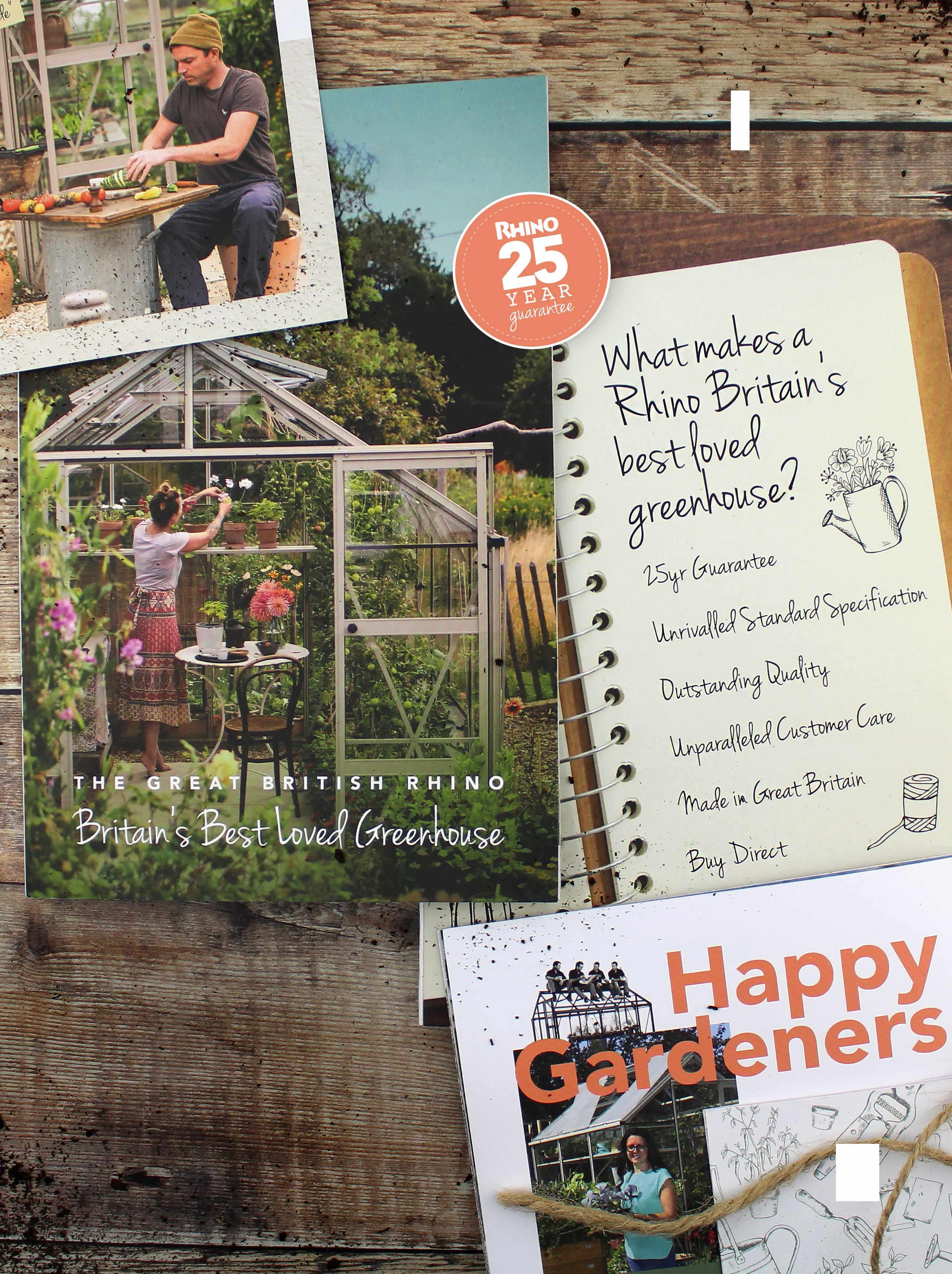
Tom and Sue Stuart-Smith have been gardening together at their home, The Barn at Serge Hill in Hertfordshire, for many years, but their latest project is more ambitious than the lauded gardens and meadows they have already created there. It’s not surprising that he – an internationally famous, award-winning designer –and her – a respected psychotherapist and best-selling author of The Well Gardened Mind – have come up with something as unique and interesting as The Serge Hill Project for Gardening, Creativity and Health.
It’s a multi-faceted idea that encompasses the fascinating concept of a Plant Library, community allotments, an altruistic nursery and a beautiful gathering space in a purpose-built barn. You can find out more about this exciting new venture in our feature this month (page 46), and make sure you sign up to our Events Newsletter online to be among the first to learn about our exclusive reader day there later this year.


Also this issue, we are relishing the bursts of colour that early spring brings, from the bright heathers of Hill Farm (page 34) and long-lasting interest of Dicentra (page 54) to our expert head gardener’s choice of flowers and foliage for February (page 24). We visit Morlas Plants nursery, the best-kept secret in snowdrop circles (page 40); and the garden and studio of Bex Partridge to discover her exquisite dried-flower creations (page 62).
You can top off the delights of early spring by booking your place now for our upcoming 30th anniversary event – see page 10 for more details.



Welcome JASON
INGRAMW
Galanthus nivalis ‘Trudy Spotted’, one of the tiny treasures to be found at Morlas Plants, page 40.
STEPHANIE MAHON, EDITOR
JOHN CAMPBELL
FEBRUARY 2023 GARDENSILLUSTRATED.COM 3 Scan here or visit our website to discover some of the best places throughout the UK to see snowdrops this season gardensillustrated.com/snowdrops Instagram @gardens_illustrated Twitter @GdnsIllustrated Facebook @gardensillustrated
Contents
Places
34 Rising to the challenge In her own steeply sloping garden, designer Helen Thomas chose not to fight the contours, but instead has used heathers and shrubs to accentuate and mimic the movement of the land
40 Collective effort Discover the Shropshire nursery favoured by the snowdrop cognoscenti that is the place to find some of the rarest and most notable Galanthus cultivars
46 A family affair At their home in Hertfordshire, Tom and Sue Stuart-Smith are working together to create a new altruistic project to promote gardening, creativity and health
74 Mix and match An Australian garden that takes inspiration from some of the UK’s greatest gardens, while also combining plants from around the world in a gloriously joyful fashion

Plants
24 Plantsperson’s favourites
In the first of a new series, Åsa Gregers-Warg, head gardener at Beth Chatto’s Plants & Gardens chooses her top ten plants for February
54 Plant profile: Dicentra
Plantsman Jimi Blake recommends the best of these low-maintenance and reliable plants that are perfect for brightening up a shady garden
68 Planting for prosperity Alan Shipp’s National Collection of Hyacinthus orientalis, amassed over 35 years, includes rare treasure among its more than 250 cultivars, including some long believed to be lost
People
33 Gardening talent Meet Ryan Healey, a horticulturist at RHS Garden Bridgewater
52 Who’s who The heritage and landscape consultant Deborah Evans on the challenges of recreating the past
62 Enduring loves Bex Partridge’s exquisite creations ensure the fleeting beauty of flowers, foliage and seedheads is preserved
114 Home truths Columnist Alice Vincent offers up some simple tips for keeping houseplants happy and healthy
Design
83 Design update The latest projects from around the world
86 Open to nature Insight into the design of a natural Californian garden created for two wildlife-loving artists
92 Sourcebook Nine of the best plant display stands
Regulars
3 Welcome
6 Contributors
13 Dig in This month: news of Alice Vincent’s new podcast
19 Kitted out For staying warm 22 Subscription offer Save when you subscribe
the digital edition of Gardens Illustrated
30 The constant gardener Head gardener Benjamin Pope enjoys the calm before the spring rush 103 Books New books that can help you find the best plants for tough places and inspire you to create seasonal flower arrangements
108 Crossword and back issues
113 Next issue What’s coming up in March
FEBRUARY
2023
CLAIRE TAKACS
to
4 GARDENSILLUSTRATED.COM FEBRUARY 2023
Salvia yangi ‘Little Spires’, Agastache ‘Nadine’ and Verbena bonariensis mingle to create a riotous mix of colour in Simon Rickard’s exuberant Australian garden, page 74.
SEE PAGE 22
COV E R I M AGE COVER IMAGE
The Plant Library at Serge Hill by Richard Bloom
ON T H E COV E R THE COVER
Tom Stuart-Smith’s next chapter, page 46 Colour burst, pages 24, 34, 54 and 68
Secret snowdrops, page 40 Lasting love, page 62 Lost treasures, page 68 9 stylish plant stands, page 92
EV E EVE N T S A N D NTS AND OFFE R S OFFERS
• Book your place on our four-day garden tour of Dorset’s most inspiring gardens – page 8

• Join us for a special evening to celebrate 30 years of Gardens Illustrated, in the company of Dan Pearson, Claire Ratinon and Tom Massey – page 10
• Save money when you subscribe to the digital edition of Gardens Illustrated – page 22
• Win a luxury mini-break for two at historic Middlethorpe Hall in York† – page 109
† Competition open only to UK residents.
Our packaging
Subscriber copies of Gardens Illustrated are now delivered in paper wrapping instead of recyclable plastic polywrap. This paper wrap is 100% recyclable and made from sustainably sourced paper. Please recycle in your kerbside recycling bin. We would love to hear your feedback, please contact us at paperwrap@immediate.co.uk
& save
a
to
Subscribe
take out
digital subscription
Gardens Illustrated
01905 381679 / 07930 576881
Contributors

Åsa Gregers-Warg
Åsa begins a new series of seasonal plants picks, page 24. “I enjoy mixing trusted old favourites with newer acquaintances in the garden. Plants never fail to excite and inspire me.”
Jimi shares his passion for dicentras, page 54.
“I’m taking a deep dive into the world of dicentras, and showing how I use them in the shady beds of my Woodland Garden at Hunting Brook.”
Mimi photographs
Alan Shipp’s hyacinth collection, page 68. “A vibrant palette in early spring, depicting a collector’s lifetime of dedication and research, and an extraordinary history.”
CONTRIBUTING EDITORS

James Basson
James lives in the South of France where he runs Scape Design, a practice specialising in low-maintenance and dry gardens. He is a fervent advocate for creating sustainable landscapes. The winner of four Chelsea Gold medals, he was awarded Best in Show in 2017.


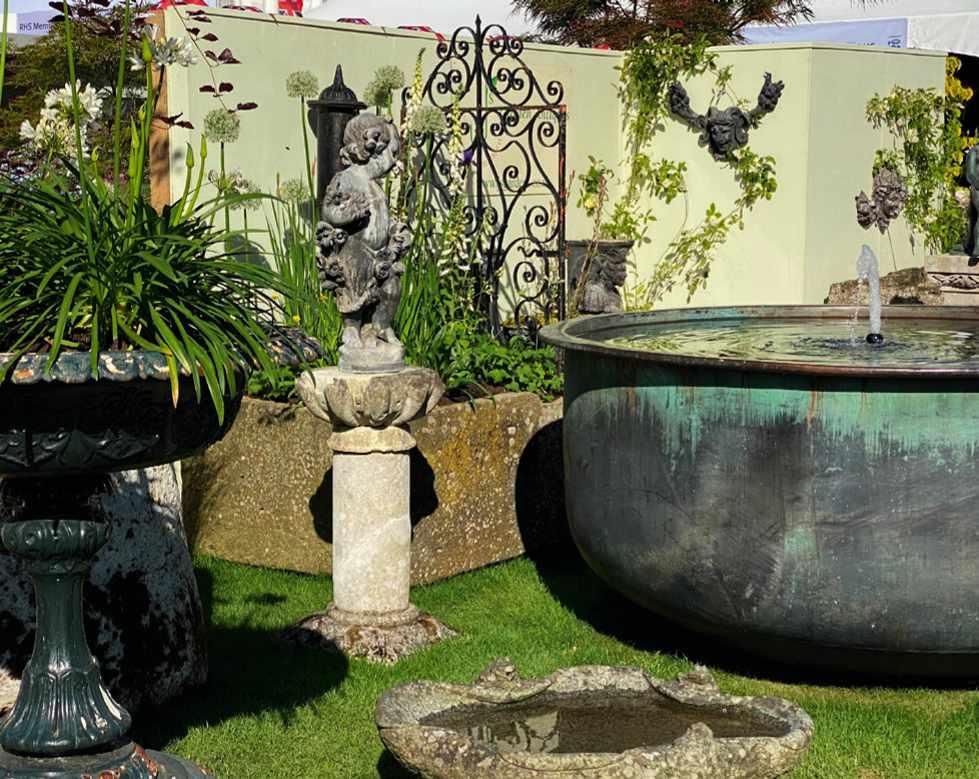
Fergus Garrett
Fergus was appointed head gardener at Great Dixter by Christopher Lloyd in 1993. He is passionate about passing on his knowledge through student programmes at Dixter and worldwide lectures. He was awarded an RHS Associate of Honour in 2008 and an RHS Victoria Medal of Honour in 2019.
Anna Pavord
Anna’s books include her bestseller The Tulip and most recently Landskipping. For 30 years she was The Independent’s gardening correspondent. In 2000 the RHS awarded her the Veitch Memorial Medal. She lives and gardens in Dorset.


Dan Pearson
Dan is one of the UK’s best-known garden designers, familiar to many through his gardening columns in the Observer magazine. Eight of his gardens, including the Tokachi Millennium Forest in Japan, have won awards and he was awarded Best in Show for his garden at Chelsea in 2015.


Sarah Price
Sarah is one of the UK’s most sought-after garden designers who gained worldwide recognition for her designs for the 2012 London Olympic Park. She won Gold at Chelsea in 2012 and 2018, and was GMG Garden Columnist of the Year in 2016 for her design series in Gardens Illustrated



ANDREW MONTGOMERY ANDREW MONTGOMERY
www.jsgardens.co.uk
) � www.poddyandblack.com EU Customers please use www golden-rabbit de
1DWXUDO 5XEEHU *DUGHQ 6KRHV
Mimi Connolly
Jimi Blake
JASON INGRAM
GA R DENS
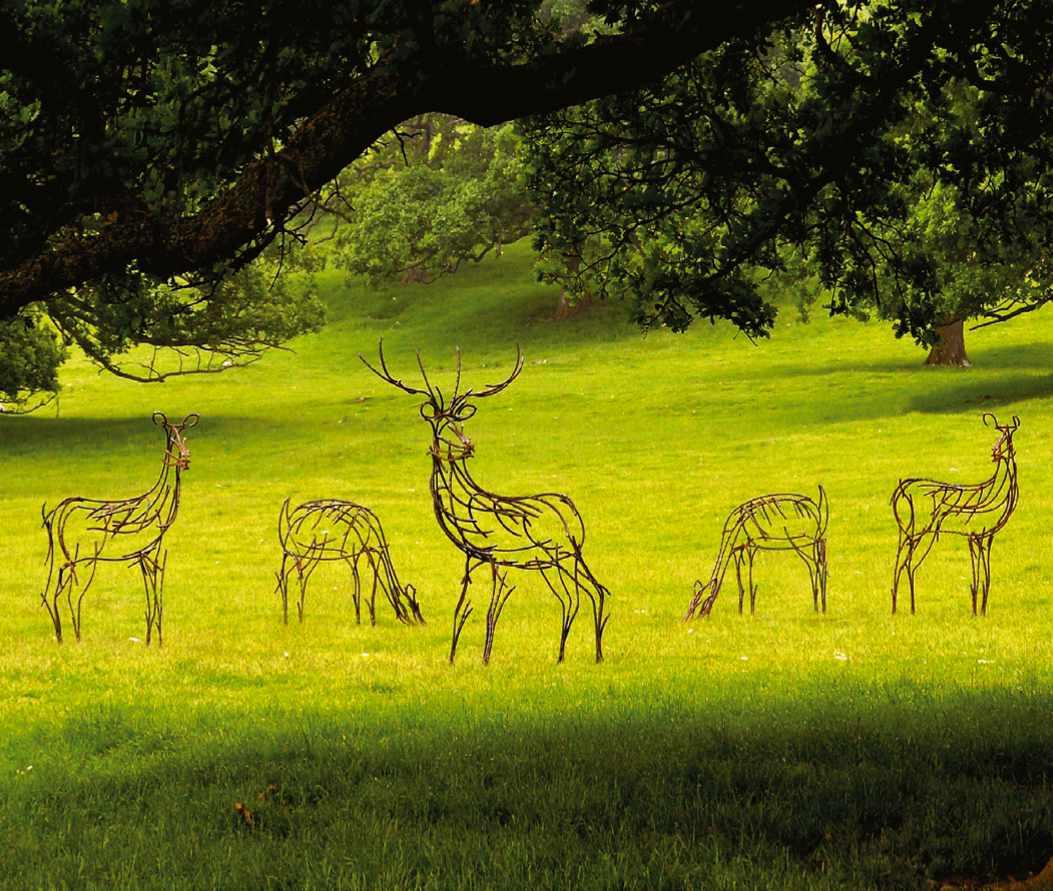
HOW TO GET IN TOUCH WITH US TOUCH
Subscription enquiries and back issues UK 03330 162114

USA/CANADA 1 866 464 8103 (TOLL-FREE) REST OF THE WORLD +44 1604 973722 UK buysubscriptions.com/contact buysubscriptions.com/gardensillustrated
USA/CANADA GILcustserv@cdsfulfillment.com, britsubs.com/garden
UK/REST OF THE WORLD Gardens Illustrated, PO Box 3320, 3 Queensbridge, Northampton NN4 7BF.
USA/CANADA Gardens Illustrated, PO BOX 37495, Boone, IA 50037-0495 USA.
Advertising enquiries
+44 (0)117 300 8805 heather.golden@ourmedia.co.uk
Editorial enquiries
+44 (0)117 300 8622 gardens@gardensillustrated.com
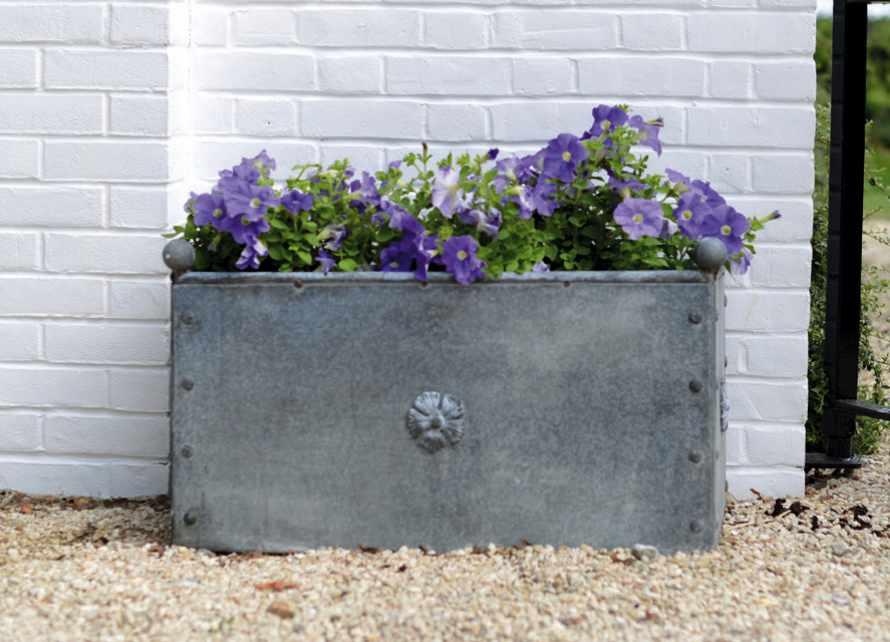
Gardens Illustrated, Our Media Ltd (an Immediate Group Company), Eagle House, Bristol BS1 4ST.
Syndication & Licensing
Gardens Illustrated is available for licensing and syndication. +44 (0)117 300 8787 emma.brunt@ourmedia.co.uk
App support
For App support please visit apps.immediate.co.uk/support
We abide by IPSO’s rules and regulations. To give feedback about our magazines, please visit ourmedia.co.uk, email editorialcomplaints@immediate.co.uk or write to Katherine Conlon, Our Media Ltd (an Immediate Group Company), Eagle House, Bristol BS1 4ST.

MAGAZINE CONTACTS
EDITORIAL
Editor Stephanie Mahon
Deputy editor Sorrel Everton
Art director David Grenham
Deputy art editor Niki Goss
Production editor Juliet Giles
Digital editor Daisy Bowie-Sell
Commissioning content editor Veronica Peerless
Editorial and digital assistant Molly Blair
Botanical adviser Dr James Compton
Thanks this issue Matt Bishop, Abigail Whyte
ADVERTISING
Group advertising manager Laura Jones 0117 300 8509 laura.jones@ourmedia.co.uk

Portfolio advertising manager Heather Golden 0117 300 8805 heather.golden@ourmedia.co.uk
Senior brand sales executive Mia Dorrington 0117 300 8266 mia.dorrington@ourmedia.co.uk
Brand sales executive Mica Enwright 0117 300 8756 mica.enwright@ourmedia.co.uk
Advertising designer Parvin Sepehr
INSERTS
Laurence Robertson +353 (0)876 902208
CIRCULATION, MARKETING, PROMOTIONS, PRESS & PR
Newstrade manager John Lawton
Subscriptions director Jacky Perales-Morris
Direct marketing manager Aimee Rhymer
Buyer Karen Flannigan
PR & Outreach Manager for Comms Emma Cooney emma.cooney@ourmedia.co.uk
MANAGEMENT
Chief executive officer Tom Bureau
Group managing director Our Media Andy Marshall
Managing director Our Media Marie Davies
Head of brand marketing Rosa Sherwood
SYNDICATION & LICENSING
Director of licensing & syndication Tim Hudson
PRODUCTION
Production director Sarah Powell
Group production manager Louisa Molter
Senior production co-ordinator Katty Skardon
Jan-Dec 2021 49,146* *Combined print and digital sales www.andrewkaysculpture.co.uk 07740 306412 Free UK delivery LIFE SIZE ANIMAL SCULPTURE
Standard subscription rates: UK £64.87 per annum; Eire and Europe �79 for 13 issues; rest of the world US$112 for 13 issues. Distribution Frontline, Peterborough. US distribution Source IPD/Speedimpex. Email intlquery@seymour.co.uk. Printed in the UK by William Gibbons Ltd. Gardens Illustrated (ISSN 0968-8920) (USPS 015-608) is published 13 times a year (monthly with a Summer issue in June) by Our Media Ltd (an Immediate Group Company), Eagle House, Bristol BS1 4ST, UK. Distributed in the USA by NPS Media Group, 2 Corporate Drive, Ste. 945, Shelton, CT 06484. Periodical postage paid at Shelton, CT and additional mailing offices. POSTMASTER: Send address changes to Gardens Illustrated PO Box 37495, Boone, IA 50037-0495. Unsolicited manuscripts or artwork are accepted on the understanding that the publishers incur no liability for their storage or return. The contents of this magazine are fully protected by copyright and may not be reproduced without permission. The Gardens Illustrated cover is printed on 250gsm FSC Amadeus produced in Belgium by Burgo. The Immediate Media Company Limited is working to ensure that all of its paper is sourced from well-managed forests. This magazine can be recycled for use in newspapers and packaging. Please remove any gifts, samples or wrapping and dispose of it at your local collection point. All prices are correct at time of going to press. © Our Media Ltd (an Immediate Group Company) 2023. Member of the Audit Bureau of Circulation. ISSN 0968-8920.
THIS MAGAZ NE IS OWNED MAGAZINE AND PUBLISHED BY
New Dorset Gardens
Join us on a four-day garden tour, hosted by innovative gardener Keith Wiley, to explore some of Dorset’s most inspiring gardens of renown

From fossil-stacked cliffs to rolling chalk hills and rich pastures, the rural county of Dorset has inspired countless creatives, both historic and contemporary. With expert plantsman Keith Wiley as your host, the tour highlights some lesser-known gardens, including the garden at The Old Rectory at Litton Cheney, designed in part by Arne Maynard, and the richly planted garden at Upper Sydling House, originally laid out by the Bannermans. Other gardens are more historic, including the walled kitchen garden at Pugin Hall, which was designed by Victorian architect Augustus Pugin, and Chideock Manor, a Regency manor surrounded by varied gardens including a parterre and rose arches. We visit River Cottage HQ, the creation of Hugh Fearnley-Whittingstall and his knowledgeable team, for a tour of the productive ‘no-dig’ walled garden before sitting down to a delicious home-grown lunch. There’s the chance to peruse the plants at Charles Chesshire’s Rare & Special Plant Nursery, which includes a range of clematis, hydrangeas and intersectional peonies. Your hotel for the tour is 5-star Georgian Summer Lodge Country House Hotel in the heart of Thomas Hardy’s Wessex.
3 6 JULY 2023
EVENT DETAILS
Price per person, based on two people sharing, is £3,500 (a single supplement of £400 is levied by the hotel).
The price includes transportation from Yeovil Junction railway station, three nights’ bed and breakfast in the four-star Summer Lodge Country House Hotel, Dorchester, and three evening meals with wine at the hotel, plus four lunches. Please note that Boxwood Tours uses hotels of character featuring a variety of rooms and styles. The price does not include extras at the hotel, or travel insurance. For more details and for an in-depth itinerary with details of day-to-day visits, meals, etc, please contact Boxwood Tours.
FOR INFORMATION AND BOOKING, PLEASE CONTACT
Boxwood Tours, 1 West Street, Buckingham HK18 1HL, UK. Tel +44 (0)1341 241717. Email mail@boxwoodtours.co.uk Website boxwoodtours.co.uk
The tour has been arranged exclusively for readers of Gardens Illustrated by Boxwood Tours Quality Garden Holidays, a specialist garden tour company set up in 1990. Please note that itineraries may be subject to change for reasons beyond Gardens Illustrated’s control. The tour is financially protected by the ATOL scheme. Please see booking conditions for further information or for more information about financial protection and the ATOL Certificate go to: arenatravel.com/why-arena/financial-protection
WILLIAM
COLLINSON, JASON INGRAM, CHARLIE HOPKINSON
8 GARDENSILLUSTRATED.COM FEBRUARY 2023
Keith Wiley was head gardener for 14 years at The Garden House, a ten-acre garden on the edge of Dartmoor, before moving to his garden Wildside, where he has created one of Britain’s most innovative gardens.
Upper Sydling House, Up Sydling.
The Old Rectory, Litton Cheney.
TOUR GI Reader


Our gardens: past, present and future
To celebrate 30 years of Gardens Illustrated, join us for a special evening of conversation and insight with some of the leading lights of modern horticulture and garden design
Our 30th anniversary event will feature a live panel discussion, hosted by Gardens Illustrated editor Stephanie Mahon, looking at the ways our gardens and gardening have changed over the past three decades, the most pressing issues we face now and what the future of horticulture may hold.
Our panel
Dan Pearson OBE
is one of the world’s most lauded landscape designers, who has been creating beautiful, naturalistic spaces since 1987. His projects include the Tokachi Millennium Forest in Japan and Lowther Castle in Cumbria. He is a contributing editor of Gardens Illustrated and writes, lectures and broadcasts regularly. His 2015 show garden for Chatsworth and Laurent-Perrier was awarded a Gold Medal and Best Show Garden at the RHS Chelsea Flower Show.


Claire Ratinon is an organic food grower, author, speaker and radio presenter. She worked in TV production before changing career to grow produce for restaurants and give workshops to school children and community groups. Her book Unearthed: On Race and Roots, and How the Soil Taught Me I Belong was published in June 2022, and her pamphlet Horticultural Appropriation: Why Horticulture Needs Decolonising was published in April 2021.

Tom Massey studied at the London College of Garden Design before founding his studio in 2015. He has created several award-winning show gardens including the Yeo Valley Organic Garden for The RHS Chelsea Flower Show 2021, which won Gold and the BBC People’s Choice Award. He will be creating a new design for the 2023 show for the Royal Entomological Society. His first book, RHS Resilient Garden: Sustainable Gardening for a Changing Climate, will be released in April.
Limited tickets BOOK NOW
Date Thursday 23 March 2023, 7pm
Attend in person at Eagle House, Bristol Tickets £55 including welcome drinks, canapés and a goodie bag


Or via live stream online Tickets £15
Sponsored by Hattingley Valley Wines –eco-friendly English sparkling wines made in Hampshire






10 GARDENSILLUSTRATED.COM FEBRUARY
2023
Scan to book or visit our website
gardensillustrated.com/gardens-illustrated-events/
EXCLUSIVE EVENT
ANDREW MONTGOMERY BRITT WILLOUGHBY DYER
HUW MORGAN
TIMELESS CLOTHING & EQUIPMENT TO CARRY YOU THROUGH THE SEASONS carriercompany.co.uk always made in the uk
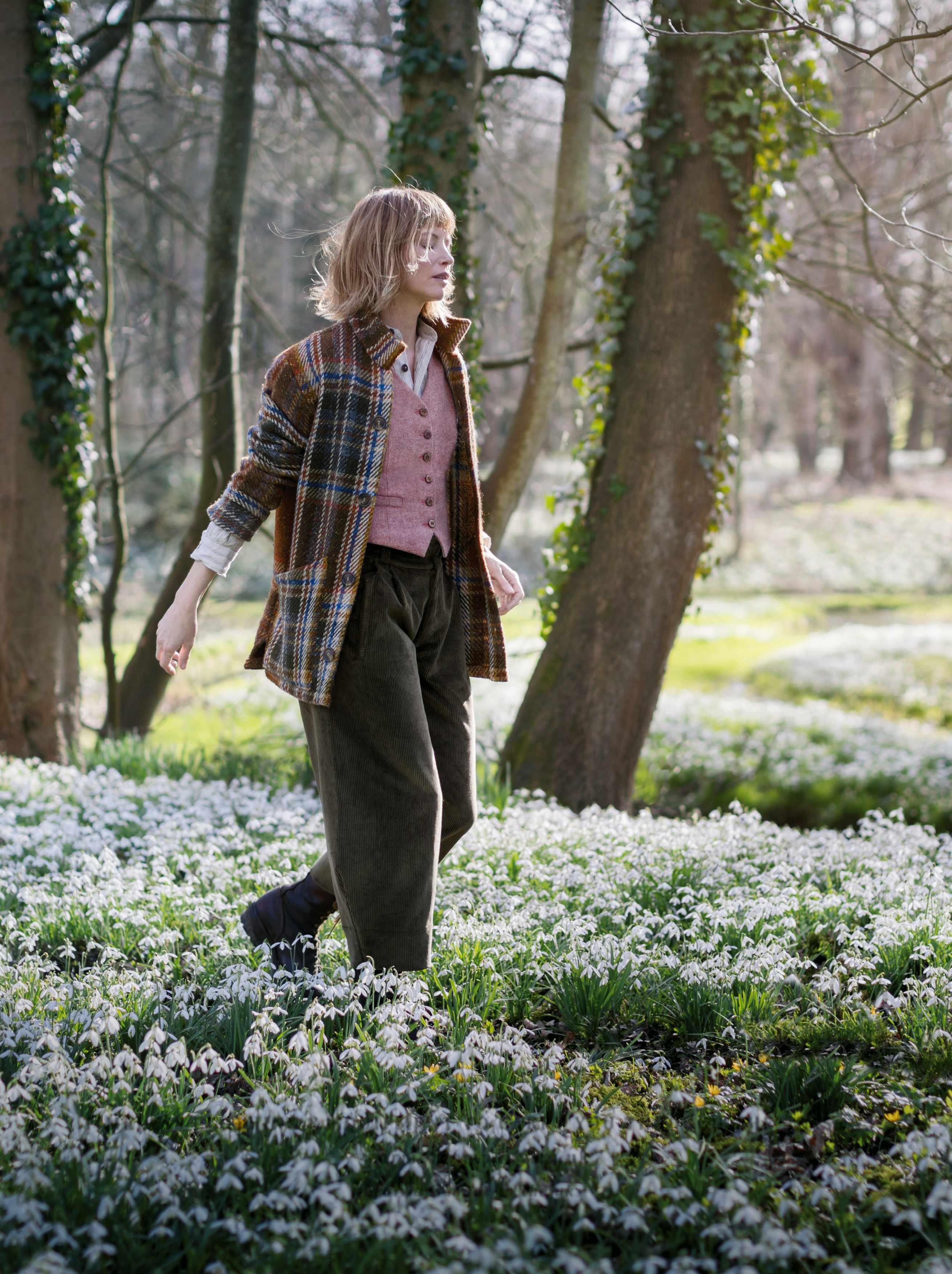 Photographed by Richard Allenby-Pratt at Walsingham Abbey
Photographed by Richard Allenby-Pratt at Walsingham Abbey
LOVINGLY H ANDMADE HERE IN BRITAIN

DIG IN
What’s new, what’s growing and what’s going on this month
Look who’s talking
For her new book Why Women Grow (published 2 March), Gardens Illustrated columnist Alice Vincent has been speaking to inspirational women to find out why they garden and how their relationship with the natural world has informed their lives and careers. This month there’s a chance to eavesdrop on some of her conversations in a fascinating new seven-part podcast series of the same name. Recorded in gardens from Totnes to Norfolk, the far-ranging chats touch on motherhood, grief, identity, saving the planet, and, of course, gardening. You can listen to the first two episodes – with gardeners Claire Ratinon and Sarah Raven – on 13 February, and future episodes will feature food writer Rukmini Iyer, novelist Salley Vickers, gardener Poppy Okocha, clothing designer Margaret Howell and social media influencer Paula Sutton. Episodes drop weekly, and you can subscribe to it on all major podcast platforms.
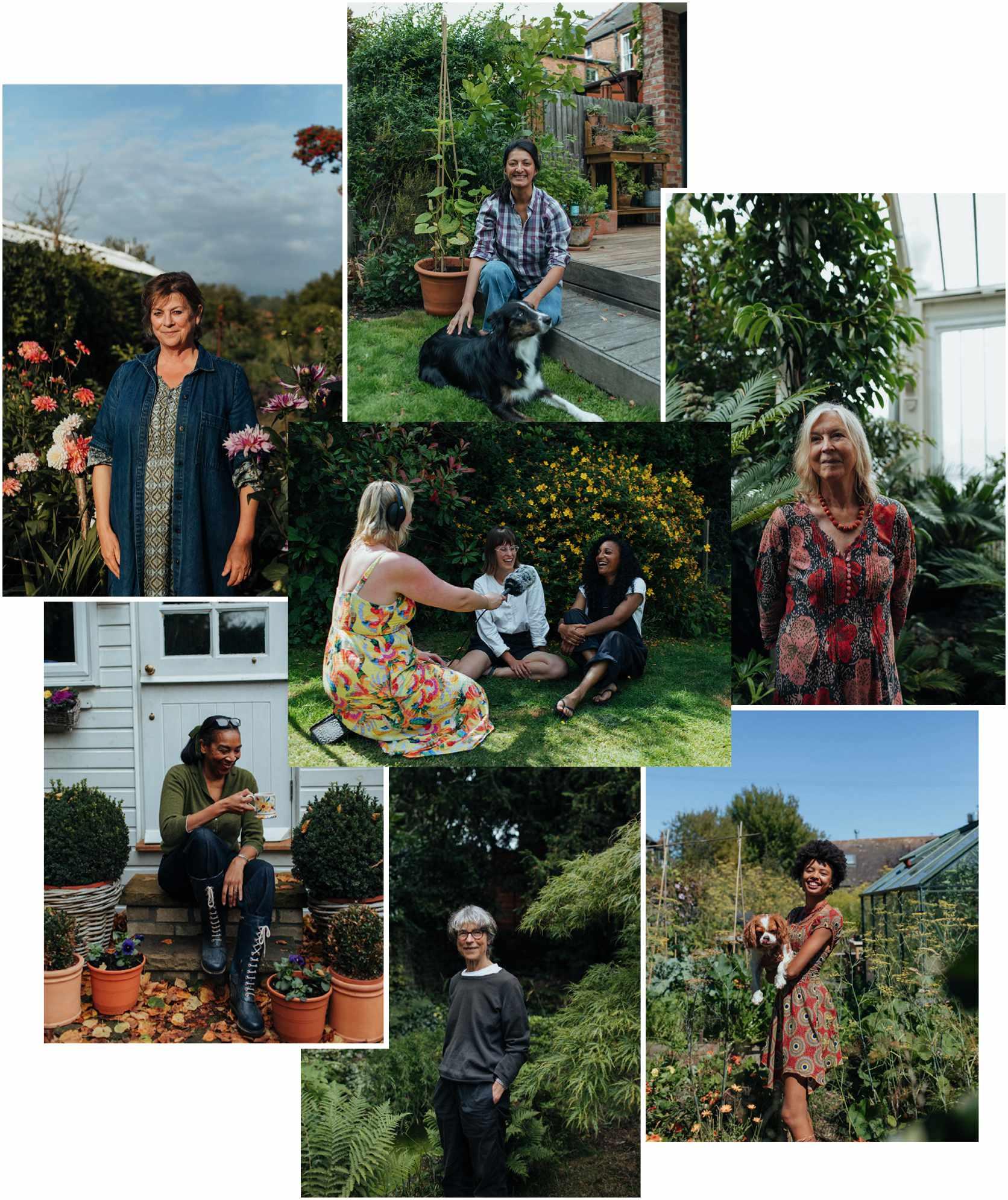
FEBRUARY 2023 GARDENSILLUSTRATED.COM 13
SIOBHAN WATTS
News
COMPILED BY MOLLY BLAIR
Write away
LATE SUMMER BLOOM
Dahlia, a new fabric pattern from designer and print maker Molly Mahon, is a glorious celebration of the late-summer favourite in all its fabulous colour. Available in four colourways (shown here in Peach/Sap Green), Dahlia is one of five patterns in Molly’s new Bloom collection of block-printed fabrics that also includes bold stripes and checks. Dahlia is priced at £196 a metre, with prices for other patterns in the collection starting at £185 a metre. mollymahon.com

If one of your New Year resolutions is to nurture your creativity, then a residential course this spring could be the push you need to get started. Founded by Gardens Illustrated contributor and wild florist Charlie Ryrie, the Little Writing School in Dorset (pictured below) has two new workshops – Nature and Story with Anna Wilson (16-22 April) and Garden Writing with Noel Kingsbury (23-25 May) – that are perfect if you want to explore new ways to describe the natural world. Further west, a weekend retreat (28-30 April) celebrates the Celtic spring festival of Beltane with a host of activities from writing and drawing to wild swimming, designed to get the creative juices flowing. Held in the former home of artist Romi Behrens at Prussia Cove in Cornwall, activities will be guided by floral artists Joanna Game and Bex Partridge (see feature on page 62), flower grower Grace Alexander and garden photographer Britt Willoughby Dyer. Find out more about the writing courses at thelittlewritingschool.co.uk and follow @joannagame_flowers on Instagram for full details of the Beltane retreat.

Sustainable build
Online design magazine Dezeen has named the K-Briq as its Sustainable Design of the Year for 2022. Made from 90 per cent recycled construction waste, the brick has been designed and manufactured by Scottish company Kenoteq, a spin-out from Heriot-Watt University in Edinburgh, using a low-carbon process that does not require high-temperature firing, virgin cement or high volumes of clay. The K-Briq comes in 13 stock colours, all made from recycled pigments, so you are sure to find one to fit in with your hard-landscaping scheme. Kenoteq hopes to deliver three million bricks in 2023. kenoteq.com; dezeen.com

14 GARDENSILLUSTRATED.COM FEBRUARY 2023
Beyond the sea
RHS Garden Wisley’s annual houseplant takeover returns this month packed with quirky ideas of how to display your indoor plants. This year’s exhibition, Deep Sea Dive, has a maritime theme and will feature a boat suspended from the Temperate Terrace as well as artefacts on loan from the Charlestown Shipwreck Treasure Museum in Cornwall. 4 February – 12 March, admission included in general garden entry of £15.95. rhs.org.uk
BRIGHT IDEAS
3 FOR THE GARDEN… FLOWER PRESSES
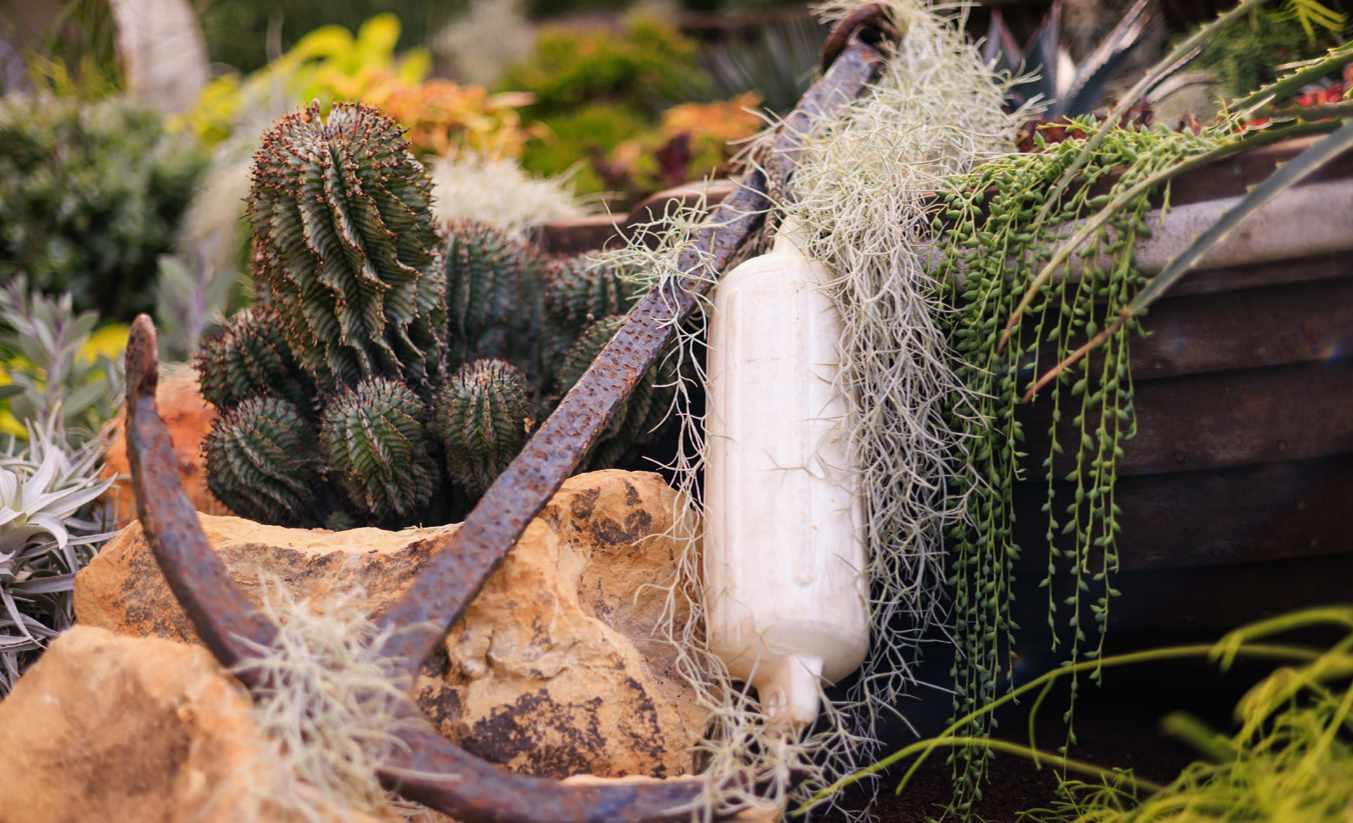

COMPACT Flower Press, £6.99, CJ Wildlife, 0800 731 2820, birdfood.co.uk



RIOT OF WHITE
From white-carpeted woodlands to small private gardens, there are more than 100 spaces opening as part of this month’s National Garden Scheme Snowdrop Festival (1-28 February). Among those welcoming galanthophiles and the snowdrop curious are Copton Ash in Kent, Higher Cherubeer in Devon and Pembury House in East Sussex, all of which are owned by snowdrop experts. So, whether you’re looking for swathes of naturalised Galanthus nivalis or want to get up close and personal with tiny, rare cultivars, you can find the perfect garden at ngs.org.uk
Sense of history
Chiltern Seeds has added a range of new annuals to its catalogue for 2023. Among the new introductions are Cosmos bipinnatus ‘Kiiro’ (shown below), which boasts soft-yellow blooms that are occasionally tinted with peach, and Lathyrus odoratus ‘Kingfisher’, a pale-purple and cream sweet pea with a citrussy scent. Both can be sown indoors now, and come summer will keep a home full of abundant cut flowers for many months. Find out more about these and other summer blooms at chilternseeds.co.uk
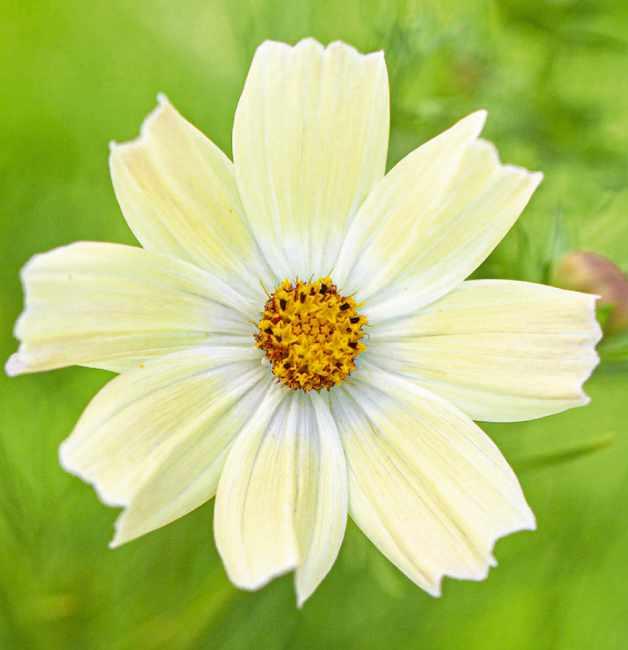
STURDY Flower Press, £42, Toast, 0333 400 5200, toa.st
Wentworth Woodhouse, a country house set in 50 acres of private gardens in South Yorkshire, has won the prestigious Historic Houses Garden of the Year Award for 2022, while the beautiful Cotswold garden of Upton Wold, with its herbaceous borders, pond garden and fountains, won the Judges’ Choice award. wentworthwoodhouse.org.uk; uptonwold.co.uk
BOUQUET
Sarah Raven Giant Flower Press, £27.95, Sarah Raven, 0345 092 0283, sarahraven.com
Discover a wider range of flower presses by scanning this QR code with your phone camera, or visit gardensillustrated.com
/flowerpresses

FEBRUARY 2023 GARDENSILLUSTRATED.COM 15
LEIGH CLAPP
RHS / OLIVER DIXON
DIARY: FEBRUARY
Catch the vibrant new exhibition by London-based artist Lakwena Maciver at Yorkshire Sculpture Park. Her bold, colour-soaked new paintings and textile works have in part been inspired by YSP’s verdant landscape, an Eden-like place that was once the preserve of wealthy landowners but is now openly accessible to a diverse audience. Until 19 March, Tuesday – Sunday, 10am-4pm. £6. The Weston Gallery, Yorkshire Sculpture Park, West Bretton, Wakefield, West Yorkshire WF4 4LG. Tel 01924 832631, ysp.org.uk
2 Terrariums: Success with Succulents
Learn how to make your own glass terrarium using a selection of plants, stones, shells, sand and gravel, on one of two workshops led by horticulturist Sue Jeffries. 4 February, 10.30am12pm or 1-2.30pm. £45. RHS Garden Bridgewater, Occupation Road, Off Leigh Road, Worsley, Salford, Greater Manchester M28 2LJ. Tel 0161 503 6100, rhs.org.uk
3 Orchid Festival
The annual Orchid Festival returns to the Royal Botanic Gardens, Kew, this month with an exhibition that celebrates the biodiversity of Cameroon. Expect horticultural displays and living plant sculptures throughout the Princess of Wales Conservatory. 4 February –5 March, 10am-5pm (6pm from 1 March). Admission included in garden entry. Royal Botanic Gardens, Kew, Richmond, London TW9 3AE. Tel 020 8332 5655, kew.org
4 Snowdrop Weekends
Blow away winter blues with a stroll among carpets of snowdrops at Logan Botanic Garden in southwest Scotland. 5-26 February, weekends only, 10am- 4pm. Entry by donation. Logan Botanic Garden, Port Logan, Stranraer DG9 9ND. Tel 01776 860231, rbge.org.uk
5 Garden Design Drawing Skills
Hone your drawing techniques on this one-day course led by Andrew Wilson, director of the London College of Garden Design, to help you improve this essential skill for successful garden design. 10 February, 10.30am-4pm. £105. RHS Garden Wisley, Wisley Lane, Woking, Surrey GU23 6QB. rhs.org.uk
6 Introduction to Creating a Cutting Garden
Learn how to sow seeds, support plants and care for them, and how to create natural displays on this one-day course from Plumpton College. 10 February, 10am-4pm. £75.

One Garden Brighton, Stanmer Park, Lewes Road, Brighton, East Sussex BN1 9SE. Tel 01273 892034, onegardenbrighton.com
7 Sustainable London and the Energy Garden
Discover how the greening of 30 London Overground stations has been achieved by joining this online talk by Agamemnon Otero, director of The Energy Garden, for London Parks and Gardens. 14 February, 6-7pm. £5. londongardenstrust.org
8 Peckham Grown & Thrown: Plants and Ceramics Market
Find a wide range of houseplants, alongside handmade pots and vases from talented ceramicists at this pop-up market organised by Green Rooms Market in collaboration with the Independent Ceramics market. 19 February, 11am-5pm. £1. Unit 8, Copeland Park, 133 Copeland Road, London SE15 3SN. greenroomsmarket.com
9 Willow Garden Structures Workshop
Learn how to create your own beautiful and unique garden structures using natural willow stems on this one-day course with weaving expert Helen Lomberg. 25 February, 10am-4.30pm. £115. Waterperry Gardens, nr Wheatley, Oxfordshire OX33 1JZ. Tel 01844 339254, waterperrygardens.co.uk
10 Silent Earth: Saving our Insects
Book now for this talk by Professor Dave Goulson, author of A Sting in the Tale, which is part of the Winter Lecture series from the Oxford Botanic Garden. 2 March, 7-8pm. £15.
Lecture Theatre 1, Maths Institute, Andrew Wiles Building, Radcliffe Observatory Quarter, Woodstock Road, Oxford OX2 6GG. obga.oex.ac.uk
9
All information is correct at time of going to press, but may be subject to change. Tickets for events may be limited and may have to be booked in advance. 6 2 5 8
16 GARDENSILLUSTRATED.COM FEBRUARY 2023
3 RBG KEW
PEACH PHOTO DIG IN EVENTS
RHS JOANNA KOSSAK
1 A Green and Pleasant Land (HA-HA)
COMPILED BY MOLLY BLAIR AND ANNIE GATTI
JOANNA KOSSAK
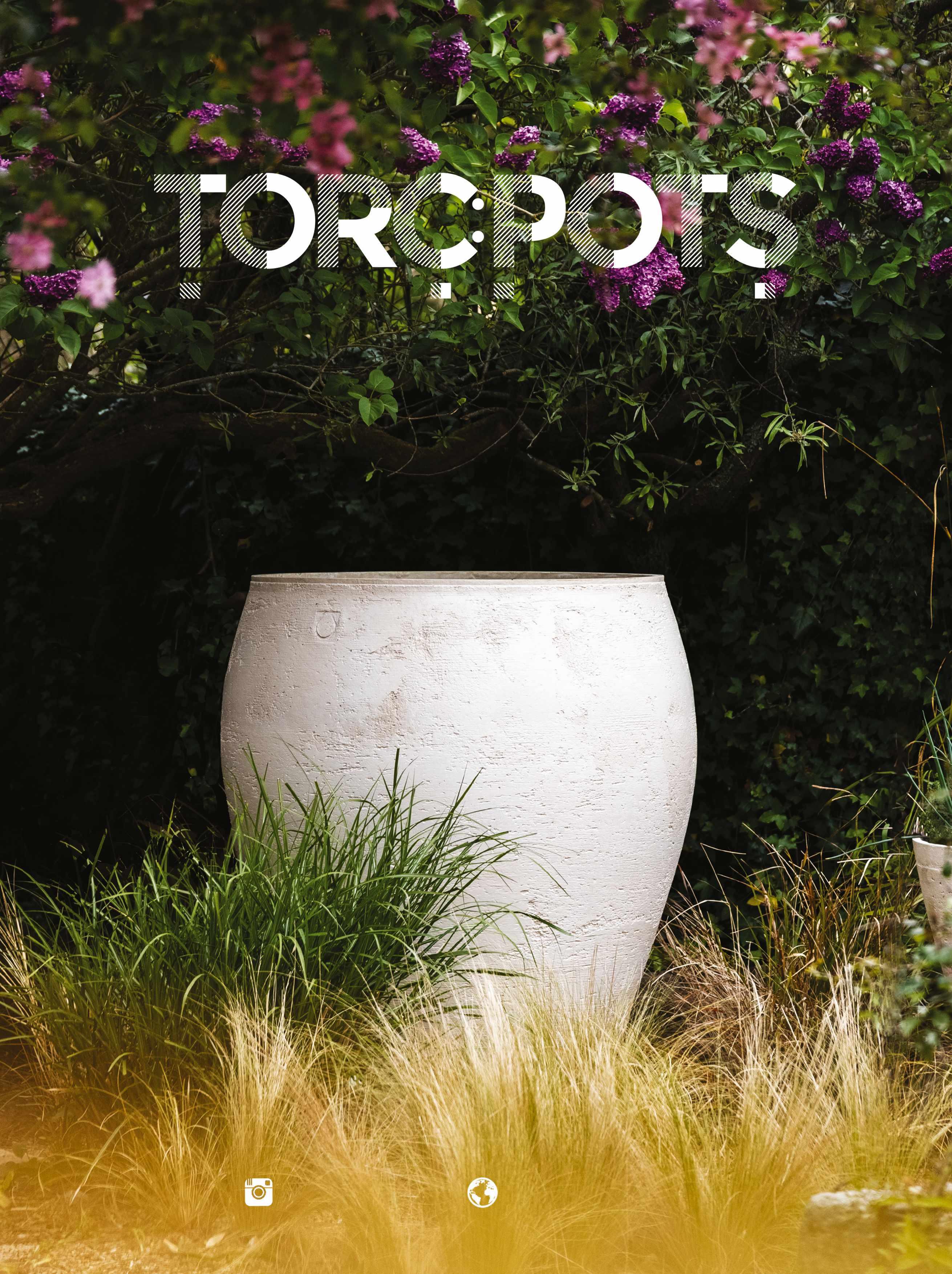
@torc pots www.torcpots.com
MR FOX’S GARDEN
Handmade Garden Art and Decor
The perfect Gifts for Gardeners

We offer a beautiful selection of metal artwork, which is designed and hand crafted by us, in Devon. Our work is natural and rustic which adds interest and structure to your garden, during the cold and long winter months.
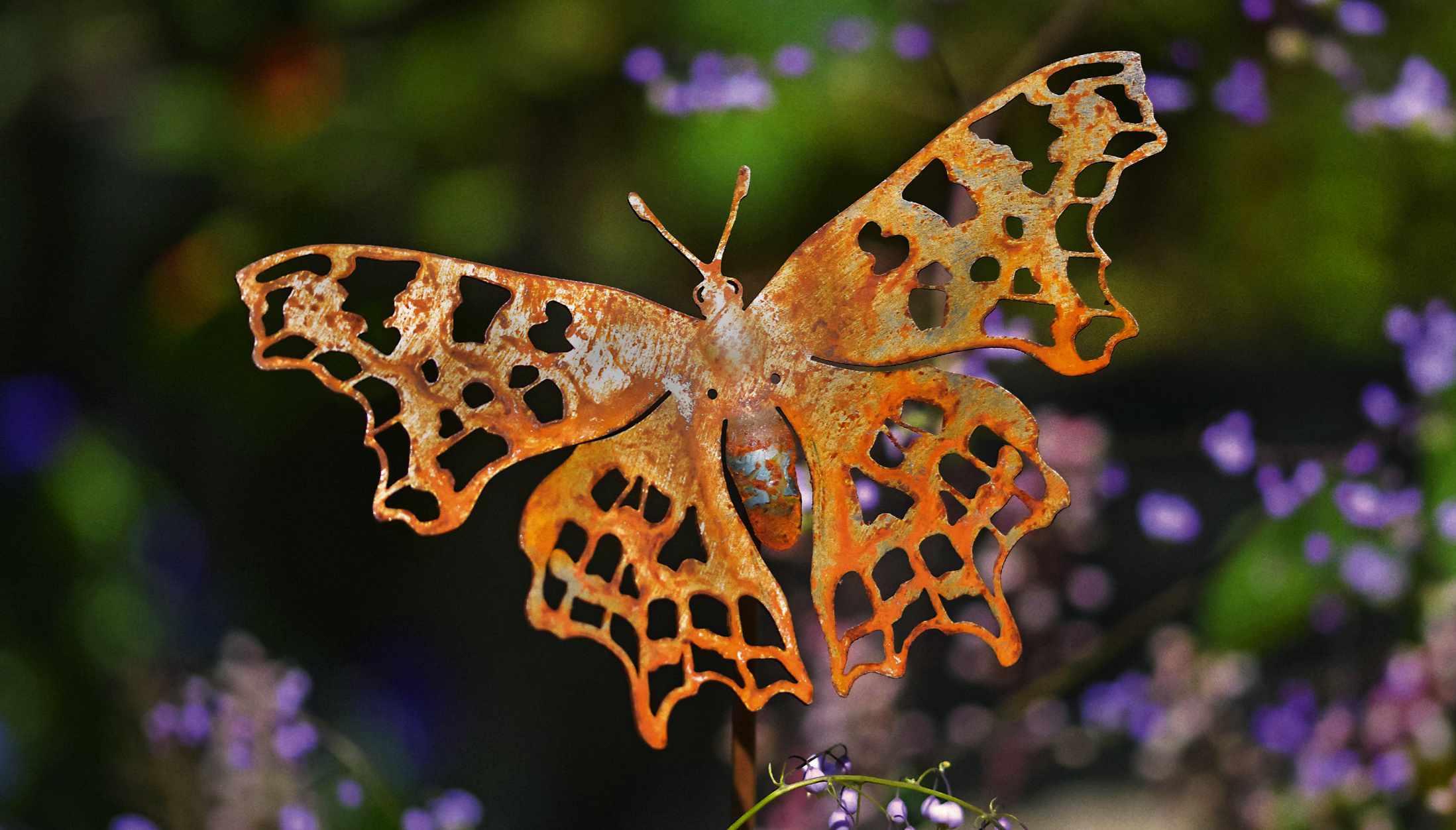
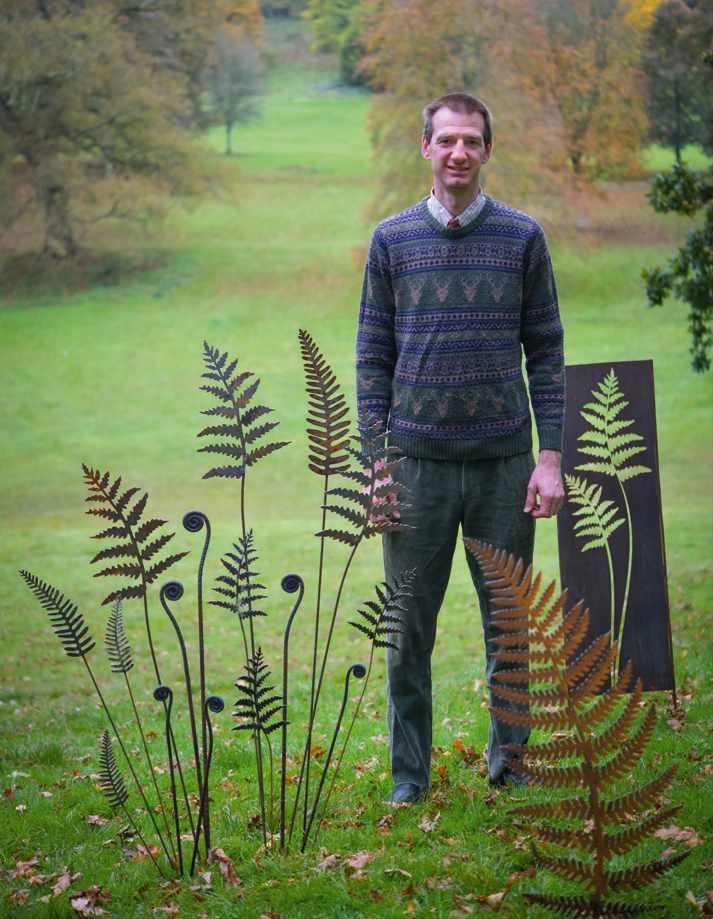
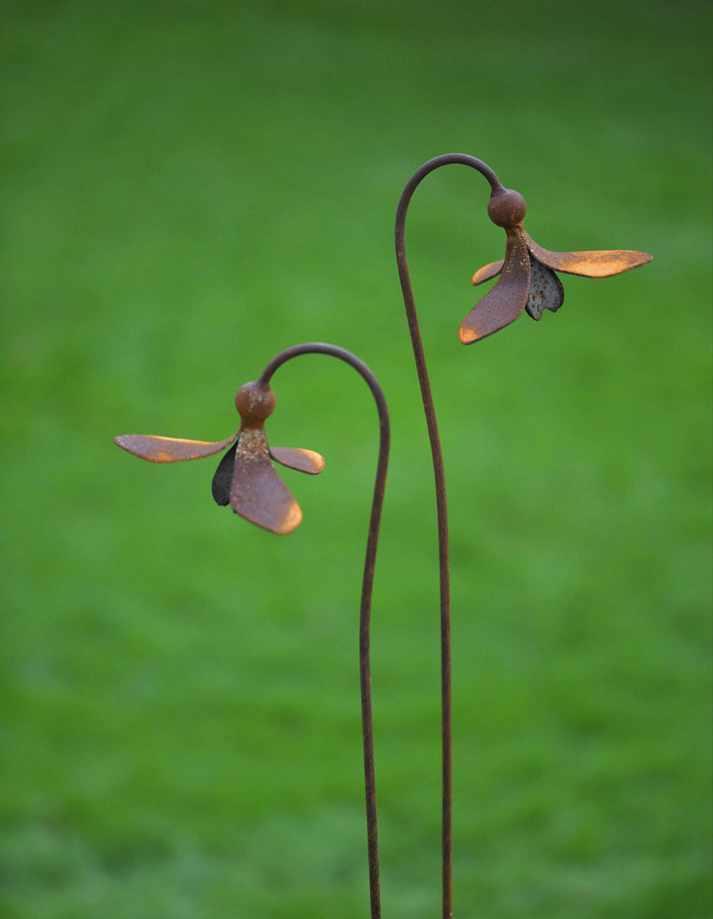
Order online or give us a call at: mrfoxsgarden.com
01803 612370
|
KITTED OUT
For keeping warm and cosy outdoors this season


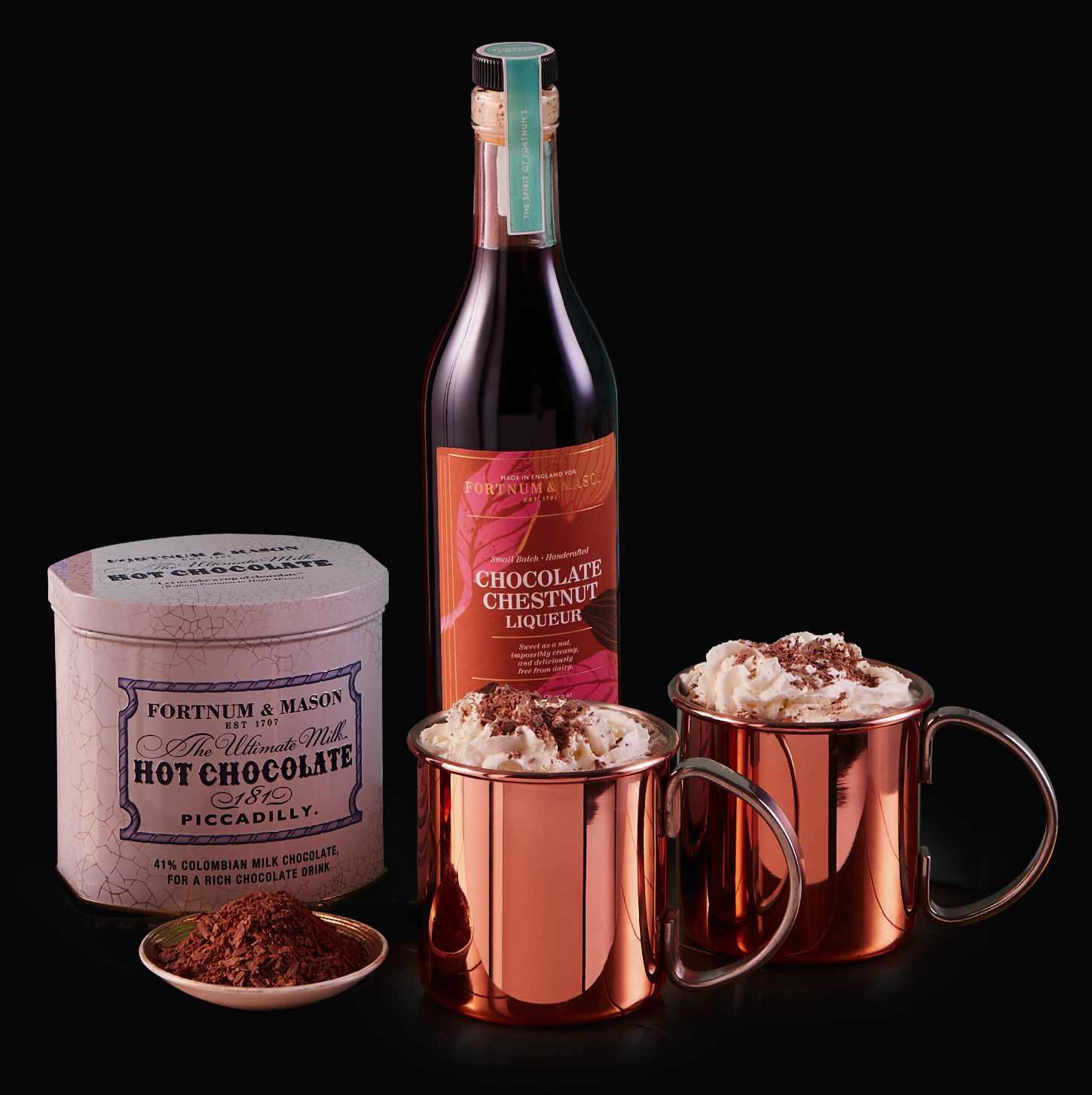 COMPILED BY MOLLY BLAIR
COMPILED BY MOLLY BLAIR
FEBRUARY 2023 GARDENSILLUSTRATED.COM 19
DIG IN SHOPPING
2 3 4 5 1 6
1. Fortnum & Mason Tipsy Hot Chocolate Gift Box, includes ultimate milk hot chocolate, chocolate chestnut liqueur and two copper mugs, £100, shop.afternoontea.co.uk 2. Wylding Moss Green, microfleece-lined weatherproof jumpsuit, £160, wylding.co.uk 3. Outdoor Wood Burning Fireplace With Chimney, W74cm x D48cm x H112cm, £449.99, 01276 535641, gardenesque.co.uk 4. Barbour Sandbay Quilted Trapper Hat, olive, £37.95, 0800 917 3000, barbour.com 5. Outsunny Wooden Cold Frame, W80cm x D47cm x H138cm, £111.99, 0333 103 6677, robertdyas.co.uk 6. Mora Knit Cardigan, cedar, 100% Merino wool, £115, 01872 554481, finisterre.com







20 GARDENSILLUSTRATED.COM FEBRUARY 2023 DIG IN SHOPPING 2 5 4 3 6 8 7 9 1
1. Norse Hand Salve, 85g tin, £15, norselifestyle.com 2. Versatile Jersey Roll, neck warmer, light brown, £12, 020 3752 5360, whitestuff.com 3. Tretorn Faux-FurLined Rain Boots, black, £85, 020 3758 9222, thewhitecompany.com 4. Rowan and Beech Red Wildweave Throw, 160cm x 180cm, £72.99, 0117 441 4412, thebritishblanketcompany.com 5. Sheep’s Wool Garden Fleece, 5m x 1.7m, £4.99, 01900 269427, chimneysheep.co.uk 6. Rechargeable Handwarmer, £27, 020 3617 1166, genus.gs 7. Explorer Bottle, orange, 650ml, vacuum insulated stainless steel, keeps hot 12 hours, £29.95, 020 7633 0022, black-blum.com 8. ThermoHands Thermo Gloves, £49.90, thermohands.co.uk 9. Korson Cable Sock, ecru, £18, 01872 554481, finisterre.com
WESTLAND LONDON


IN
TUBE: WILLESDEN GREEN (JUBILEE LINE) www westlandlondon com 295 WILLESDEN LANE, LONDON, NW2 5HY
SPECIALISTS
ANTIQUE FIREPLACES & FINE ANTIQUES SINCE 1969
GA R DENS

when you subscribe
digital
Save
to the
edition




A must-have read for passionate gardeners, Gardens Illustrated magazine provides a unique insight into the world’s most beautiful gardens, expert advice and planting ideas. ENJOY OUR PREMIUM APP EXPERIENCE NOW buysubscriptions.com/ gardensillustrated
HEDERA HELIX ‘ARBORESCENS VARIEGATA’

This handsome, shrubby, non-climbing ivy, which was planted by Beth many years ago in our woodland beneath a canopy of oaks, grows to little more than a metre. It makes a fine feature in the winter garden where its attractive, evergreen, creamy-edged foliage can be appreciated and used to brighten up a dark corner. It slowly forms a loose, bulky mound, which can be kept in shape by pruning in early spring. Ivy is an important source of nectar for insects in autumn, while also providing shelter. Propagate by semi-hardwood cuttings from mature growth in summer.
Height and spread 1.5m x 1.2m.
Origin Throughout Europe to Turkey.
Conditions Any fertile soil; sun or shade.
Hardiness RHS H6, USDA 5a-9b†
Season of interest Year round.
February plants
In the first of a new series, Åsa Gregers-Warg of Beth Chatto’s Plants & Gardens in Essex prioritises plants with dramatic winter foliage and early flowers
PHOTOGRAPHS RICHARD BLOOM

ABELIOPHYLLUM DISTICHUM
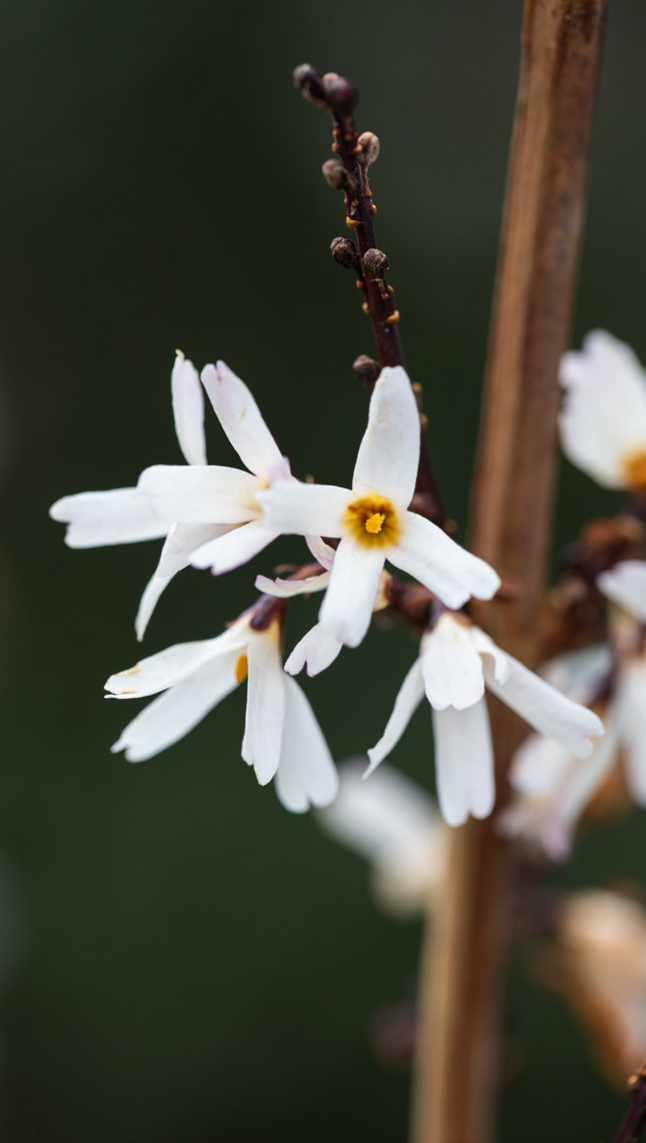
This enchanting white forsythia is one of the first harbingers of spring, producing a profusion of small, white, star-shaped flowers, tinged faintly pink as they open on bare stems. I wish I had thought to place it against a darker backdrop to show off its pale flowers better. It has sweetly scented flowers, though in my experience the perfume is much more pronounced indoors. It benefits from being pruned immediately after flowering, as its open, spreading habit, with arching shoots, can make it look straggly. Also works well trained against a wall.
Height and spread 1.5m x 1.5m. Origin Korea.
Conditions Tolerates most well-drained soils, but dislikes drought; likes a sunny, sheltered spot, away from cold winds.
Hardiness RHS H6, USDA 5a-8b. Season of interest February – March.
DIANELLA TASMANICA BLAZE �= ‘NPW2’�
A fabulous foliage plant, which I acquired a few years ago from the Dutch nursery Tuingoed Foltz, at one of Great Dixter’s plant fairs. I was somewhat doubtful it would survive the UK winters, being an Australian native, but it has proved tough, exceeding all my expectations. We grow it in a raised bed with good drainage where its dark, strap-like leaves contrast well with the silvery foliage of Helichrysum and Erodium. Beautiful, blue flowers with yellow stamens emerge from nearly black buds. Deep-purple foliage for most of the year, turning greener in hot summers.
Height and spread 50cm x 50cm. Origin Australia.
Conditions Well-drained soil; full sun. Hardiness RHS H3.
Season of interest Year round.
BERGENIA PURPURASCENS ‘IRISH CRIMSON’
This lovely selection was given to Beth many years ago by the Irish gardener Helen Dillon. Small in stature, but it packs a punch of colour in winter. Rosettes of small, oval, upright leaves turn a brilliant shade of crimson as soon as temperatures drop, glowing like a beacon when backlit by low winter sunlight. Deep-pink, nodding flowers follow in spring. Bergenias are often consigned to shady areas, but we find they perform best when planted in free-draining soil and exposed to maximum light. AGM*.
Height and spread 25cm x 25cm.
Origin Garden (species Himalayas).
Conditions Free-draining soil; full sun to achieve best winter foliage colour.
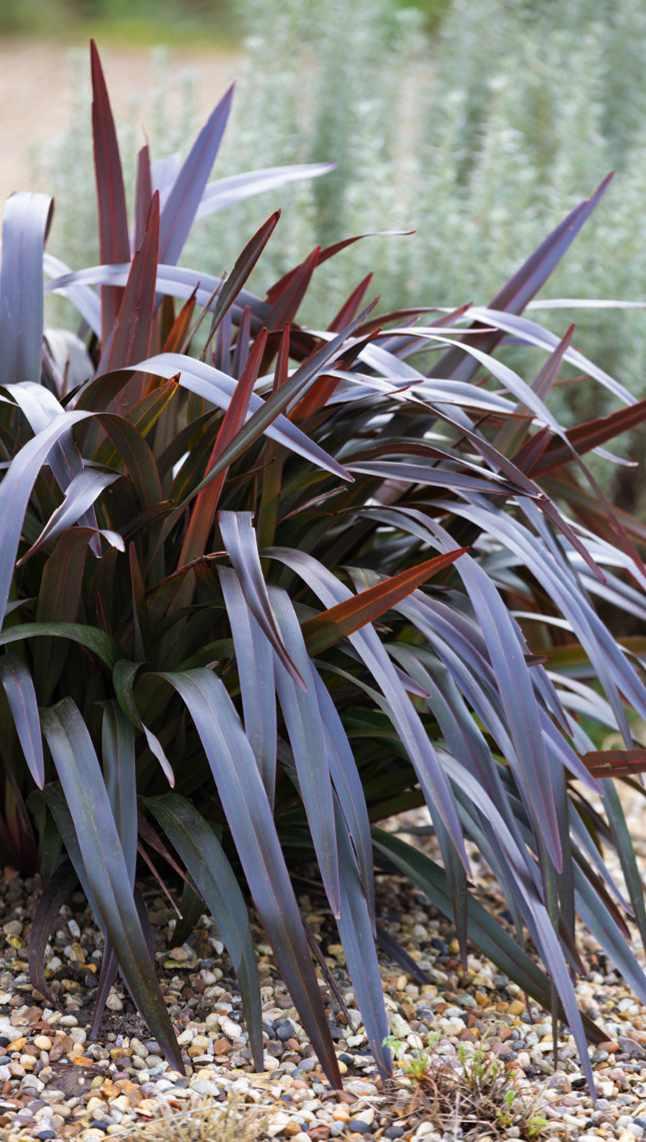
Hardiness RHS H7, USDA 4a-8b. Season of interest November – March for foliage; March – April for flowers.

DIG IN PLANTSPERSON’S FAVOURITES
*Holds an Award of Garden Merit from the Royal Horticultural Society. † Hardiness ratings given where available.
FEBRUARY 2023 GARDENSILLUSTRATED.COM 25
Åsa Gregers-Warg is head gardener at Beth Chatto’s Plants & Gardens in Essex bethchatto.co.uk
This was Sylvia’s promise to you...
A generation ago, a woman named Sylvia made a promise. As a doctor’s secretary, she’d watched stroke destroy the lives of so many people. She was determined to make sure we could all live in a world where we’re far less likely to lose our lives to stroke.

She kept her promise, and a gift to the Stroke Association was included in her Will. Sylvia’s gift helped fund the work that made sure many more of us survive stroke now than did in her lifetime.
Sylvia changed the story for us all. Now it’s our turn to change the story for those who’ll come after us.
Stroke still shatters lives and tears families apart. And for so many survivors the road to recovery is still long and desperately lonely. If you or someone \RX ORYH KDV EHHQ D�HFWHG E\ VWURNH���\RX�OO NQRZ just what that means.
Rebuilding lives after stroke
But it doesn’t have to be like this. You can change the story, just like Sylvia did, with a gift in your Will. All it takes is a promise.
You can promise future generations a world where researchers discover new treatments and surgeries and every single stroke survivor has the best care, rehabilitation and support network possible, to help them rebuild their lives.
Big or small, every legacy gift left to the Stroke $VVRFLDWLRQ ZLOO PDNH D GL�HUHQFH WR VWURNH VXUYLYRUV and their families.
Find out how by calling 020 7566 1505 or email legacy@stroke.org.uk or visit stroke.org.uk/legacy
The Stroke Association is registered as a charity in England and Wales (No 211015) and in Scotland (SC037789). Also registered in the Isle of Man (No. 945) and Jersey (NPO 369), and operating as a charity in Northern Ireland.
MAHONIA AQUIFOLIUM ‘MOSERI’
It was the horticulturist Graham Stuart Thomas who introduced Beth to this lovely Mahonia cultivar, which she enjoyed using in her winter floral displays. It is rather slow growing, which may explain why it is so rarely seen. Its evergreen leaves emerge the loveliest, pale-yellow-green, gradually turning to a coral tint as they mature. The colour intensifies and deepens as autumn progresses, lasting throughout the winter months. Small, upright clusters of yellow flowers in spring are followed by blue berries.
Height and spread 1.2m x 1m. Origin USA.
Conditions Rich, fertile soil; full sun for best foliage colour.
Hardiness RHS H5.
Season of interest November – March.
Places to visit
Åsa’s recommendations for places to see seasonal plants at their best
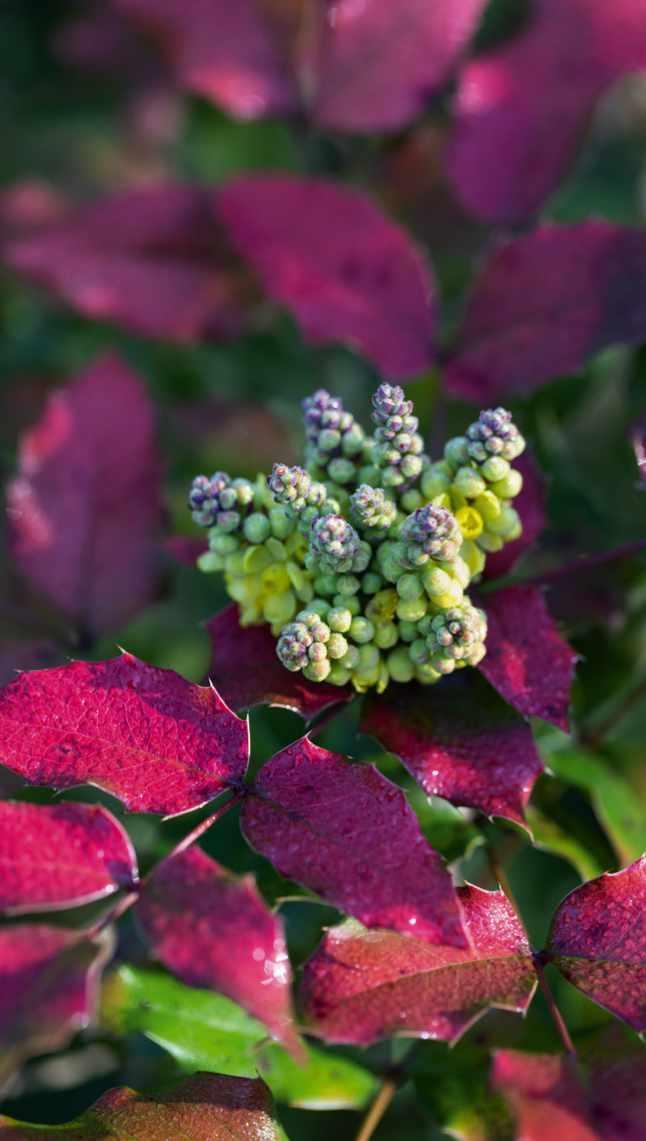
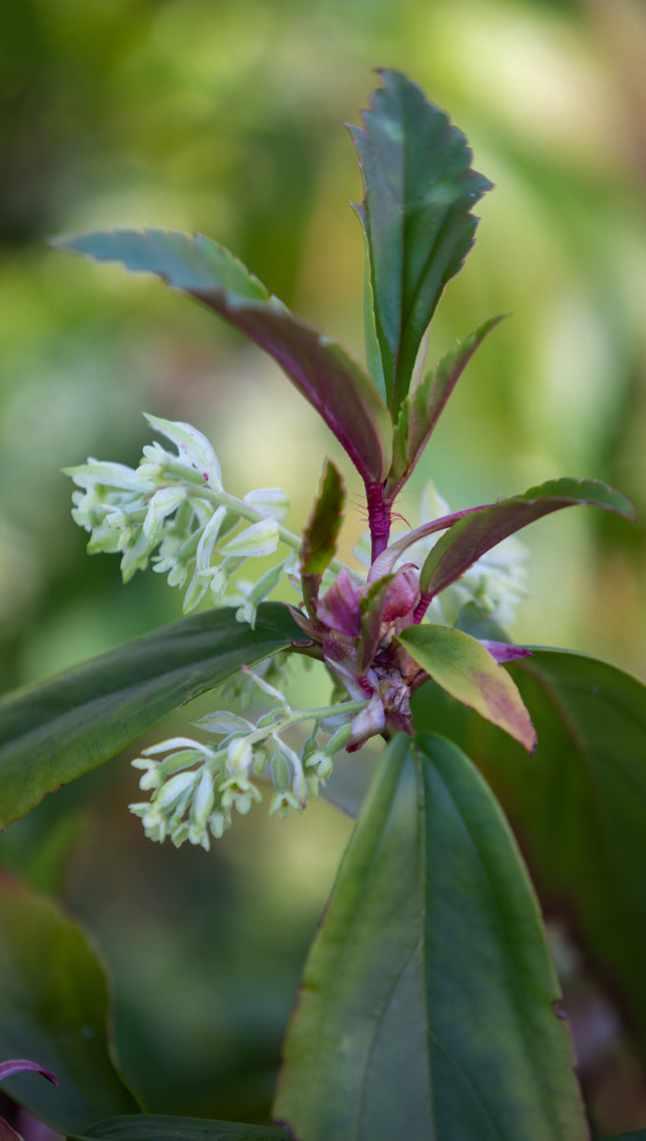
Be sure to check opening times. Some garden visits may need to be pre-booked.
GALANTHUS NIVALIS F. PLENIFLORUS ‘BLEWBURY TART’
Although I prefer the mass effect of more traditional-style snowdrop carpeting the ground, this distinctive double is a quaint curiosity. It is best admired up close to appreciate its upward-facing blooms, where the inner segments form an almost entirely green, frilly petticoat. Beth used to say it looked like an upturned, green, double primrose. It was discovered in 1975 by the late nurseryman Alan Street, who found it in the village of Blewbury, Oxfordshire. I’ve read that one of the early name suggestions was ‘Alan’s Horror’.
Height and spread 10cm x 10cm. Origin Garden.
Conditions Moist but well-drained soil; partial shade.
Hardiness RHS H5.
Season of interest February – March.
RIBES LAURIFOLIUM
The laurel-leaved currant makes a rather inconspicuous evergreen shrub for most of the year, until late winter, when drooping clusters of pale cream-green flowers, like those of flowering currants but larger in size, appear against the smooth, leathery foliage. Ours has taken many years to form a low, sprawling bush, the stems rooting where they touch the ground. Having a rather lax habit, it looks great spilling over a low wall.
R. laurifolium Rosemoor form and ‘Mrs Amy Doncaster’ are generally considered more choice selections with a better, more compact shape.
Height and spread 80cm-1m x 1.5m. Origin China.
Conditions Fertile, well-drained soil; sun or dappled shade.
Hardiness RHS H5.
Season of interest February – April.
Winter reveals the bones of a garden. During my first-ever visit to the Beth Chatto Gardens, on a very cold and blustery winter’s day in late January, more than 20 years ago, I was surprised and delighted to see how much visual interest the planting in the Gravel Garden held. It was a great lesson that one does not have to rely on topiary or formal garden
constructions to achieve this. Now is a good time to assess and re-evaluate your own garden, and visit others, stripped of their summer froth, for inspiration.
Hortvs, designer Peter Janke’s garden in western Germany, is one such place. The three-and-a-half-acre garden, comprising a gravel garden, woodland
walk and meadow, has a strong sense of structure, with formal elements combined with looser, more naturalistic, planting.
Grasses play a big part, while the solid bones are formed by evergreens and strong, contrasting tree shapes. Seeing the garden at this time of the year – before getting too distracted by snowdrops, hellebores and other
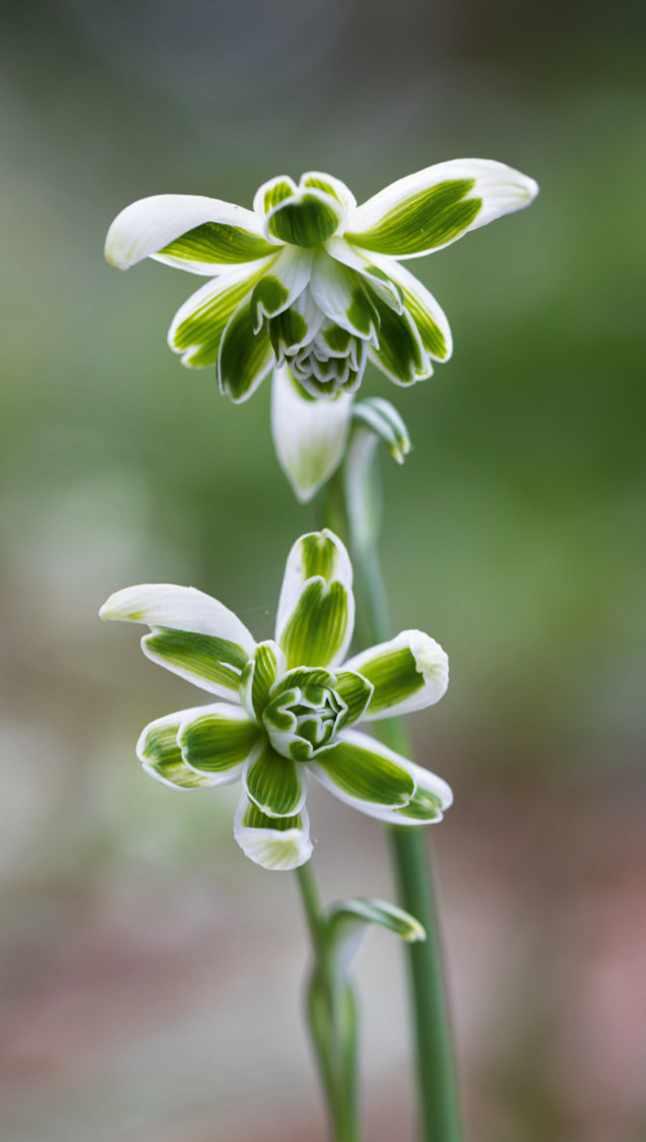
spring delights – has made me appreciate the shape and form of shrubs I normally wouldn’t pay much attention to.
Peter and his partner Michael Frinke run Hortvs nursery, which offers a great range of herbaceous perennials and grasses.
Hortvs, Peter Janke Gartenkonzepte, Hochdahler Straße 350, 40724 Hilden, Germany.
DIG IN PLANTSPERSON’S FAVOURITES
FEBRUARY 2023 GARDENSILLUSTRATED.COM 27
PETASITES JAPONICUS SUBSP. GIGANTEUS
Curious, posy-like, green-and-white heads, which resemble a cauliflower, burst through the bare soil in February and hug the ground, heralding the end of winter. Not for a small garden, this is a vigorous grower, spreading rapidly by underground rhizomes. Its common name, giant butterbur, is a reference to the huge leaves that were supposedly once used to wrap butter during hot weather. Native to Japan, Korea and Sakhalin, off the Russian coast, where it flourishes on moist stream banks and in woodland areas. The leaves will wilt in the heat of the sun if they don’t get enough moisture.
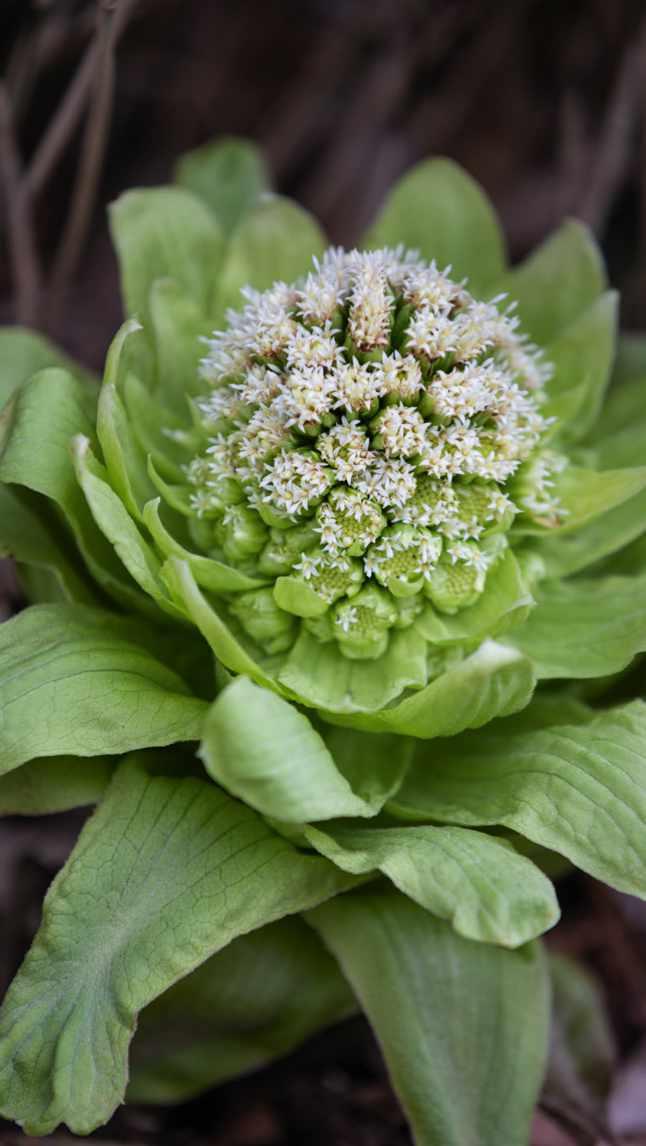
Height and spread 1.5m.
Origin Japan, Korea and Sakhalin.
Conditions Moisture-retentive soil; full sun.
Hardiness RHS H6, USDA 5a-9b.
Season of interest February – September.
SALIX GRACILISTYLA ‘MELANOSTACHYS’
The black pussy willow makes a striking addition to the winter garden, with its charcoal catkins bearing red anthers held on wine-coloured stems. We grow it in a large pot on Beth’s patio where visitors can admire the catkins up close, as well as next to one of the garden ponds beside a group of Cornus sanguinea ‘Midwinter Fire’. Naturally forming a large, rounded bush, it can be kept in check by annual pruning in late spring. We cut it back to a framework, rather like we’d treat a buddleja or sambucus, instead of stooling it to the ground. AGM.

Height and spread 3m x 3m.
Origin Japan.
Conditions Moist but well-drained soil; full sun.
Hardiness RHS H5, USDA 5a-7b.
Season of interest February – April.
DAPHNE ‘SPRING HERALD’
This is a lovely hybrid between D. bholua ‘Jacqueline Postill’ and D. acutiloba ‘Fragrant Cloud’. A profusion of blush-pink buds are carried in small, rounded clusters that open almost pure white and fill the air with delicious perfume over a long period in late winter and early spring. Smaller than D bholua, with a more compact, rounded habit, it’s evergreen (at least with us) with lance-shaped, deep-green leaves – the oldest ones often drop after the plant has bloomed. Prefers dappled shade with shelter from cold winds.
Height and spread 1.5m x 1.5m.
Origin Garden (species Himalayas, western China).
Conditions Well-drained soil; sheltered, away from strong sun and cold wind.
Hardiness RHS H4.
Season of interest February – April.
Tel +49 (0)2103
360508, peter-jankegartenkonzepte.de
Bluebell Arboretum & Nursery in Derbyshire is a leading supplier of rare woody plants, and has a website packed with useful information. The nine-acre arboretum was only started in 1992 and while some of its larger trees still have a few years to reach full maturity, there’s a vast
array of unusual shrubs and smaller trees to see. The well-stocked nursery offers a great selection of top-quality plants, all available via mail order.

Bluebell Arboretum & Nursery, Annwell Lane, Smisby, Ashby de la Zouch, Derbyshire LE65 2TA. Tel 01530 413700, bluebellnursery.com
I’m always on the lookout for new specimen
shrubs and have been browsing the Junker’s Nursery catalogue for a replacement for a couple of euonymus we recently lost. Visits to this nursery are a treat but strictly by appointment only. Junker’s Nursery, High Cobhay, Milverton, Somerset TA4 1NJ. Tel 01823 400075, junker.co.uk
Snowdrops are one of the sweetest pleasures of
winter and this month many of the UK’s finest gardens, from Cambo in Fife to the Garden House in Devon, throw their gates open for a snowdrop extravaganza. Don’t miss the opportunity to visit one of the many privately owned gardens open through the National Garden Scheme in February. ngs.org.uk
Each February Shepton Snowdrop Festival in
Somerset celebrates the galanthophile James Allen (1830-1906), who bred more than 100 cultivars. The festival takes place in and around Shepton Mallet from 13-19 February, with the main events on 17-18 February. Yeo Valley Organic Garden will open as part of the festival, offering a glimpse of its winter garden. Tel 07710 252155, sheptonsnowdrops.org.uk
DIG IN PLANTSPERSON’S FAVOURITES
28 GARDENSILLUSTRATED.COM FEBRUARY 2023

www.oltco.co.uk leading sustainable resin driveways #JoinTheRevolution * Innovated by, and exclusive to Oltco, Recycle Bound is a resin bound solution that is made using a mix of stone and recycled waste plastic * leading sustainable resin driveways Call or email today for your FREE sample or instant quote. 0800 0407795 info@oltco.co.uk
THE CONSTANT GARDENER
Head gardener Benjamin Pope finds colourful stems and fragrant flowers an antidote to February’s cold grip, but is savouring the month’s stillness before the rush of spring jobs
ILLUSTRATION CLAIRE HARRUP

As February arrives, beaten crab apples and rose hips fall from bare branches, while birds consume the last of the holly berries. Although the days are technically lengthening, I find the start of the month to be one of the darkest times, when frosty low temperatures continue to make spring feel far away.
Looking for uplifting colour and inspiration, I turn to the glowing stems of dogwoods and willows. Having looked good all winter, they continue to dazzle until they are hard pruned later this month. Reliable favourites include Cornus sanguinea ‘Midwinter Fire’ (along with its red, yellow and almost-black counterparts) and the larger, coppiced Salix alba var. vitellina ‘Britzensis’ and ghostly grey S. irrorata .
For bigger subjects, perhaps try Tilia cordata ‘Winter Orange’, a large tree that can be pleached to restrict size and create formal structure, while dramatically presenting the glowing young growth. For bark effect, I am drawn to Betula nigra ‘Heritage’, with its shaggy, warm-cream, pink and beige peeling bark. Though it has
to be said that there are smarter and more conspicuous alternatives, including B. ‘Fascination’ and the many cultivars of B utilis var. jacquemontii. Other classics include Acer griseum and Prunus serrula, along with evergreen Arbutus x andrachnoides and Myrtus communis, the latter two preferring a more sheltered site.
On a smaller scale, the snowdrops and winter aconites are in full swing, with Anemone blanda, Crocus tommasinianus, and various narcissi soon to follow. During milder periods, the generic strappy leaves of Iris unguicularis (quietly tucked away in a sheltered corner at the base of a wall) give way to impressive – though delicate – paleblue flowers with a white centre, decorated with darker veins and a yellow stripe.
These warmer days also encourage the scent of winter-flowering shrubs such as Chimonanthus praecox , Daphne bholua ‘Jacqueline Postill’, Edgeworthia chrysantha , Hamamelis x intermedia ‘Aurora’ and Lonicera x purpusii ‘Winter Beauty’. With the sun on my face, and sweet fragrance in the air, the sound of bumblebees busily foraging reassures me that spring is approaching and I remind myself to savour the last few still moments of winter.
What to sow and plant

With longer days comes the temptation to sow seeds with gusto, but exercise caution as sowing too much now can leave you struggling for space to grow on young seedlings later, especially if we have an extended, cold spring.
Indoors, I begin the first sowing of quick-maturing salad leaves and herbs such as basil, coriander and parsley. Towards the end of the month, I start off chillies, bell peppers and greenhouse tomatoes, as some cultivars, including the chillies ‘Chocolate Habanero’ and ‘Jamaican Yellow’ and the sweet pepper ‘Corno di Toro’, can be slow to germinate or crop. Italian and French tomato cultivars, such as ‘Costoluto Fiorentino’, ‘San Marzano’ and ‘Marmande’, will love the extra heat from growing indoors and will stay in the greenhouse all summer (outdoor cultivars will be sown next month, ensuring they don’t grow too large before they can go outside).
In the garden there is still time to plant trees, shrubs and roses, though I would also add any new additions of perennials and biennials, especially if you have light sandy conditions that warm up quickly.
What to harvest and pick
Increasing light levels promote fresh growth on winter salad leaves, mustards and pea shoots, as well as chard and lambs’ lettuce. Over-wintered celeriac, leek, Jerusalem artichoke, parsnip and winter squash are all still good to harvest, though some may look a little ragged. I use them in soups that I freeze, and add stored onion and garlic, along with celery, parcel (a cross between parsley and celery), rosemary or thyme from the garden. Below the brassica net, kale, sprouts and winter cabbages continue to crop, with the addition of purple-sprouting early broccoli (a weekly staple for the next six weeks).
Inside, forced hyacinths and paperwhite Narcissus papyraceus ‘Ziva’ are flowering, though an early, hardy, white daffodil from the garden, N. ‘Erlicheer’, is a good substitute for cutting and, coupled with the bright-yellow N. ‘Tête-à-tête’, creates an uplifting display. From the borders I simply use a stem or two of daphne, witch hazel and sarcococca, bringing that important fragrance into the house. n • Benjamin’s Gardens Illustrated talk: ‘Grow a year-round, productive garden’ is available to view at gardensillustrated.com/masterclass
GARDEN JOBS for February
Begin to cut back grasses As winter ends, ornamental grasses become untidy. Deciduous grasses should be cut back hard while evergreen species should be gently combed and lightly trimmed if required.
Lifting and dividing Now is the perfect time to lift and divide herbaceous perennials as they begin to wake from their winter rest. Using a sharp spade, lift the entire plant and split it into sections, replanting or potting up the newest growth. Stake borders Before border plants come into growth, construct plant supports using beanpoles and string or woven pea sticks. As the perennials and climbers grow, they will naturally find the support they require. Prepare to take cuttings Force growth of tender and half hardy perennials, such as dahlias, indoor chrysanthemums and salvias. Pot up and feed the stock plants, and grow indoors for early, strong stems, which are perfect for taking spring cuttings.
Prune wisteria Make sure to winter-prune wisteria to encourage flowering. If not already complete, remove last year’s lateral growth (whippy stems coming from the main structural growth) by cutting back to three or four buds to create short twiggy spurs.
DIG IN: IN THE GARDEN
FEBRUARY 2023 GARDENSILLUSTRATED.COM 31
FREE: 1x 5Ah battery, #Tq���¢ A����������� MR002GZ01 Radio with Selected 18V LXT Garden Products
FREE: 1x 5Ah battery, #Tq���¢ A����������� MR002GZ01 Radio with Selected 18Vx2 LXT Garden Products

FREE: 1x 2.5Ah battery, Tq���:¢ A����������� MR002GZ01 Radio with Selected 40V XGT Garden Products
DUB362PG2, DUB362PT2, DUB363PG2V, DUB363PT2V, DUC256PG2, DUC256PT2, DUC306PG2, DUC306PT2, DUC353PG2, DUC353PT2, DUC305PG2, DUC305PT2, DUC355PG2, DUC355PT2, DUC405PG2, DUC405PT2, DUR368APG2, DUR368APT2, DUR368LPG2, DUR368LPT2,

CLAIM A FREE PRODUCT makitauk.com/redemption 18V LXT: DCU180PT2, DCU180PTX4, DCU180PTX3, DLM330RT, DUB184RT, DUB186RT, DUC254RT, DUC307RTX2, DUH523RT, DUH502RT, DUH601RT, DUH604SRT, DUH751RT, DUH754SRT, DUM111RTX, DUM604RTX, DUN461WRT, DUN500WRTE, DUN600LRTE, DUR181RT, DUR189RT, DUR190LRT8, DUR190URT8, DUR191LRT8, DUR191URT8, DUR192LRT, DUR194RTX2, DUX18RT. 18Vx2 LXT: DDG460T2X7, DLM382CT2, DLM382PG2, DLM432CT2, DLM432PG2, DLM460PT4, DLM460PG2, DLM462PT4, DLM462PG2, DLM480CT2, DLM481CT2, DLM530PT4, DLM530PG2, DLM532PT4, DLM532PG2, DLM533PT4, DLM533PG2, DLM538CT2, DLM539CT2, DUA301PG2, DUA301PT2,
DUR369APG2, DUR369APT2, DUR369LPG2, DUR369LPT2, DUX60PG2, DUX60PT2. 40V XGT: DG001GD202, LM001GT204, LM002GT204, UA004GD203, UB001GD202, UC002GD202, UC003GD202, UC011GT201, UC014GT201, UC015GT201, UC016GT201, UH004GD201, UH005GD201, UH006GD201, UH007GD201, UH013GD202, UH014GD202, UR002GD202, UR003GD202, UR006GD202, UR008GD202, UR012GT203, UX01GD202. Claims can be registered on-line from 1st Feb 2023 and must be registered within 28 days of purchase for qualifying models. Qualifying models must be purchased by 30th June 2023 to qualify and registered within 28 days.
Do you have macular degeneration? Join our community at the Macular Society, and we’ll help you find your way with expert advice and support. You’ll receive: Your Welcome Pack – all you need to know as a new member. Sideview magazine – packed with research updates, technology features, daily living tips and inspirational stories. Monthly e-newsletter – including advice on living with sight loss, and the latest research news direct to your inbox. Start your FREE membership trial today by calling 01264 350 551 or at macularsociety.org/gi It’s easy to join – all we need is your name and address 6-month free trial membership Macular Society is the trading name of the Macular Disease Society. A charity registered in England and Wales 1001198, Scotland SC042015 and Isle of Man 1123. A company limited by guarantee, registered in England No. 2177039. Registered O�ce: Macular Society, Crown Chambers, South Street, Andover SP10 2BN. UK Membership: £22 per year; first 6 months free. Following the 6 month trial, we’ll be in touch to ask if you would like to become a full member. UK residents only. For full terms and conditions please visit macularsociety.org/6monthsterms MA23PAD007
RYAN HEALEY
Horticultural hero My grandad was the first person I remember being obsessed with gardening. His unbounded enthusiasm is what I aim to embody in my own work. Three worthwhile tips Look after your soil and your soil will look after everything else. Resist the tidiness mentality of cutting your herbaceous perennials back in autumn and wait until the end of winter instead. Seedheads offer food, while foliage offers valuable habitat for overwintering wildlife. Gardening is a process, so don’t rush it and enjoy the little surprises that come along the way.
Dream plant destination I’ve always wanted to visit the Garden of Ninfa in Italy. The history and ethos of the garden are really interesting and I love the idea of nature regaining control over man-made structures but in a carefully gardened and romantic way.
Favourite planting style I’m drawn to styles that evoke natural landscapes and offer a chance for wildlife to thrive. Woodland-style plantings resonate with me. Plants that thrive in shade have a wonderfully subtle interest that I appreciate more than the boldness of sun-loving plants. Biggest challenge for gardeners The unpredictability of weather. Last summer we recorded the hottest temperatures ever in the UK and had one of the driest summers on record. Whereas the previous year we had one of the wettest summers on record. This unpredictability is going to affect our plant and crop choices; we need plants that are robust enough to cope with these changes.
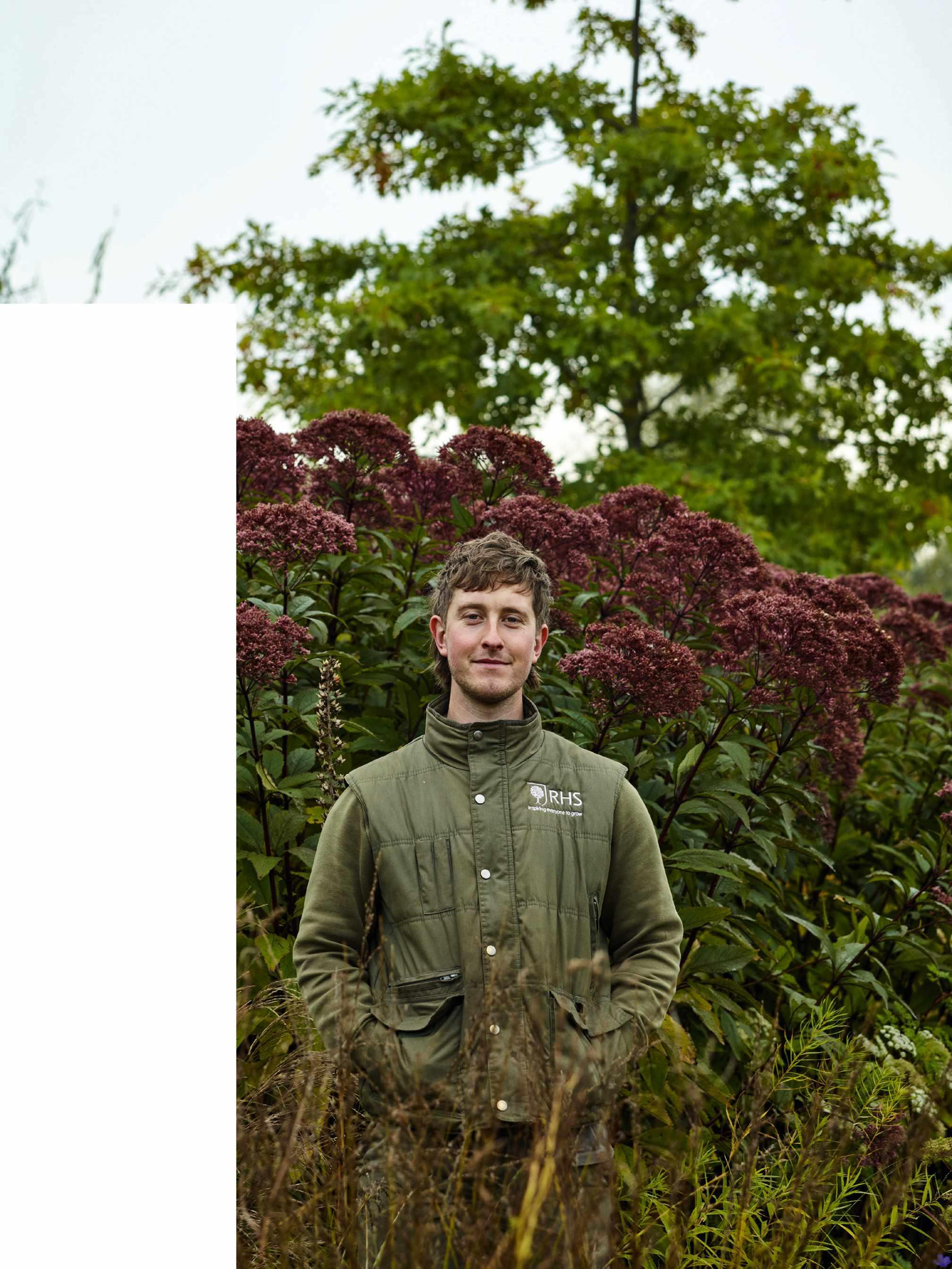
Horticultural principles Working with nature and not against it. Gardening with the earth and wildlife in mind. Our gardens act as green corridors that are as important for insects, birds and mammals as they are for us to enjoy. One easy, sustainable thing we can do Water is the driving force of all nature, so collect rainwater with diverters and water butts. Re-use grey water in the garden where possible as long as it is not contaminated with strong chemicals. Implement a rain garden to collect storm water and prevent run-off. Add a small pond, and watch wildlife explode in your garden, and use organic mulches, such as compost or bark, in the garden to prevent the soil drying out too quickly.
Your next big project at Bridgewater The Scholar’s Garden at the centre of the Chinese Streamside Garden. There will be traditional Chinese pavilions and a pond, as well as an extensive Anglo-Chinese planting palette. The project is still in the planning phase but it’s one I am definitely looking forward to.
Contact ryanhealey11@hotmail.co.uk
Find out more about RHS Garden Bridgewater at rhs.org.uk/gardens/bridgewater
GARDENING TALENT
As a horticulturist at RHS Garden Bridgewater, Ryan is helping to manage and develop areas within the garden’s many woodland spaces
PORTRAIT JASON INGRAM
FEBRUARY 2023 GARDENSILLUSTRATED.COM 33
Plants that thrive in shade have a wonderfully subtle interest that I appreciate more than the boldness of sun-loving plants
IN BRIEF
Name Hill Farm.
What A low-maintenance, sloped garden. Where Surrey.

Size One-and-three-quarter acres.
Soil Free-draining, slightly acid loam.
Climate Temperate and north-facing. Hardiness zone USDA 8.
A rich tapestry of heathers, including Erica carnea f. alba
‘Springwood White’ and E. x darleyensis ‘J.W. Porter’, create seamless rivers of colour in Helen’s steeply sloping garden.
“I had to do some weeding until it all knitted together,” she says, “but since then it has really looked after itself.”
Rising to the challenge
Faced with a steeply sloping garden, Helen Thomas has come up with a design that enhances rather than fights the contours of the land
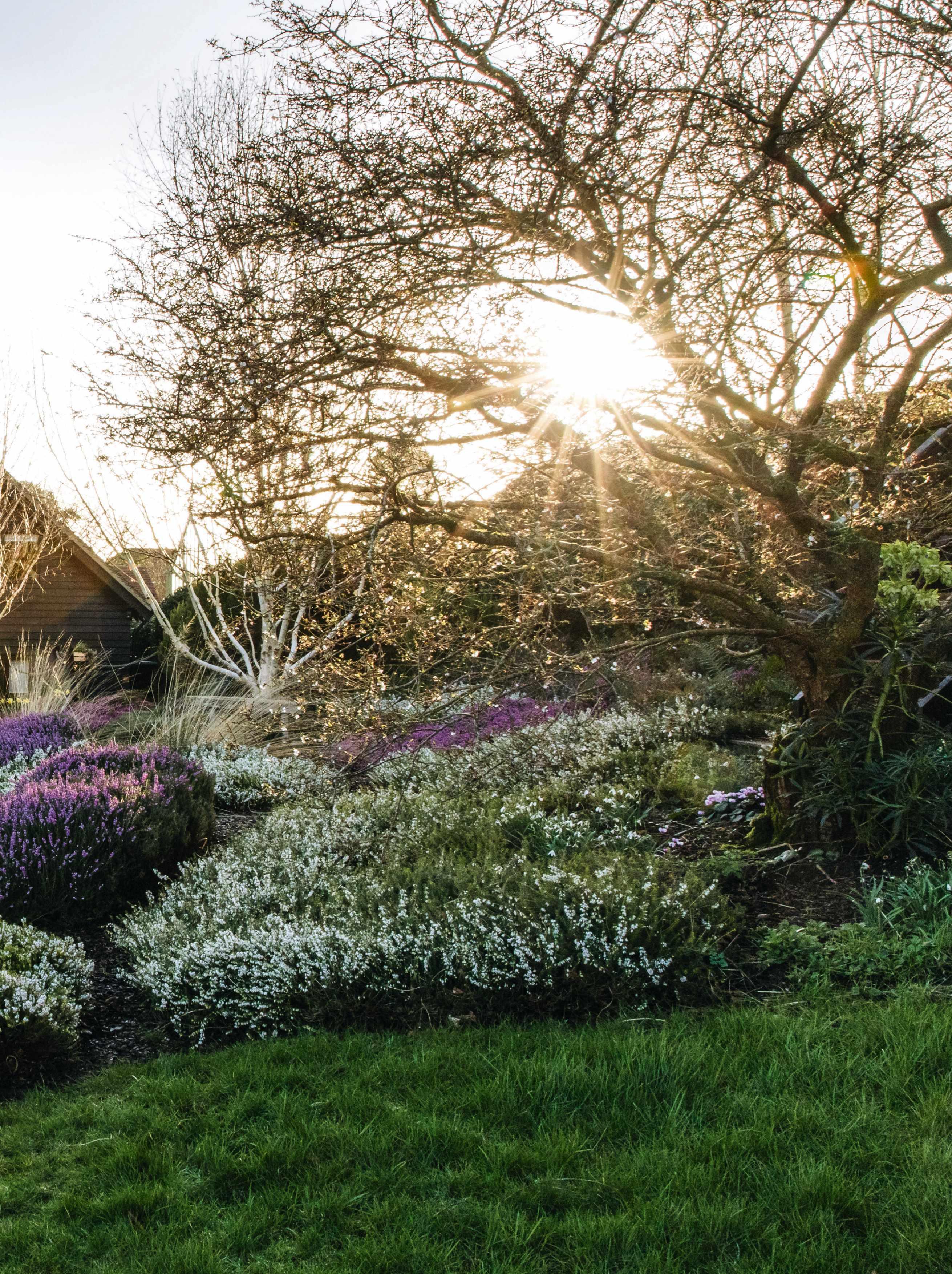
FEBRUARY 2023 GARDENSILLUSTRATED.COM 35
WORDS HUMAIRA IKRAM PHOTOGRAPHS ÉVA NÉMETH
Helen Thomas is an extremely lucky woman. The approach to her house looks like something out of a children’s book, as it passes a moss-covered church, trees that arch and bend in the breeze and a pond and meadow that run alongside stone walls. It evokes a different time when everything was freer, greener and less complicated.
When Helen moved to this house, the garden was little more than grass, and mature trees and hedges. Unsure about the ideas her architects initially proposed for the garden, Helen came up with a plan that would provide space for her children to play in, while preserving the sloping garden’s natural contours. “The house is called Hill Farm,” she says. “I didn’t want it to become Terrace Farm, so keeping to the contours seemed the right thing to do.”
Helen has indeed worked brilliantly with those contours, and she enjoyed the process of planning the space so much she decided to retrain as a garden designer, enabling her to bring her newly acquired skills to the project. While many designers would have been

tempted to create terraces here, Helen has enhanced the steep slope by using heathers and shrubs to accentuate and mimic the movement of the land. Sweeping areas of planting separate sections of the garden, with pathways of grass and wood chippings running like ribbons between the levels. As the soil is acid loam, many neighbouring gardens are full of rhododendrons and camellias, but Helen didn’t want to follow the same pattern. “I wanted to show that you could plant in a different, lighter and more modern way, using grasses as well as the more traditional heathers,” she says.
Initially, her choice of traditional heathers was practical as much as aesthetic. “I had a young family and heathers were dog- and child-proof,” says Helen. She started with a mix of the magnificent mauve Erica x darleyensis
‘J.W. Porter’, and the white Erica carnea f. alba ‘Springwood White’, planted as a matrix with the Irish heath, Daboecia cantabrica. Although unable to compete with the ericas, this Irish heath still stubbornly pops up every so often throughout the border, providing sustenance for pollinators in summer.
In winter, the ericas offer a rich tapestry of colour around the house, and in the long borders the grasses and sedums, which live well and die gracefully, are still impressive.
Growing heathers
• Hardy heathers are compact and evergreen shrubs that can cope with exposure to wind and extreme cold.
• Ericas typically flower in winter and spring, and are more resilient in neutral and slightly alkaline soils. Callunas typically flower in the summer and autumn, and need a light, sandy and acid-rich soil. Daboecias can flower from spring to autumn and love an acid, sandy soil.
• Prune heathers after flowering, to stop them becoming leggy. Clip into the foliage rather than the woody stems as they won’t recover, if pruned too hard.
• To propagate, dig plants out in spring then plant them deeper, so that a third is showing above ground. In autumn, the upper shoots should have rooted and you can plant them separately and discard the parent plant.
GI Find the best heathers to grow at gardensillustrated.com/heathers
36 GARDENSILLUSTRATED.COM FEBRUARY 2023
Helen Thomas’s assured garden rolls down gracefully towards the Surrey Hills. Below the house, the main terrace has been cut out of the slope, with walls constructed of local flint and softened by a colourful carpet of low-maintenance heathers.
8 KEY PLANTS
1 Helleborus argutifolius Offering apple-green freshness from January to March, this evergreen perennial is best grown in neutral-to-alkaline soil but is thriving in the acid soil at Hill Farm. 50cm x 90cm. AGM*. RHS H5, USDA 6a-8b †

2 Cyclamen coum Flowers consistently from January through to March offering gorgeous pops of pink. It’s a hardy perennial that will happily grow at the base of deciduous shrubs. 10cm x 10cm. USDA 4a-8b.
3 Skimmia reevesiana ‘Rubella’ Its red buds surprisingly open up to highly fragrant, white flowers. Prefers an acid-to-neutral soil and grows slightly taller than Skimmia x confusa ‘Kew Green’. 1m x 50cm. AGM. RHS H5.
4 Erica carnea f. alba ‘Springwood White’ During last summer’s extreme temperatures, this heather proved to be one of the most resilient in Helen’s garden. Creates mats of bright-green foliage and drapes well over the edges of walls. In common with most other heathers, it is loved by pollinators. 30cm x 20cm. RHS H6, USDA 5a-7b.
8 key plants continues on page 38
1 2 4 3
8 KEY PLANTS
5 Miscanthus sinensis ‘Malepartus’ This Miscanthus stands well throughout winter and is hardy to -15ºC. It’s a little tricky to move once established, so make sure you plant it in the right place. Best cut back in February. 2m x 1.2m. RHS H6, USDA 4a-9b.
6 Prunus ‘Accolade’ This early ornamental cherry with pale-pink blossom will thrive in full sun and any moist but well-drained soil. 8m x 5m. AGM. RHS H6, USDA 5a-8b.
7 Erica x darleyensis ‘J.W. Porter’ An evergreen heather that offers pink-mauve flowers all winter. Likes full sun and an acid or neutral, moist but well-drained soil. 35cm x 55cm. AGM. RHS H5.
8 Helleborus x hybridus One of a selection of hellebores given to Helen by her father, which may be ‘Harvington Single Pink’. It prefers a neutral-to-alkaline soil but is thriving in the acid soil of Helen’s garden. 45cm x 45cm. RHS H7, USDA 4a-9b.
*Holds an Award of Garden Merit from the Royal Horticultural Society. †Hardiness ratings given where available.

5 6 8 7
Grasses include Calamagrostis brachytricha, along with the upright Miscanthus sinensis ‘Malepartus’, and the shorter and more lax M. sinensis ‘Abundance’, which arches over the edges of the paths. Helen has dotted the lighter Molinia caerulea ‘Poul Petersen’ around to create a shimmer effect.
Hellebores, used to brighten areas – the apple-green Helleborus argutifolius is especially zingy at this time of year – have now colonised in swathes and spread across the borders. And beneath the deciduous shrubs you’ll find purple and white patches where cyclamens are triumphantly pushing through.
Like many gardeners, Helen found last summer’s sky-high temperatures and drought something of a wake-up call. “I was a bit worried about the heathers and some of them became scorched and looked stressed by the end of the summer,” she says, “but they all made it through.” Her winter garden was built to be self-sufficient and has no irrigation. “We have a 40,000 litre rainwater tank, which we use to water the garden intermittently,” says Helen. “We also have a regime of mulching in spring and autumn with a thick layer of woodchip.”
Hill Farm certainly lives up to its name, with its steep climb up through the heathers and perennials, punctuated by silver birches,
Betula utilis subsp. jacquemontii, before you emerge, blinking into a sunny, hilltop, kitchen garden. “This is currently my favourite part of the garden,” says Helen. “It has allowed me to experiment, grow, eat and observe, and actually do some gardening. I’ve been thinking about wildlife gardening, and how everything in the garden is interconnected. It’s given me the space to watch butterflies, bees and nature in general.”
Her children now grown, Helen has an opportunity to introduce new planting into the mix that demonstrates her growing awareness of ecological interconnectedness.
“The garden I built worked well as a family garden, but now we have different needs,” she says. “I want to use the garden as a way of learning, experimenting and educating.” It will be exciting to see how it evolves, but for now, Helen’s garden is a triumph of winter beauty and a wonderful space to explore on a brisk winter’s day. n
USEFUL INFORMATION
Address Hill Farm, Logmore Lane, Westcott, Dorking, Surrey RH4 3JY. Open For NGS, 17 September 2023, 11.30am-4.30pm.
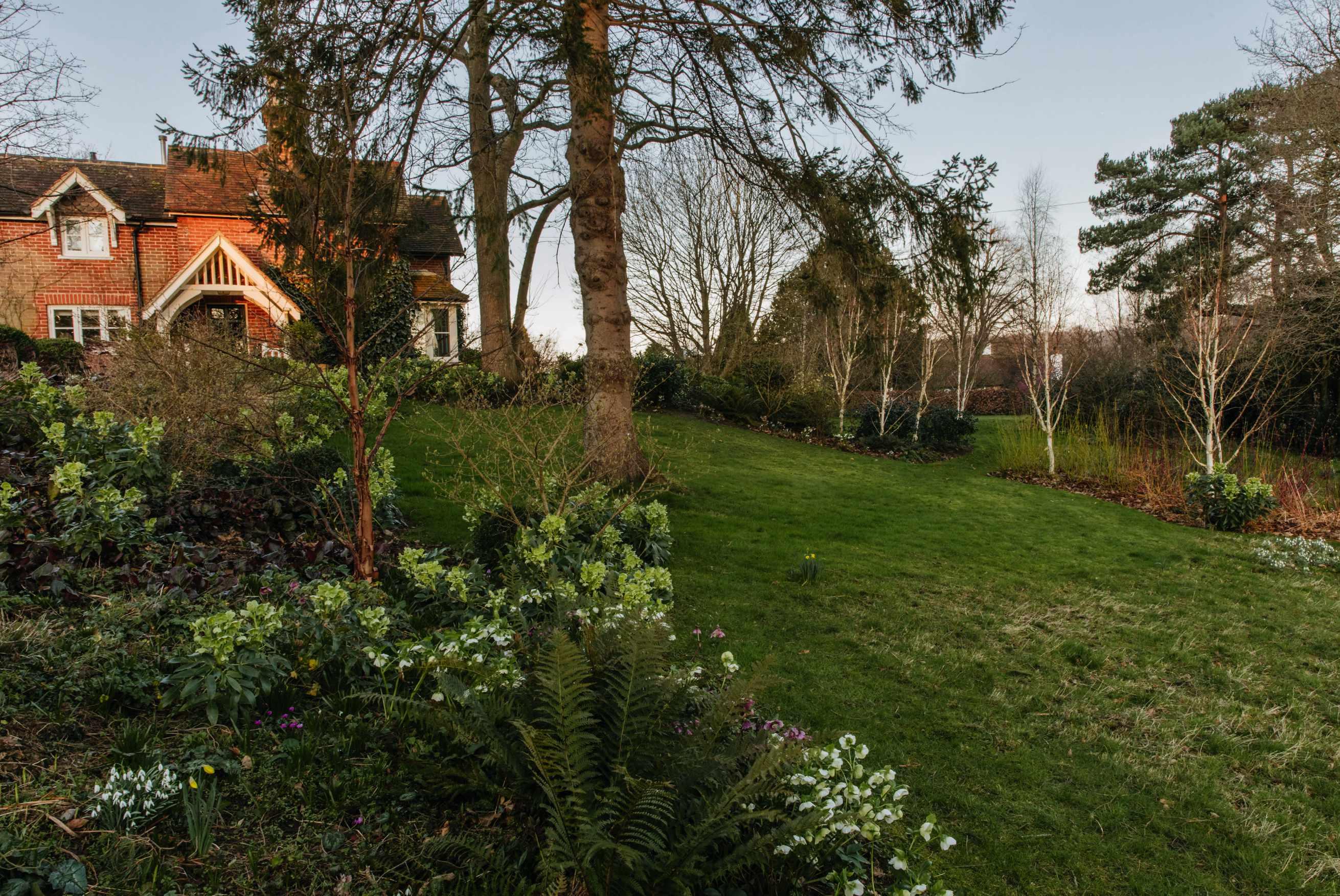
Find out more about Helen’s work at helenthomasdesign.co.uk
Above Beneath a mature and statuesque pine, the zingy-green Helleborus argutifolius has spread and interspersed with ferns and Galanthus nivalis. These are repeated on the other side of the lawn, beneath the structural and striking winter skeletons of Acer griseum and Betula utilis subsp. jacquemontii
FEBRUARY 2023 GARDENSILLUSTRATED.COM 39
I wanted to show you could plant in a lighter and more modern way, using grasses as well as the more traditional heathers
10 key snowdrops from Morlas Plants

1 Galanthus x valentinei ‘Miss Willmott’
Very free-flowering, with individual flowers that are delicate in appearance, giving it an elegant overall look. 15cm.
2 Galanthus elwesii ‘Fly Fishing’
An elegant, early flowerer with a very long, narrow pedicel and a deep-green ‘V’ to the inner segments. 20cm.
3 Galanthus x valentinei ‘Benton Magnet’
A short, vigorous snowdrop with large, single flowers. Bred by artist-gardener Cedric Morris at his home at Benton End in Suffolk. 12cm.
4 Galanthus nivalis ‘Trudy Spotted’
Beautifully shaped flowers with outer tepals marked in green. The inner petals are marked with a green heart. 16cm.
Key snowdrops continue on page 42. See page 45 for details of hardiness ratings.
4 3
2 1
Collective effort
Jane Rowlinson’s rare and notable snowdrop collection is thanks in part to a mutually supportive galanthophile community
WORDS LUCY BELLAMY PHOTOGRAPHS JASON INGRAM
In gardening, the culture of sharing is strong, and there is a tendency among snowdrop fans in particular to collect and redistribute their bulbs. In common with all plants, snowdrops respond to the subtle topography of their location – soil, temperature and light – and swapping and sharing the bulbs adds to the understanding of where a particular cultivar will do best.
For plantswoman Jane Rowlinson, that location is a wedge of land in a frost pocket, with a brook running through it, edged by a woodland and with swathes of naturalised snowdrops growing close by.
In 2017, she relocated her family nursery from Cheshire to Shropshire, renaming it Morlas Plants
and rebranding it as a specialist bulb nursery, offering rare and common snowdrops and other spring bulbs. Jane’s enthusiasm for snowdrops dates back to 1992, when as a student at Pershore College she came across Galanthus nivalis Sandersii Group, a single-flowered snowdrop noted for its yellow markings, in a book. She began touring the gardens of Britain’s legendary galanthophiles, including those at East Lambrook Manor Gardens, Avon Bulbs and Monksilver Nursery, to build up her own collection. Her first rare acquisition was G. ‘White Swan’, a tall, elegant double costing £8, which “felt expensive at the time”.
Snowdrops thrive at Morlas, benefitting from the leaf litter and friable soil, and soon Jane was selling offsets from her original bulbs to fund her

FEBRUARY 2023 GARDENSILLUSTRATED.COM 41
expanding collection. “I like to get plants from the garden or grower of origin to test them thoroughly in my garden, and similarly I’ll send my own plants to other growers for them to trial,” she explains.
“How a particular cultivar grows in one location isn’t necessarily how it will grow elsewhere. Microclimate is so important; soil and temperature can both affect the timing of the opening of the flowers.”
Six years on and Morlas Plants is now the go-to nursery for serious collectors and fledgling enthusiasts alike, counting garden designers Arne Maynard and Dan Pearson among its fans. It’s not hard to see why. Order a snowdrop from Morlas Plants and you will receive a beautifully wrapped, peat-free and sustainable package, with moss and brown paper tied up with string.
Standard practice is to plant snowdrops ‘in the green’ while they still have green leaf. Jane
grows her bulbs in pots in peat-free compost then carefully selects them when in flower to send out from the beginning of January, to gardeners who must then plant them swiftly.
The Morlas snowdrop list goes ‘live’ online at midnight on 1 January each year, with notable cultivars selling out within hours. Dormant bulbs of a good number of cultivars are also available in late summer, full of the stored energy of the previous year. Jane recommends adding a handful of sand to the planting holes of both dormant bulbs and snowdrops in the green when they first go in, to flag up their presence in the soil at other times of year.
Trials are currently underway of a number of new cultivars. The new selections are open-pollinated, “by bees jumping flower to flower”, and the Morlas way is to offer them to fellow collectors initially, who grow them on and report back, before they
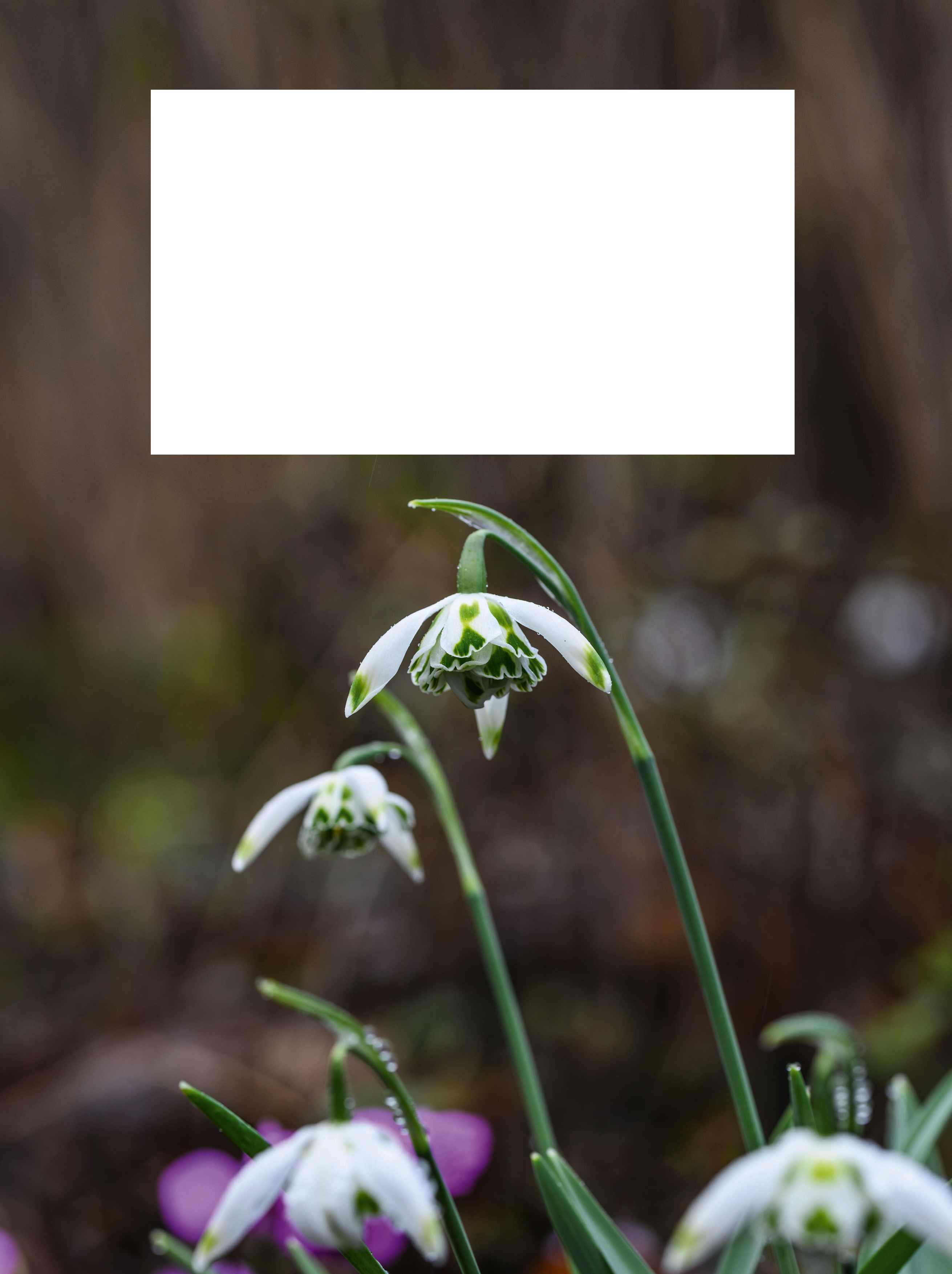
42 GARDENSILLUSTRATED.COM FEBRUARY 2023
Galanthus ‘Franz Josef’
Pointed, green-tipped outer segments surround a tight, double, inner frill with good green markings. 18cm.
5
10 key snowdrops continued
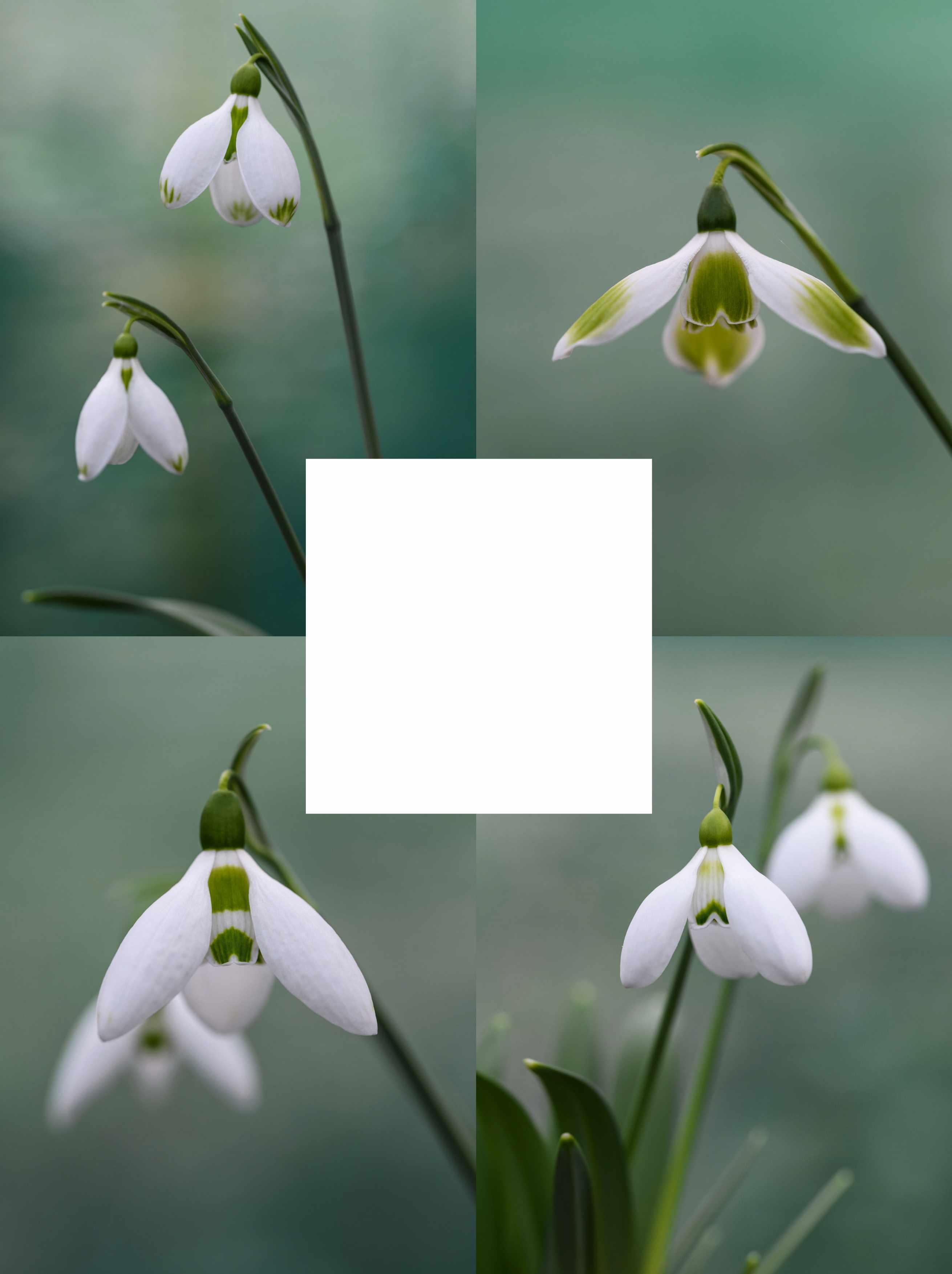
6 Galanthus plicatus ‘Grave Concern’ Large, heavy, rounded flowers with a bright-green area on the puckered tips that resembles a scallop shell. Solid green inners. 16cm.
7 Galanthus elwesii var. monostictus ‘Kryptonite’ An elegant form that is heavily marked with green. Flowers early in the season (December). 16cm.
8 Galanthus elwesii ‘Bumble Green’
The outer segments are tipped with green, and there are two well-defined marks on the inners. This is another early flowerer, blooming before Christmas. 20cm.
9 Galanthus ‘Lord Kitchener’ Robust, reliable and easy-to-grow hybrid with large, elegant flowers. 16cm.
Key snowdrops continue on page 44. See page 45 for details of hardiness ratings. 9 8
6
7
are offered for wider sale. “With so many people naming new snowdrops, the challenge is in finding an outstanding plant,” Jane says.
What is the perfect snowdrop? “A large flower with good green markings, robust and free flowering. A bulb that multiplies readily and with flowers that are recognisable from a distance,” she explains. A recent introduction is G. ‘Rachel Rowlinson’, named for Jane’s daughter, whose birthday on 1 March coincides with the bulb in full flower.
It’s a green, double-marked, late flowerer that is a seedling of G. ‘South Hayes’, a snowdrop coveted for its pagoda-like shape and dark-green markings.
Historically, Shropshire has a strong association with snowdrops and Jane is currently compiling a collection of Shropshire snowdrops, hunting out the cultivars discovered by great, local galanthophiles, including David Bromley, Eddie Roberts and
Margaret Owen. Morlas is also involved in the repatriation of snowdrops to Benton End, the Suffolk garden that once belonged to the artist and plantsman Cedric Morris, and which is being developed as an arts project in conjunction with the Garden Museum. Morlas is supplying G. ‘Benton Magnet’, a vigorous snowdrop with luminous flowers, and G. elwesii ‘Cedric’s Prolific’, a prolific flowerer with green tips and pointed leaf nibs.
Morlas is a fantastic specialist bulb nursery, firmly rooted in its location and infused with sense of place, for serious and fledgling snowdrop collectors and passionate gardeners alike. n
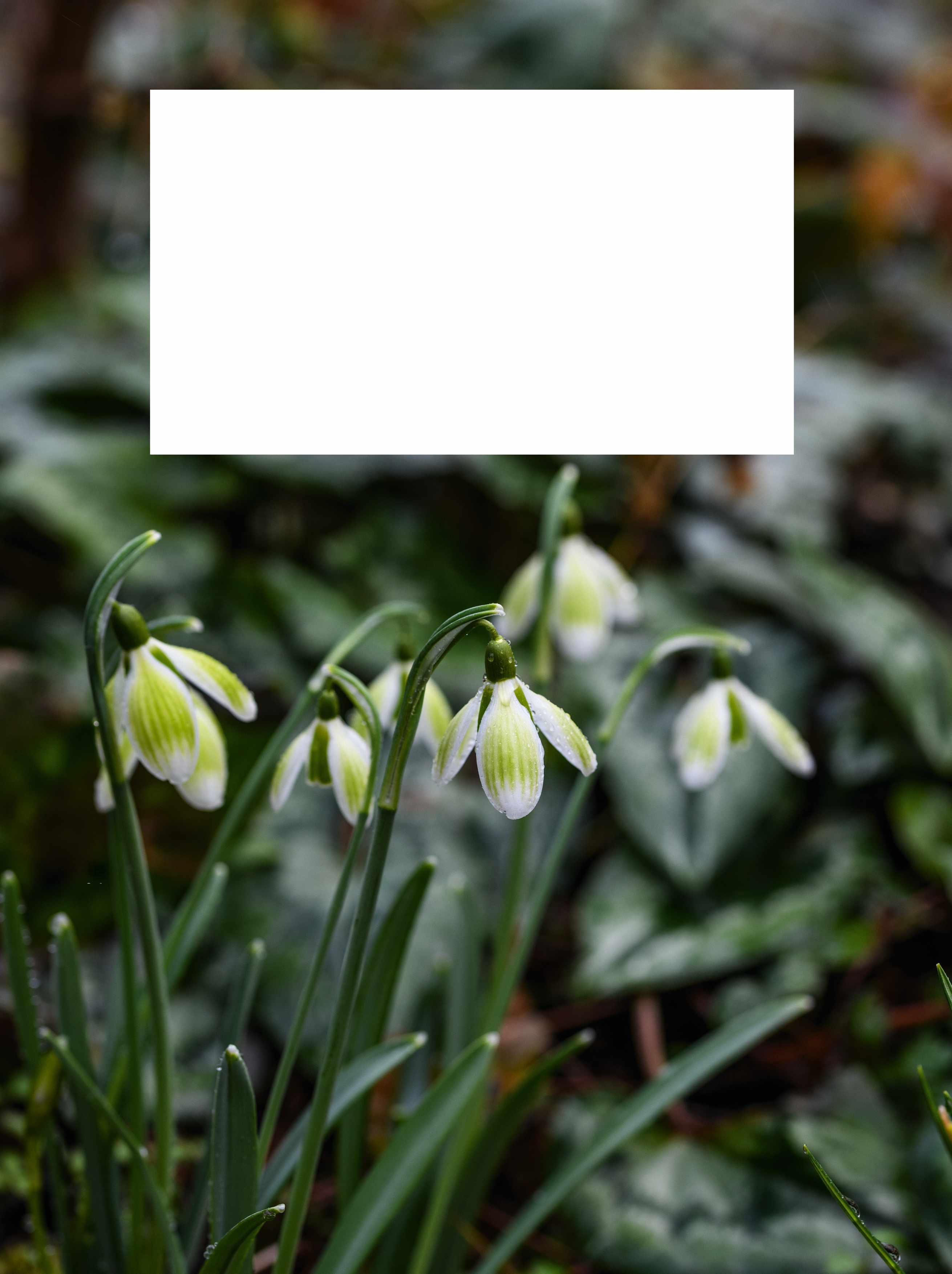
USEFUL INFORMATION
Address Woodlands, Nant Lane, Selattyn, Oswestry, Shropshire SY10 7HA (mail order only). Tel 01691 655824. Website morlasplants.co.uk
44 GARDENSILLUSTRATED.COM FEBRUARY 2023
l 10
G alant hus niv alis ‘ G r e e n Te a r ’ Robust, reliable and very green, this is considered one of the best ‘green’ snowdrops. Rare, beautiful and early flowering. 12cm.
Yellow snowdrops
As is often the case with galanthophiles, Jane’s enthusiasm for the genus was initially piqued by the beauty and rarity of a yellow snowdrop. These popular and covetable, if challenging, cultivars can be hesitant to grow, as their yellow colouring is the result of a lack of chlorophyll, the green pigment present in all plants that is responsible for absorbing light as part of photosynthesis. Most frequently spotted on the flowers, the yellow markings can also occur on the leaves and to get the best out of a ‘yellow’, the bulbs should be grown outside (rather than in a greenhouse), in a location that enjoys a lot of winter sun. Theoretically, yellow aberrations can occur on any snowdrop and so, as stands to reason, they are most commonly found in the most prolific group, Galanthus nivalis. In Northumberland yellow snowdrops, known as ‘halfers', arise spontaneously and regularly in wild clumps. Favourites of Jane’s include:

1 Galanthus plicatus ‘Golden Fleece’
The first yellow, inverse poculiform (goblet-shaped) snowdrop that broke records in 2015 when a single bulb sold for an eye-watering £1,390. Bred over ten years by Joe Sharman of Monksilver Nursery. 15cm.
2 Galanthus gracilis ‘Ronald Mackenzie’
A beautiful yellow snowdrop with delicate inner markings. 16cm.
3 Galanthus x valentinei ‘Dryad Gold Ribbon’
A superb snowdrop with a rounded bloom and a large, yellow, inverted heart on the inner segments. Late flowering. 16cm.
1 3 2
*Holds an Award of Garden Merit from the Royal Horticultural Society. †All snowdrops featured have a hardiness rating of RHS H5, USDA 4a-7b.
A family affair
At their home in Hertfordshire, Tom and Sue Stuart-Smith are working together to create a unique project to promote gardening, creativity and health
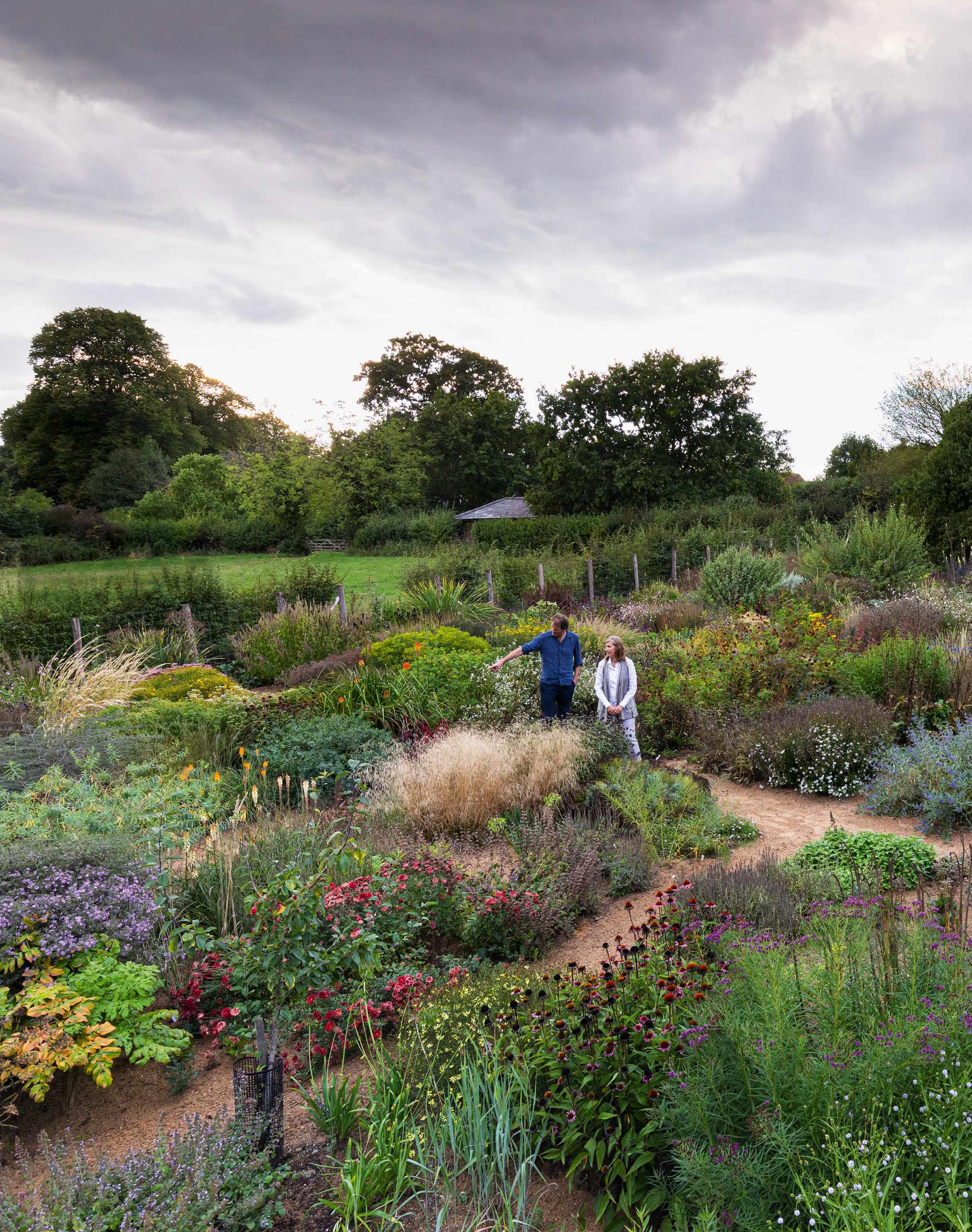 WORDS JODIE JONES PHOTOGRAPHS RICHARD BLOOM
WORDS JODIE JONES PHOTOGRAPHS RICHARD BLOOM
IN BRIEF
What Garden base for the Serge Hill Project. Where Hertfordshire. Size One acre.
Soil Varies from a no-dig approach, to layers of sharp sand, to areas of green waste. Climate Mild, damp winters; cool, dry summers. Getting warmer. Hardiness zone USDA 8.
�e Plant Library became the �rst tangible element of Tom and Sue’s broader altruistic aspirations
Just over a decade ago, Tom and Sue Stuart-Smith wrote a book, The Barn Garden, about the creation of their garden on the Serge Hill estate in Hertfordshire. It was subtitled Making a Place and described how the land, which was bought by Tom’s grandfather in 1927, has gently evolved as the Stuart-Smith family’s involvement has grown and changed.
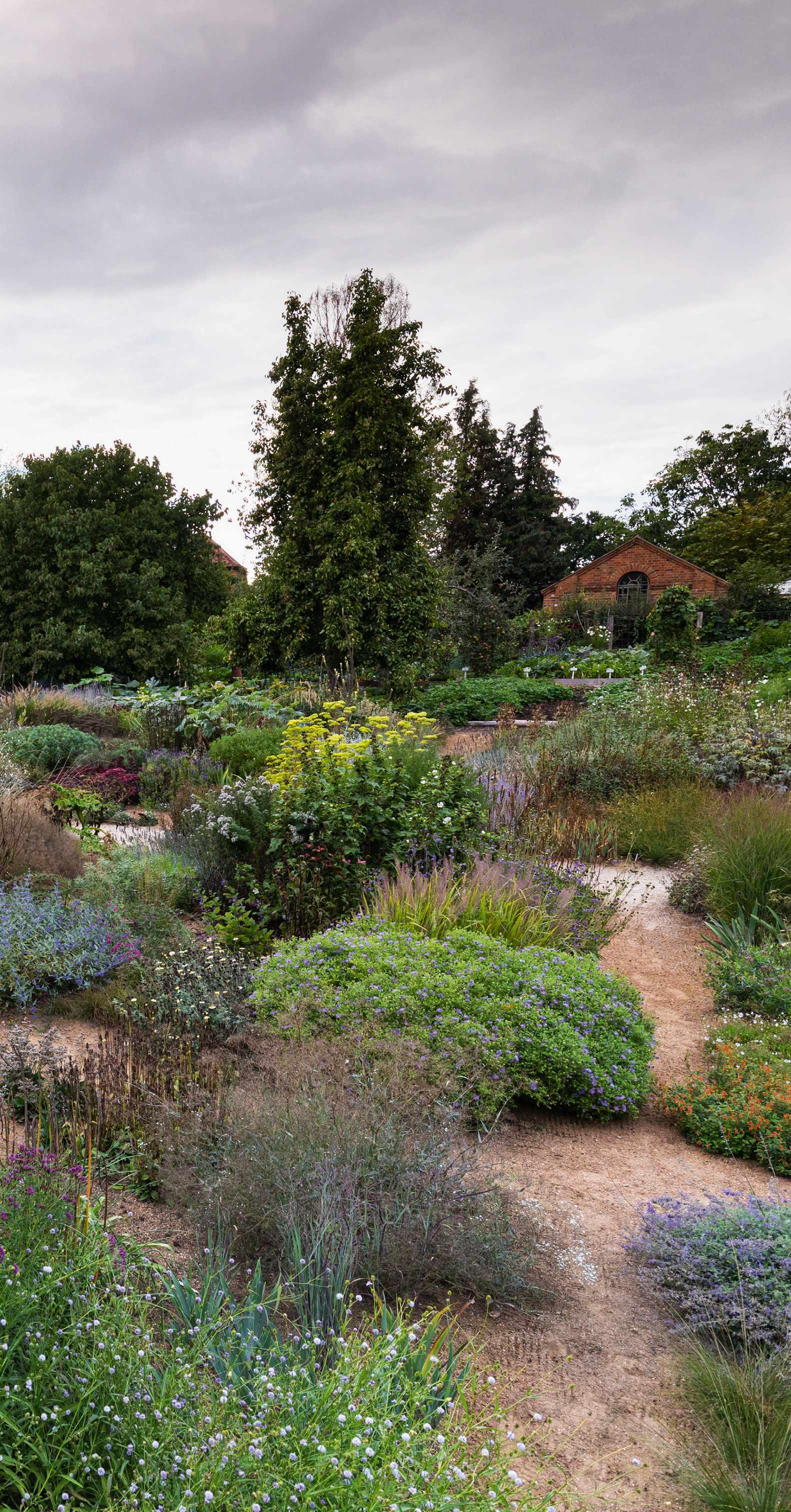
Today a new chapter is being sketched out on this same wedge of land, shaped by a recent cross-fertilisation of the couple’s individual areas of professional interest. Tom, as regular readers of Gardens Illustrated will know, is an internationally renowned landscape designer. Sue is a psychiatrist, psychotherapist and passionate advocate of the power of horticultural therapy, as she eloquently explained in her bestselling 2020 book The Well Gardened Mind.
The couple have gardened companionably together since their marriage in 1986, but their work spheres remained largely separate until Sue visited the Sunnyside Rural Trust. This Hertfordshire charity provides nursery-based horticultural training for young people with learning disabilities, and Sue was so impressed by what she saw that in 2015 she invited them to help in her vegetable garden. “It worked very well and they started coming every month,” says Sue. “Then I persuaded Tom to visit their base in Hemel Hempstead, and he was so struck by the value of their work that he suggested they set up a perennial plant nursery with expert help from Toby Marchant, of Orchard Dene nursery. Within six months Sunnyside was producing all the herbaceous plants for the garden Tom designed at RHS Hampton Court in 2021.”
This first-hand experience of horticultural therapy in practice had a huge impact on Tom, and the couple began discussing what more they could do to meld their complementary
Tom and Sue Stuart-Smith in the Plant Library at Serge Hill. Originally conceived as a reference resource for Tom’s design team, the library holds more that 1,200 different plants laid out in a highly ornamental 1m grid pattern that is divided up with paths every four to five metres, so that the different cultivars and species can be compared and contrasted. The building in the background was built by Tom’s father to resemble a local Methodist chapel.
FEBRUARY 2023 GARDENSILLUSTRATED.COM 47
interests and areas of expertise. “We wanted to share what we have here in a way that would have the maximum benefit for as many people as possible,” says Tom. “Our three children are all adults, we are effectively empty nesters, so it felt like the right time to do something. We just didn’t know quite what shape it would take.”
One of those adult children, Ben, an architect, contributed a significant piece to the puzzle when he suggested Tom give up his London office and build a studio at home. Having total control over the contents and configuration of his workspace for the first time allowed Tom to consider what he felt were the important components of a successful workplace. He wanted his 18-strong team to sit down and eat together, so he included a fully stocked kitchen where everyone now takes it in turn to cook a communal lunch. He also wanted the young designers to have firsthand experience of the plants they work with. “There is an element of enlightened self-interest in this. I want to work with good people, avoid rigid hierarchical structures, and create an environment where they can maximise their talents. Few of them have gardens of their own, so they don’t have the opportunities I’ve had to observe how plants grow and develop. That was how we came up with the idea of a plant library.”
The Plant Library became the first tangible element of Tom and Sue’s broader altruistic aspirations, which were corralled under the heading The Serge Hill Project for Gardening, Creativity and Health, and in 2020 they were granted planning permission to develop a community garden on the family’s land.
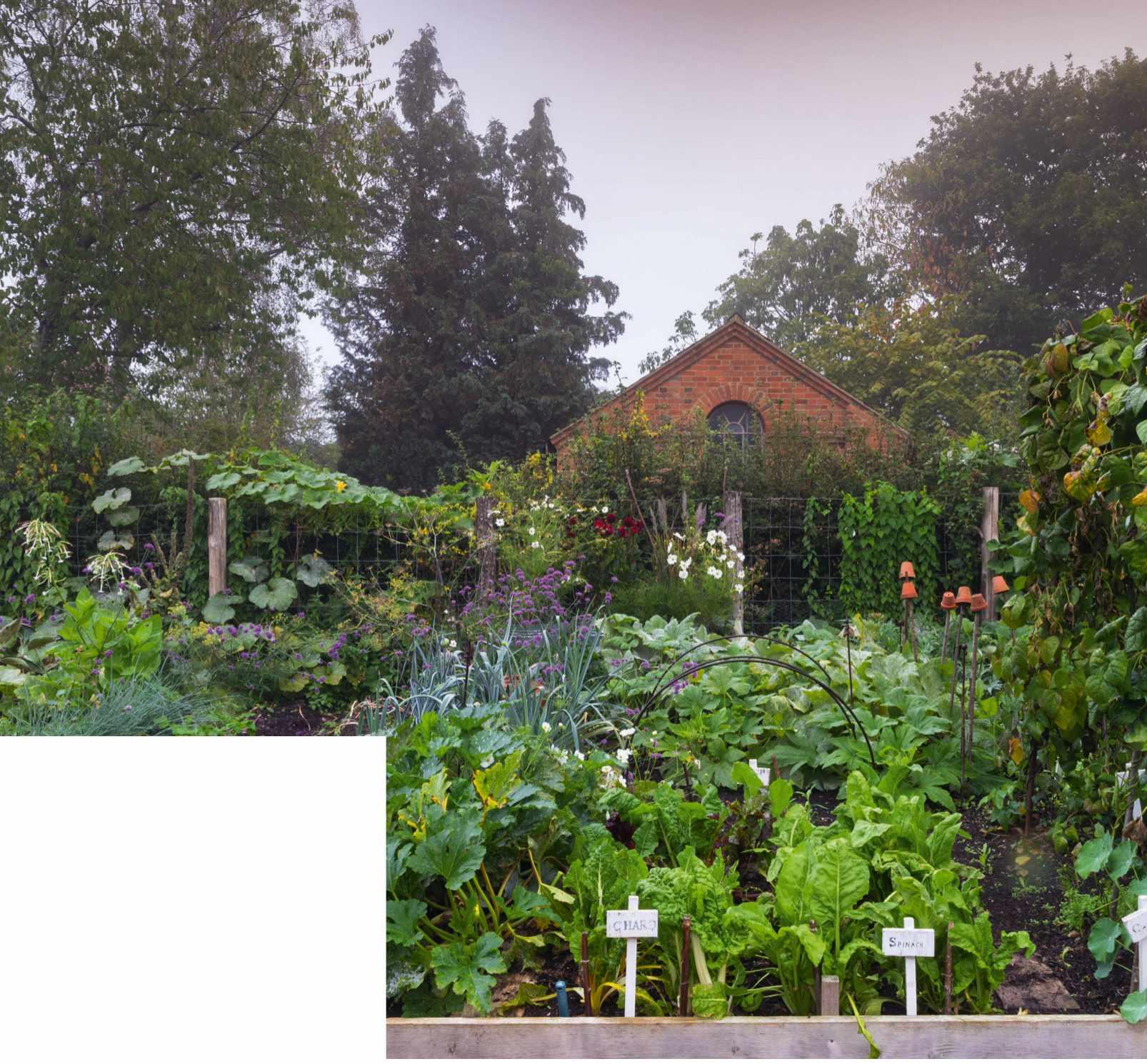
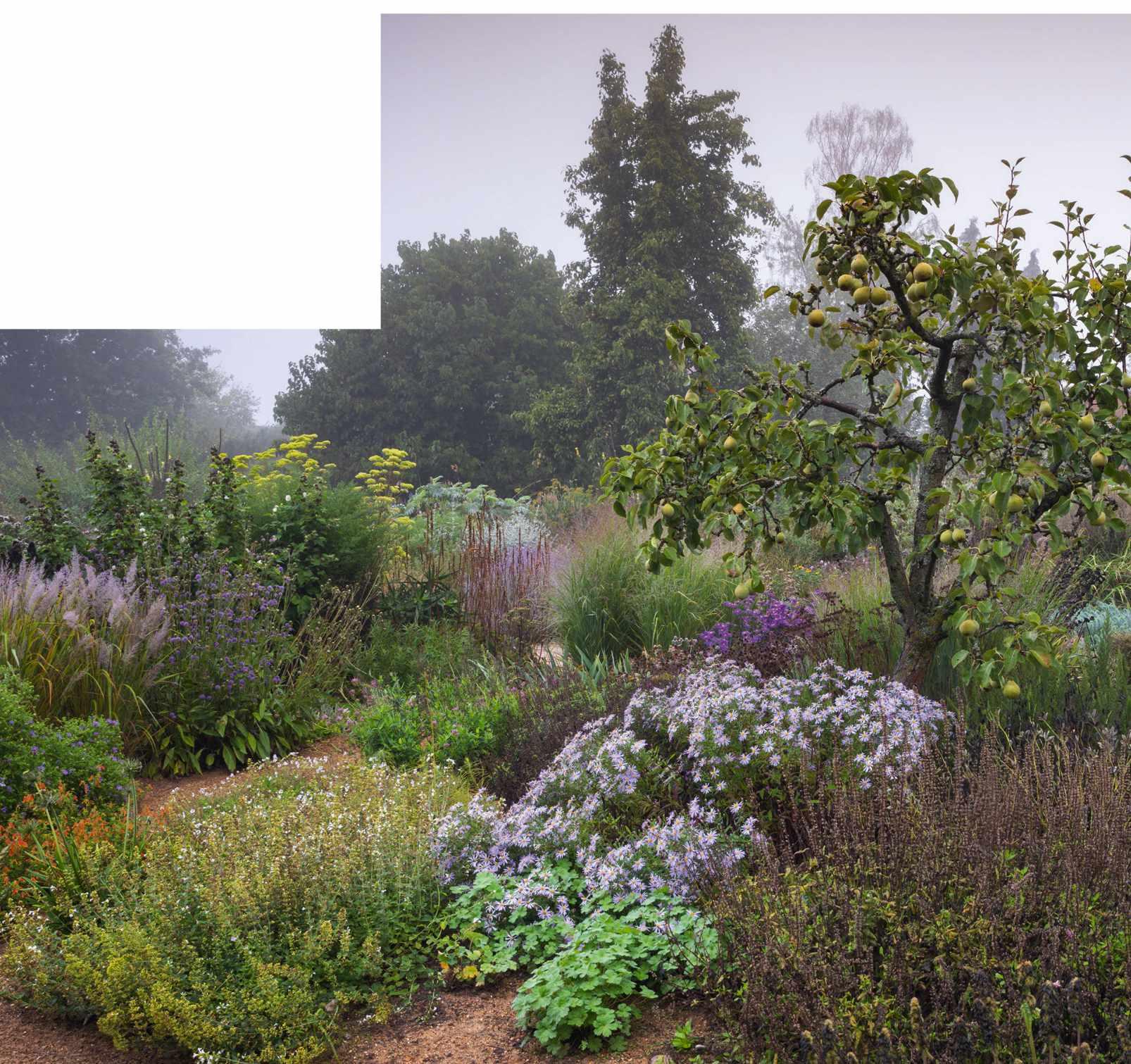
“We started with the idea of creating a reference resource that would be of use to our own studio team, but that quickly expanded to include horticulture students, garden designers and local schools,” says Tom.
“We also wanted an events space for a variety of groups that could be used as a meeting place where people could come together and support each other,” says Sue. “I visit so many wonderful therapeutic projects where the organisers are pretty isolated and would really benefit from getting together to share ideas.”
Naturally, the couple turned to their home-grown architect to design a suitably multi-functional building. Ben, co-founder of architecture social enterprise Okra, came up with a beautifully understated carbon-sink timber structure, insulated and finished
Above At the top of the site, a row of mini vegetable plots are used, allotment-style, by local residents. A local youth counselling charity also has a growing space here, and planning permission is being sought to build a mess room and nursery for the Sunnyside Rural Trust, where it can propagate and sell plants from the Plant Library.
Below Tom retained some of the fruit trees from the orchard he planted 30 years ago when the land belonged to his parents. The pear tree now sits within the sand bed area surrounded by a mix of perennials, including the purple Aster pyrenaeus ‘Lutetia’ and the tall, yellow Patrinia monandra in the background.
48 GARDENSILLUSTRATED.COM FEBRUARY 2023
I want to work with good people, and create an environment where they can maximise their talents
Above In the lower part of the Plant Library, Tom has created a temporary cutting garden dominated by a colourful mix of cosmos. Behind, Tom is trialling a range of different eupatoriums, lythrums and persicarias using green waste as the planting medium, to see what grows best in this damp and shady area.
Below A woodchip path runs between the green-waste beds on the damper and more shady part of the site. Growing below a new apple, ‘Herefordshire Russet’, is the mauve-pink aster, Cordiofontis flexuosa, which mirrors the colours of Phlox paniculata ‘Gzhel’ on the other side of the path alongside Helenium ‘Waltraut’.

in cast hempcrete and clad in shingles cleaved by hand from oaks cleared near the site. “Fortunately we ordered all the construction materials just before the pandemic hit, or we might never have started at all, but events definitely slowed us down,” says Sue.
Consequently the building is only just nearing completion, but the Plant Library garden –expertly cared for by head gardener Millie Souter – is already looking glorious. “I bought all the plants just before Covid hit,” says Tom, “so we pushed ahead with planting more than 1,200 different varieties chosen to suit the different sets of conditions, from dry sun to quite damp shade. These have been arranged in a vast and carefully catalogued grid of 1m squares, designed to showcase each specimen individually.”
Viewed as whole, Tom and Sue’s big idea is both very simple in its altruistic aspirations and enormously complicated to sum up. “What is so moving is how it works on every level. This has brought our different worlds together, and the fact is we don’t fully know what it is going to be. We want it to grow organically, based on how people respond and interact with it,” says Sue.
“We are still finalising the finances and organisation, and it has been challenging at times, but I’m not stressed by it any more,” says Tom. “It may take a while to achieve its full potential, but it is important that we do it right.” n
USEFUL INFORMATION
Find out more about The Serge Hill Project at tomstuartsmith.co.uk and suestuartsmith.com
Gardens Illustrated is hosting an exclusive reader day at Serge Hill later this year. Be among the first to find out more about this exciting event by signing up to our Events Newsletter at gardensillustrated.com/newsletters
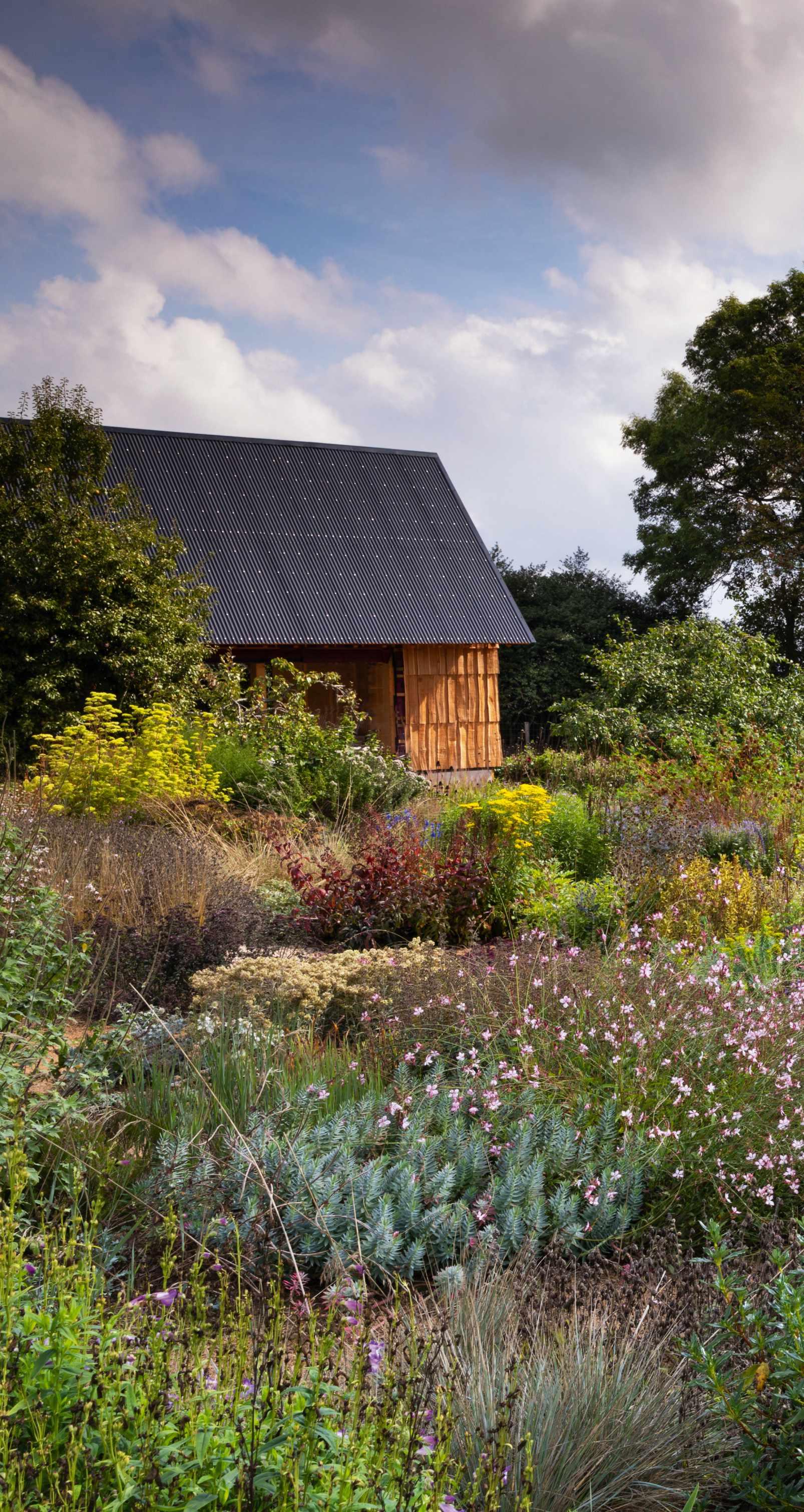
50 GARDENSILLUSTRATED.COM FEBRUARY 2023
�is has brought our di�erent worlds together and the fact is we don’t fully know what it is going to be
GI
The shingle-clad barn, designed by Ben Stuart-Smith, will be used to host schools, charities and other groups interested in gardens. It’s surrounded by droughttolerant planting that includes Eryngium pandanifolium ‘Physic Purple’, Nepeta ‘Weinheim Big Blue’ and in the foreground Penstemon digitalis ‘Huskers Red’, Oenothera lindheimeri ‘Harrosy’ and Euphorbia rigida

DEBORAH EVANS
The biggest mistake people make is thinking there can be no change,” says Deborah Evans of her work as a heritage and landscape consultant. “I’m old enough to remember the huge brouhaha that ensued when Christopher Lloyd ripped out the rose garden at Great Dixter. It set the cat among the pigeons, but as a horticulturist he knew it no longer worked.”
Although Deborah has a masters in the conservation of historic landscapes, it was two roles as head gardener for prestigious properties that gave her a particular and unusual understanding of the horticultural realities of working with historic gardens.
In 1998, she was appointed head gardener at the open-air museum at St Fagans, near Cardiff, where in addition to restoring the formal 19th-century gardens around St Fagans Castle, Deborah was in charge of recreating gardens for the ‘village’ of rescued and re-erected houses that give visitors an insight into different aspects and periods of Welsh history. “This ranged from the garden of a peasant’s house, which would have been thrown up overnight, just containing simple herbs and potatoes, to a rich yeoman’s garden with pigs, chickens and beehives, and sophisticated crops such as sea kale and salsify.” Within the gardens of a row of miners’ cottages, Deborah and her team grew flowers, such as auriculas, that are typical of those grown by 19th-century florist societies.
Her team also grew heritage potatoes, including the cultivar ‘Lumper’, a particularly blight-susceptible variety that contributed to the Irish Famine, and the Department for Environment, Food and Rural Affairs only permitted its inclusion as there were no commercial potato crops growing locally it could contaminate.
“These were just extraordinary things to grow,” says Deborah. “They also opened my eyes to the magic of plant breeding – and likewise when we grew old roses – where you can track generational improvements.” But she ripped out whole beds of ‘La France’, one of the great bedding roses of the 19th century. “It is just too disease prone. There is no point in growing it. Some old roses do very well, but often David Austin and Peter Beales just do it better.”
Deborah has no rose-tinted spectacles about the environmental standards of many historic gardens, an understanding that was brought home to her when in 2002 she was appointed as the first head gardener at Tyntesfield in Somerset after it was taken over by the National Trust. It was a massive task that involved managing 530
acres including woodlands and 11 acres of pleasure grounds with formal gardens, and a large derelict kitchen garden complex.
“We have this idea that the Victorian kitchen garden was wholesome and organic but in reality, it was anything but. It was a market garden, and they had to produce a lot so there was churn. They chucked chemicals around, happily trapped bullfinches because they ate fruit tree buds, and rolled peas in arsenic before they sowed them to stop the mice from getting them. By 2002, the ground at Tyntesfield was dead. It was completely worked out.” Alongside rejuvenating the derelict gardens and putting a robust programme of soil improvement into place, Deborah contributed to a groundbreaking multi-volume conservation plan that helped secure a £20 million grant from the National Lottery Community Fund. After Tyntesfield, she became one of Historic England’s landscape architects before setting up her own consultancy. In addition to guiding owners through the planning system, much of her work involves helping them care for wildlife, and prepare for climate change. “I am often working with woodlands and succession tree planting within estate landscapes, and there are trees we daren’t use now, such as ash and horse chestnut. More climate-resilient species, such as holm oak and sweet chestnut, are the substitutes, so some of the subtleties of our designed landscapes will be changing over the next 50 to 70 years. It is going to be interesting to see how the Pacific North West conifers, which are such a feature of our Victorian and Edwardian gardens, cope as it gets hotter.”
This is indicative of the many skills Deborah enlists when dealing with historic landscapes. “I have as much interest in the architecture, ecology, and cultural context of a site as I do of the horticulture. My role is helping people to appreciate what they have, and making them aware of the responsibilities and potential of their landscapes. Gardens and landscapes, by their very nature, are dynamic, even historic ones. They are going to change whether we like it or not. I try to act as a critical friend, finding viable solutions to modern problems.” n
USEFUL INFORMATION
Find out more about Deborah’s work at delh.co.uk
Deborah will be course leader on the Managing Wildlife in the Historic Environment course (5-8 June 2023) at West Dean College in West Sussex. Tel 01243 818232, westdean.org.uk
GARDENS AND LANDSCAPES, BY THEIR VERY NATURE, ARE DYNAMIC, EVEN HISTORIC ONES
HORTICULTURAL WHO’S WHO
The heritage and landscape consultant on the challenges of recreating the past and why all gardens, even those of historic importance, need to evolve
52 GARDENSILLUSTRATED.COM FEBRUARY 2023
WORDS LIA LEENDERTZ PORTRAIT JUSTIN FOULKES

MANY THANKS TO LYTES CARY MANOR IN SOMERSET WHERE THIS IMAGE WAS TAKEN. FOR DETAILS ON VISITING THIS NATIONAL TRUST PROPERTY GO TO NATIONALTRUST.ORG.UK
PLANT PROFILE
What Rhizomatous or tuberous perennials for the shade garden. Made up of around eight species in the Papaveraceae family, they are commonly known as bleeding hearts. Several close relatives, including Lamprocapnos spectabilis, the yellowflowered Ehrendorferia chrysantha and the climbing Dactylicapnos macrocapnos and D. scandens, have been included in Dicentra at one time.
Origins They are native to North America and parts of far eastern Asia.
Season From spring and into summer with some still flowering in autumn if growing conditions are suitable.
Size Generally, 20cm high and up to 50cm wide but depends on growing conditions, and some species and cultivars spread more vigorously.
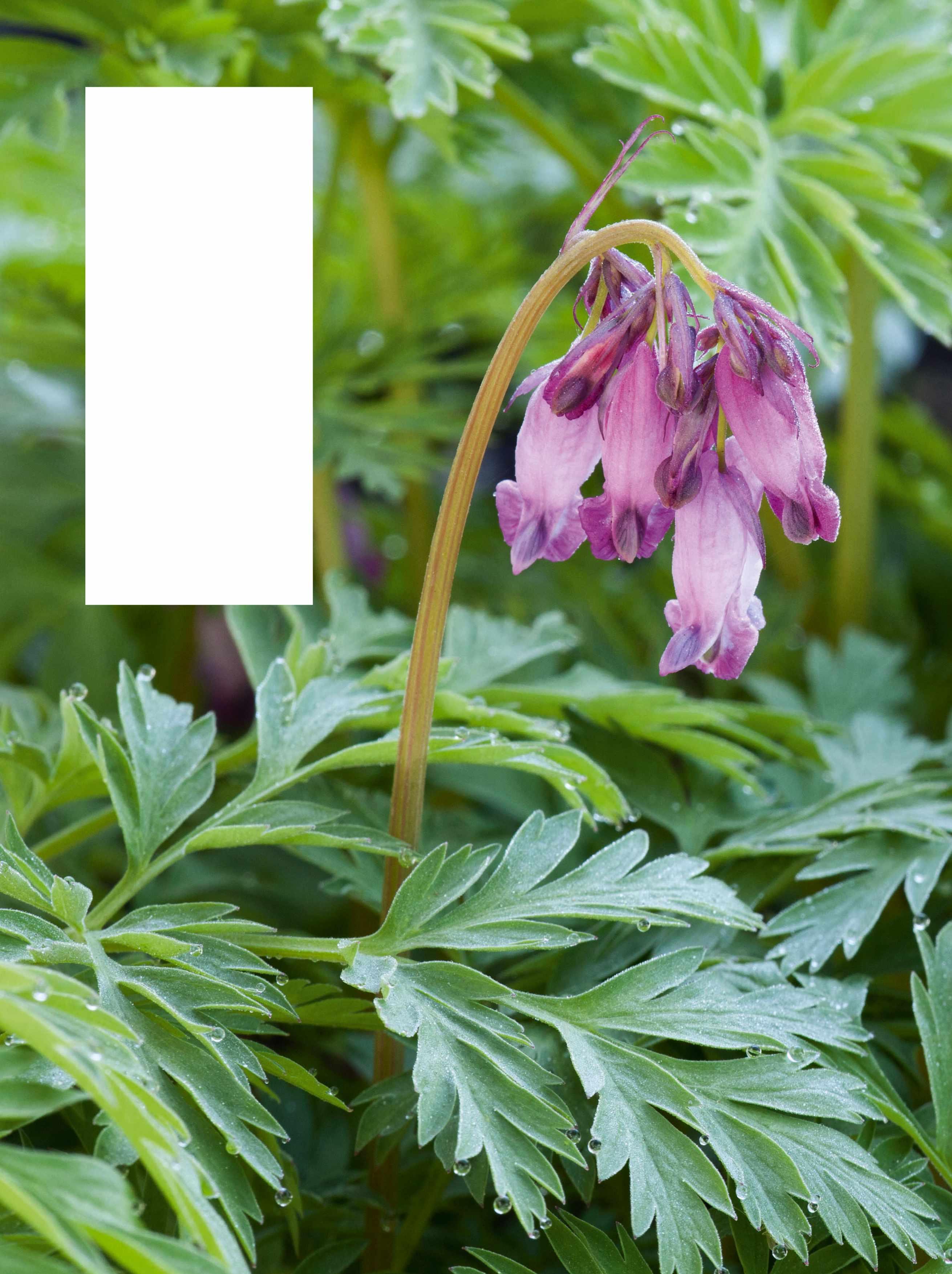
Conditions Dappled shade in humus-rich, well-drained soil that is moisture retentive.
Hardiness Hardy throughout all of the UK with RHS hardiness rating of H5-H7 and suitable for gardens in USDA zones 3a to 9b.
*Holds an Award of Garden Merit from the Royal Horticultural Society. †Hardiness ratings given where available.
DICENTRA

Low-maintenance and reliable with a long season of interest, dicentras are one of the easiest plants for shade. Plantsman Jimi Blake, who has a passion for woodland gardening, shares his favourites and explains how best to use them in shady beds
A hybrid between D. formosa and D. eximia with a compact growth habit. The leaves are silvery green throughout the growing season. The flowers are deep pink from spring until autumn as long as temperatures are not too high. 25cm x 30cm.
FEBRUARY 2023 GARDENSILLUSTRATED.COM 55
MANUELA GOEHNER / GAP PHOTOS
Dicentra ‘Luxuriant’
AGM*. RHS H5, USDA 3a-9b†
 Dicentra ‘Stuart Boothman’ Another cross between D. eximia and D. formosa, with very narrow and delicate glaucous-blue leaflets and deep-pink flowers. Named for nurseryman Stuart Boothman. 45cm x 70cm. AGM. RHS H5, USDA 3a-9b.
JONATHAN BUCKLEY / GAP PHOTOS
Dicentra ‘Stuart Boothman’ Another cross between D. eximia and D. formosa, with very narrow and delicate glaucous-blue leaflets and deep-pink flowers. Named for nurseryman Stuart Boothman. 45cm x 70cm. AGM. RHS H5, USDA 3a-9b.
JONATHAN BUCKLEY / GAP PHOTOS
A species native to the mountains of eastern North America. The foliage is grey-green and the pink flowers bloom from mid spring into summer. At Hunting Brook it is very vigorous. 30cm x 60cm. RHS H5, USDA 3a-9b.
ommonly known as bleeding hearts, dicentras are perhaps the most quintessential of woodland plants. I could not imagine gardening without their filigree foliage and heart-shaped pendulous flowers. Held on arching, leafless stalks, these flowers move in the slightest breeze in cool, humid, shady gardens. Perhaps the plant most people think of as the typical bleeding heart is the species once called Dicentra spectabilis, and the only reason I’ve not included it here is that it has now changed its name to Lamprocapnos spectabilis
Dicentras are mainly suitable for the shady parts of the garden, where they start flowering in spring and continue into summer and autumn, depending on the species or cultivar and growing conditions. Dicentras are plants with an incredibly long season, and should be used in all shady gardens. They are native to cool, humid woodlands in North America and Eastern Asia.
Like many woodland plants at my garden Hunting Brook, they can grow in brighter areas as long as the soil does not dry out. So, even if you don’t have the recommended dappled shade, it’s worth experimenting with Dicentra
The first one that I grew here in Hunting Brook was Dicentra formosa ‘Bacchanal’ with its wonderful filigree, glaucous-blue foliage and deep-red pendulous flowers. For me, this is still
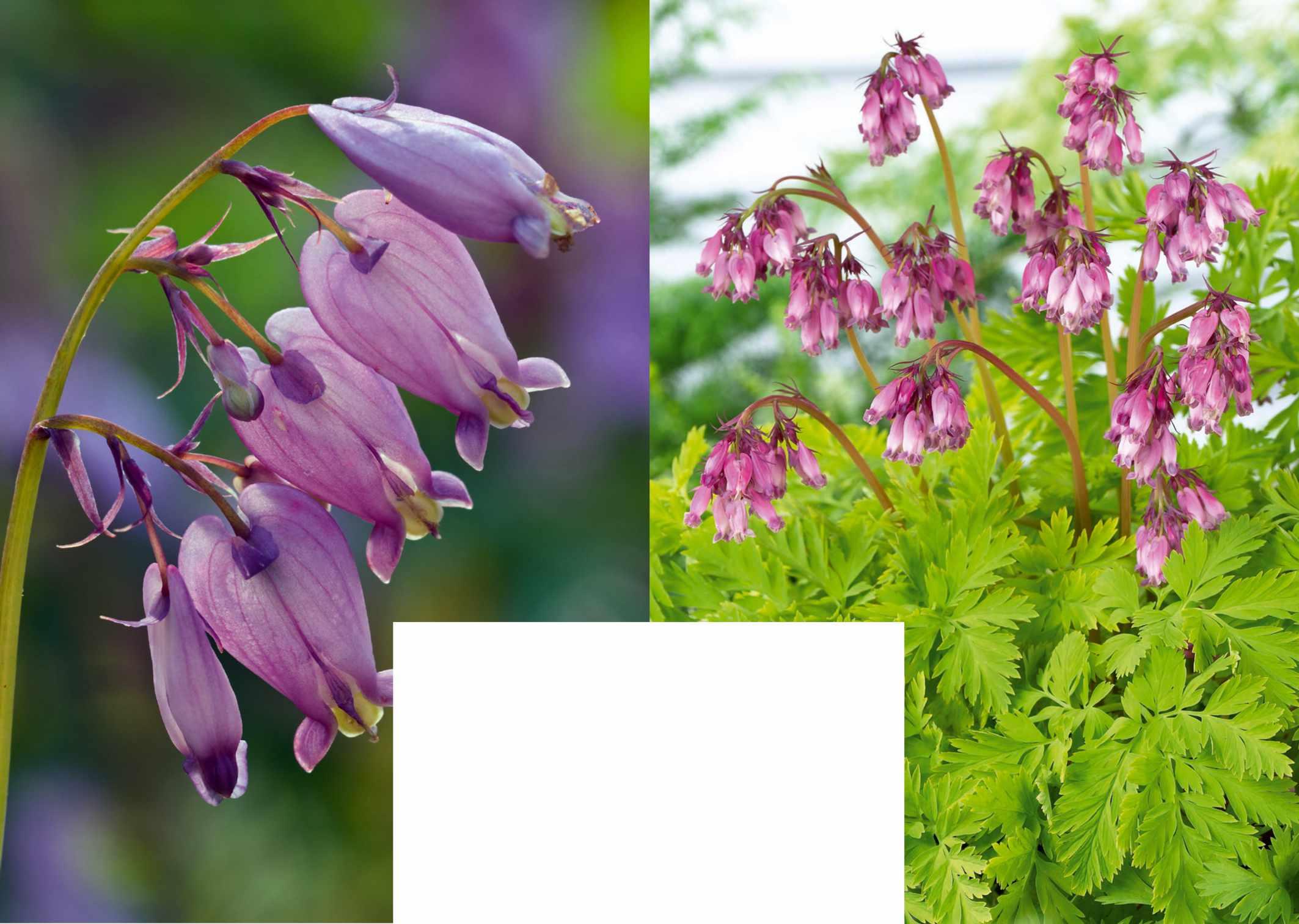
‘Spring Gold’
Worth growing for its long season – from spring through to autumn – of fresh, chartreuse-yellow foliage, which brightens up a shady area. It has soft-pink flowers from May to July. 45cm x 70cm. RHS H7.
one of the best and the one that I highly recommend for everyone to grow. At the moment it is in a battle for space with Chrysosplenium macrophyllum. I am closely monitoring the battle to make sure I lose neither of them.
Some species, including Dicentra canadensis and Dicentra cucullaria , are spring ephemerals, which flower in spring and go dormant by the summer months. These are less vigorous species so it’s good to grow them with plants that will not outgrow them. Woodland perennials that emerge late, such as roscoeas, work well combined with this type of Dicentra , and will help to fill the gap in flowering.
Don’t plant the very vigorous species, such as Dicentra eximia and Dicentra formosa, with less vigorous precious woodland plants. Dicentra eximia is the most invasive species in the genus for me. It’s very useful in the wilder areas of the woodland where I need good groundcover and it can spread vigorously. It can spread too fast in the garden so I have it banished to the valley where it performs well and doesn’t gobble up its neighbours. Two others that will spread are Dicentra formosa ‘Langtrees’, one of my favourites, which flowers from spring to autumn, and Dicentra ‘Stuart Boothman’ with its filigree foliage.
Some of the dicentras I grow can flower from spring through summer and into autumn, including Dicentra ‘Pearl Drops’ and Dicentra ‘Luxuriant’.
To continue turn to page 61
J S SIRA, VISIONS / BOTH GAP PHOTOS
C
Dicentra formosa
Dicentra eximia
Dicentras are plants with an incredibly long season, and should be used in all shady gardens
FEBRUARY 2023 GARDENSILLUSTRATED.COM 57
Has beautiful blue-grey, finely dissected foliage emerging in early spring. The flowers are a deep pink in late spring and sporadically reappear until autumn. Looks wonderful combined with snowdrops. 30cm x 60cm.

JASON INGRAM
Dicentra ‘Filigree’
RHS H7.
Dicentra formosa ‘Aurora’ Glaucous-grey leaves from early spring to winter. The white flowers appear from May to September. Originally bred by the late nurseryman Ernst Pagels in Germany. A hybrid between D. formosa and D. eximia. 45cm x 70cm. RHS H7, USDA 3a-8b
How to grow Dicentra

• Dicentras need well-drained, humusrich soil in dappled shade to perform well. When I plant dicentras I like to incorporate compost into the planting hole to give them a good start in life. In very wet soil they can die out so avoid soil that gets water logged at any time of year.
• New growth can occasionally get frosted, if you get very cold, frosty weather in late spring, but the plants always bounce back into growth for summer. If you live in an area of very high summer temperatures dicentras may go dormant to store their energy. When temperatures drop towards the end of the summer they should reappear.
• The most successful and easiest way to propagate dicentras is by division. I divide mine in late winter to early spring when they are just starting into growth
Dicentra ‘King of Hearts’
This is a cross between D. peregrina, D. formosa subsp. oregona and D. eximia. The foliage is glaucous-grey from early spring to the end of autumn. Dark-rose flowers appear from May until August. 45cm x 75cm. RHS H7, USDA 3a-8b.
by putting the divisions into pots of compost. These will be ready for planting out in early summer.
• You can also propagate dicentras by seed, which is best collected in summer or early autumn and sown fresh. In their native habitat and sometimes in the garden, ants disperse the seeds. Leave pots of freshly sown seed in a cold frame over winter so they are exposed to the cold of the winter months. Germination usually takes place in spring, but I find propagation by division to be the fastest and most successful method.
• Dicentras are generally disease free, but very occasionally they can get downy mildew and rust. When this happens cut them back, water with a liquid seaweed feed and add a 5cm mulch of compost on top.
• Cut back any plants that look untidy after flowering, or any time during the summer months, to ground level. Give them a good watering, if the soil is dry, and mulch with 5cm of compost. After this cutting back, they will usually send up fresh foliage and often flower again. By keeping the fresh look in the shade garden in late summer and autumn you extend the season. When mine look scruffy in autumn or early winter, I cut them to the ground and add compost to the area.
• Some dicentras contain alkaloids in the leaves, which can be poisonous if eaten and can cause skin allergies.
• Consider growing plants in raised beds so you can fully enjoy their flowers and pendulous habit. I grow mine in my woodland borders, which are slightly raised up and surrounded by paths so I can view the plants from each side.
TOMMY TONSBERG, FHF GREENMEDIA / BOTH GAP PHOTOS
FEBRUARY 2023 GARDENSILLUSTRATED.COM 59
Dicentra canadensis
Glaucous-blue, filigree type foliage with creamy-white flowers. Native to eastern North America, where it is sadly endangered, it is a spring ephemeral, flowering in spring and going dormant for summer. 20cm x 30cm. RHS H7.
Dicentra ‘Ivory Hearts’
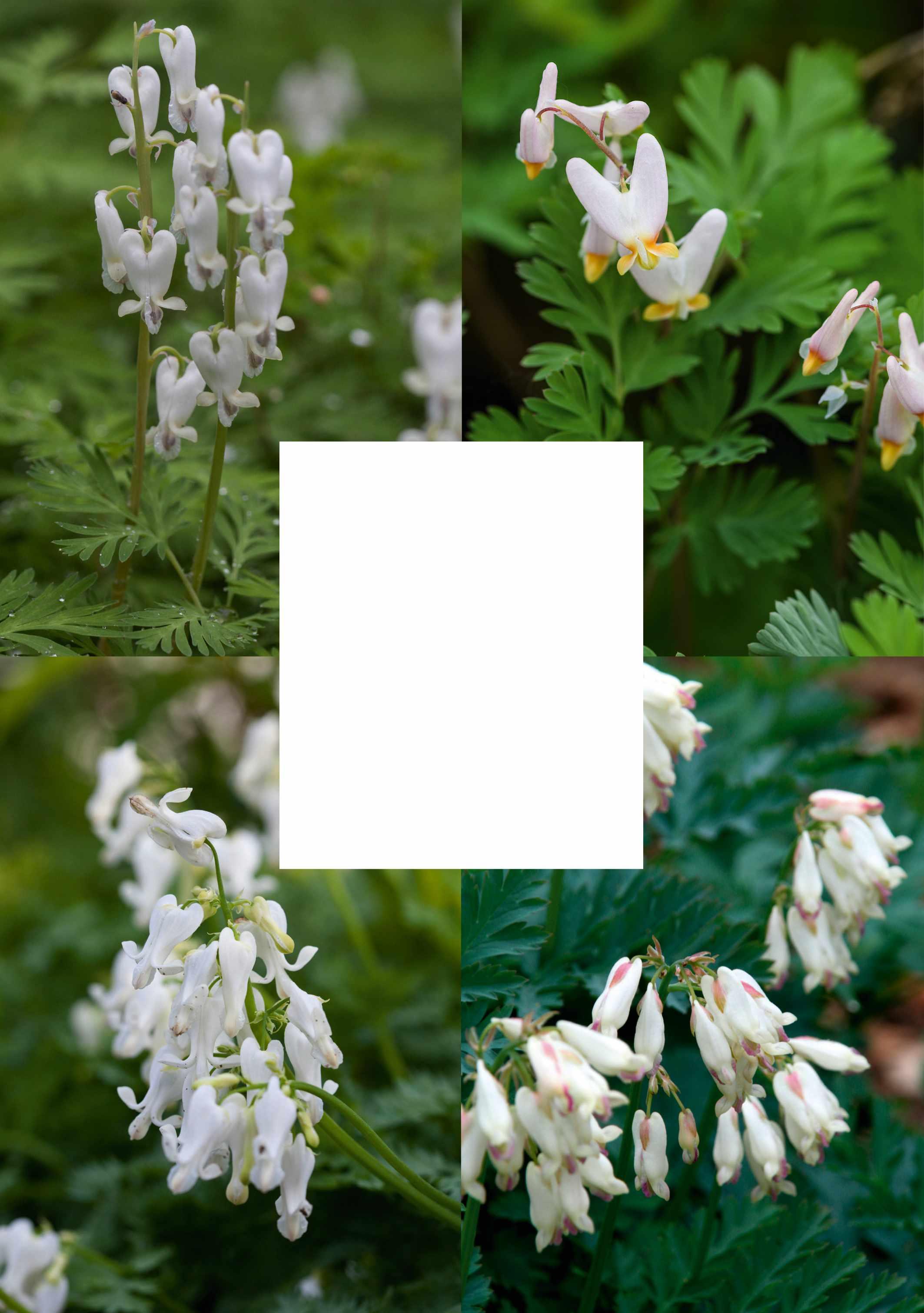
A beautiful cross between the Japanese hybrid D. peregrina and D eximia ‘Alba’, with a long flowering season. It has ivorycoloured flowers and glaucous-coloured foliage. 25cm x 70cm. RHS H5, USDA 3a-8b.
Dicentra cucullaria
‘Pittsburg’
This compact Dicentra has grey-green foliage with pale-pink flowers that have a yellow-orange base. They are usually summer dormant, especially in warmer climates. 15cm x 25cm. RHS H7.
Dicentra formosa
‘Langtrees’
One of the longest flowering dicentras, with attractive, silvery-grey leaves. Flowers are a creamy pink over a long season from spring to winter. 45cm x 45cm. AGM. RHS H5.
THIS PAGE: TOMMY TONSBERG / GAP PHOTOS, JASON INGRAM, MARTIN HUGHES-JONES / ALAMY STOCK PHOTO FACING PAGE: GARDENWORLD IMAGES / TREVOR SIMS, VISIONS / GAP PHOTOS.
Fern-like, greenish glaucous leaves from spring to autumn. The flowers are deep crimson from late spring through summer. One of my most asked about woodland plants. 25cm x 70cm. AGM. RHS H5, USDA 3a-9b.
These would be my first choice if space is limited and you want interest over a long season. The beautiful filigree foliage looks wonderful if combined with larger leaves to create contrast in dappled shade. My favourite cultivar for good foliage is Dicentra formosa ‘Spring Gold’ with its chartreuse-coloured leaves. Dicentra ‘Filigree’ has very fine, fern-like foliage and Dicentra ‘Aurora’ has the most beautiful silver-grey green leaves from spring through to winter.
I generally use dicentras as groundcover or as a carpet beneath other woodland plants that have tall stems and pendulous flowers, such as polygonatums, Disporum and Maianthemum, which look so much better growing with Dicentra rather than just bare soil. Dicentras can also look good with those epimediums that have interesting foliage such as Epimedium acuminatum and Epimedium wushanense.
I like to combine them with plants that have larger leaves, such as Pulmonaria ‘Miss Elly’ with its round leaves and deepblue flowers, or Pulmonaria ‘Blake’s Silver’, an introduction by my sister June, which has large silver leaves. Another great plant to combine with them is Podophyllum pleianthum with its tall stems and round leaves. If combining dicentras with bulbs you need to be careful when choosing which bulbs to partner with them, as
A beautiful cultivar with glaucous-blue foliage and rich, deep-red flowers over a long season from May to September. It is a compact cultivar so looks good growing in pots or on the edge of a shade bed. 25cm x 40cm. RHS H7, USDA 4a-8b.
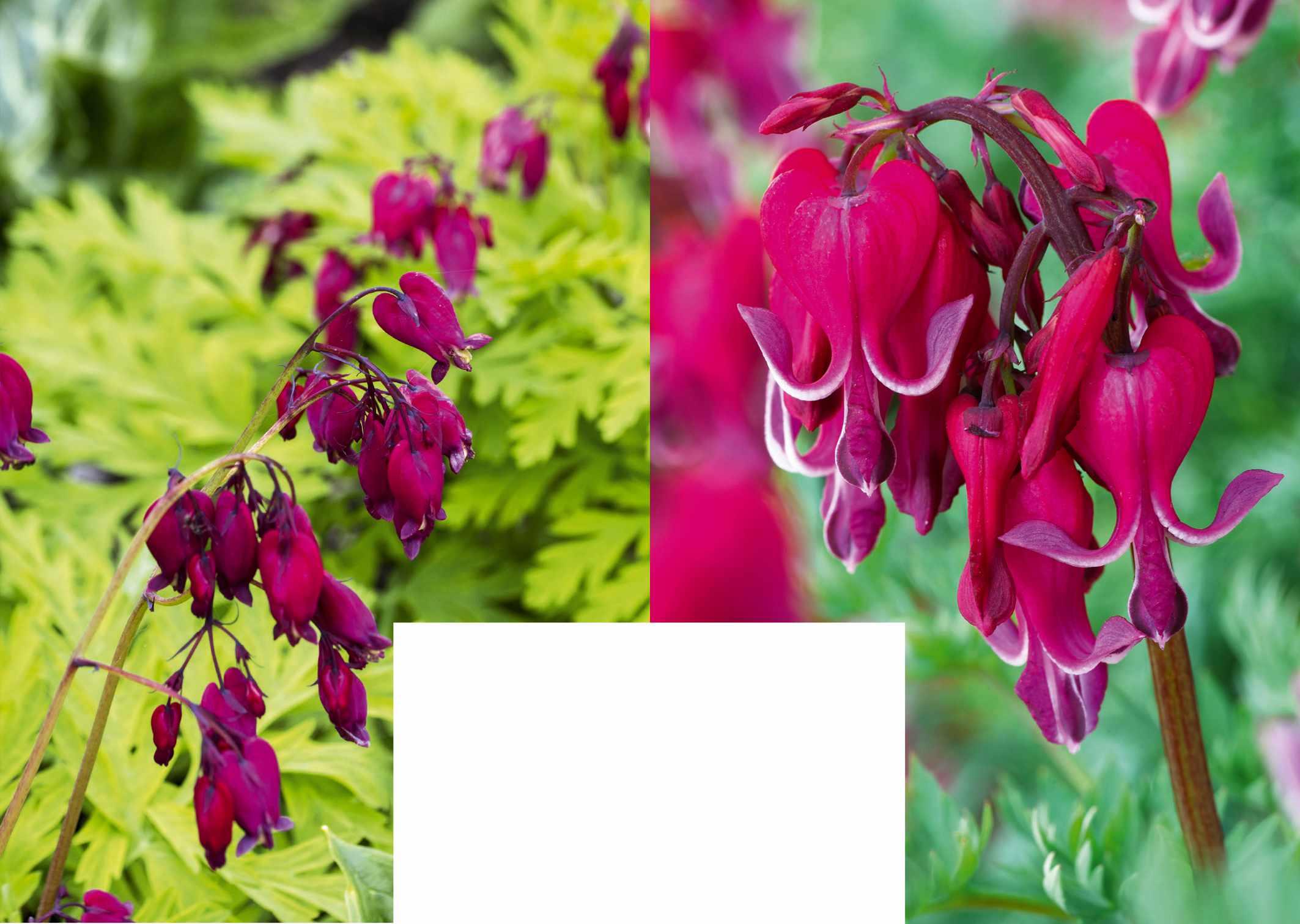
the dicentras can grow too vigorously for the less-vigorous bulbs. I have a huge snowdrop collection here at Hunting Brook and find that only the most robust snowdrops will grow happily alongside the dicentras.
I highly recommend growing dicentras in your garden as they really are one of the easiest, low-maintenance plants for shade, reliable to grow and with a long season of interest. n
Jimi Blake is a plantsman and author and the owner of Hunting Brook Gardens near Dublin.
Where to see and buy
• Beth Chatto’s Plants & Gardens Clacton Road, Elmstead Market, Elmstead, Colchester, Essex CO7 7DB. Tel 01206 822007, bethchatto.co.uk
• Edrom Nursery Coldingham, Eyemouth, BerwickshireTD14 5TZ. Tel 01890 771386, edrom-nurseries.co.uk
• Hunting Brook Gardens Tinode, The Lamb Hill, Co. Wicklow, W91 YK33 Ireland. Tel +353 (0)87 285 6601, huntingbrookgardens.com
Open April – September, Wednesday – Saturday, 11am-4pm.
• Pineview Plants, Orchard Place Business Centre, Wrotham Heath, Seven Oaks, Kent TN15 8QU. Tel 01732 882945, pineviewplants.co.uk Open to visitors by appointment only.
Dicentra formosa ‘Bacchanal’
Dicentra ‘Red Fountain’
FEBRUARY 2023 GARDENSILLUSTRATED.COM 61
I generally use dicentras as groundcover or as a carpet beneath other woodland plants
EVERLASTING WREATH
Bex makes her wreaths in a half-moon shape, which has become her signature style. Here she has used a base of woven and twisted vine stems to create the shape, and then has woven in pink and white dried baby’s breath (Gypsophila), flu�y seedheads of old man’s beard (Clematis vitalba), and dried heads of Achillea ptarmica ‘The Pearl’. The result is an airy, almost cloud-like, wreath.
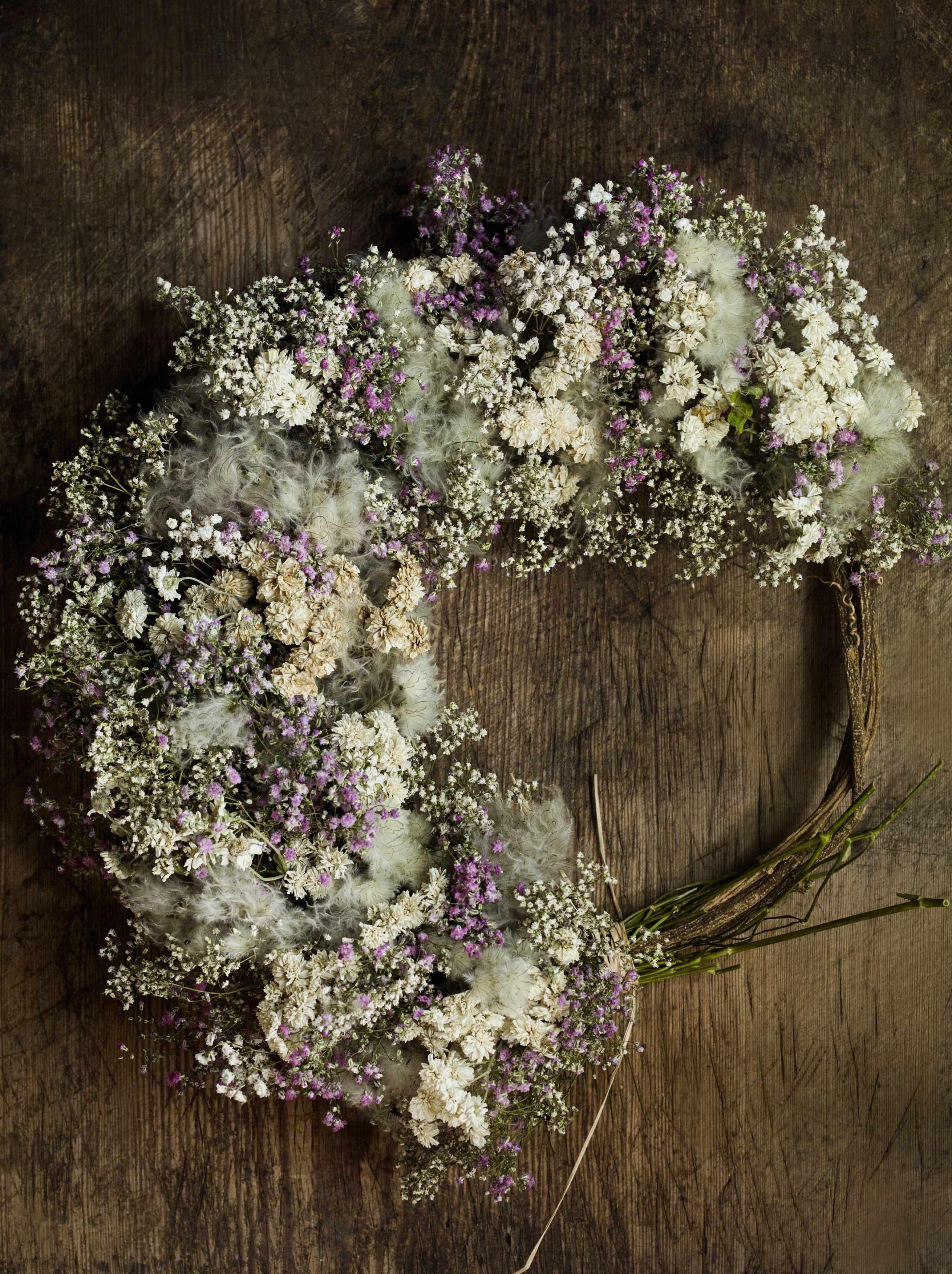
Enduring loves
Bex Partridge’s dried-flower creations preserve the fleeting beauty of flowers, foliage and seedheads
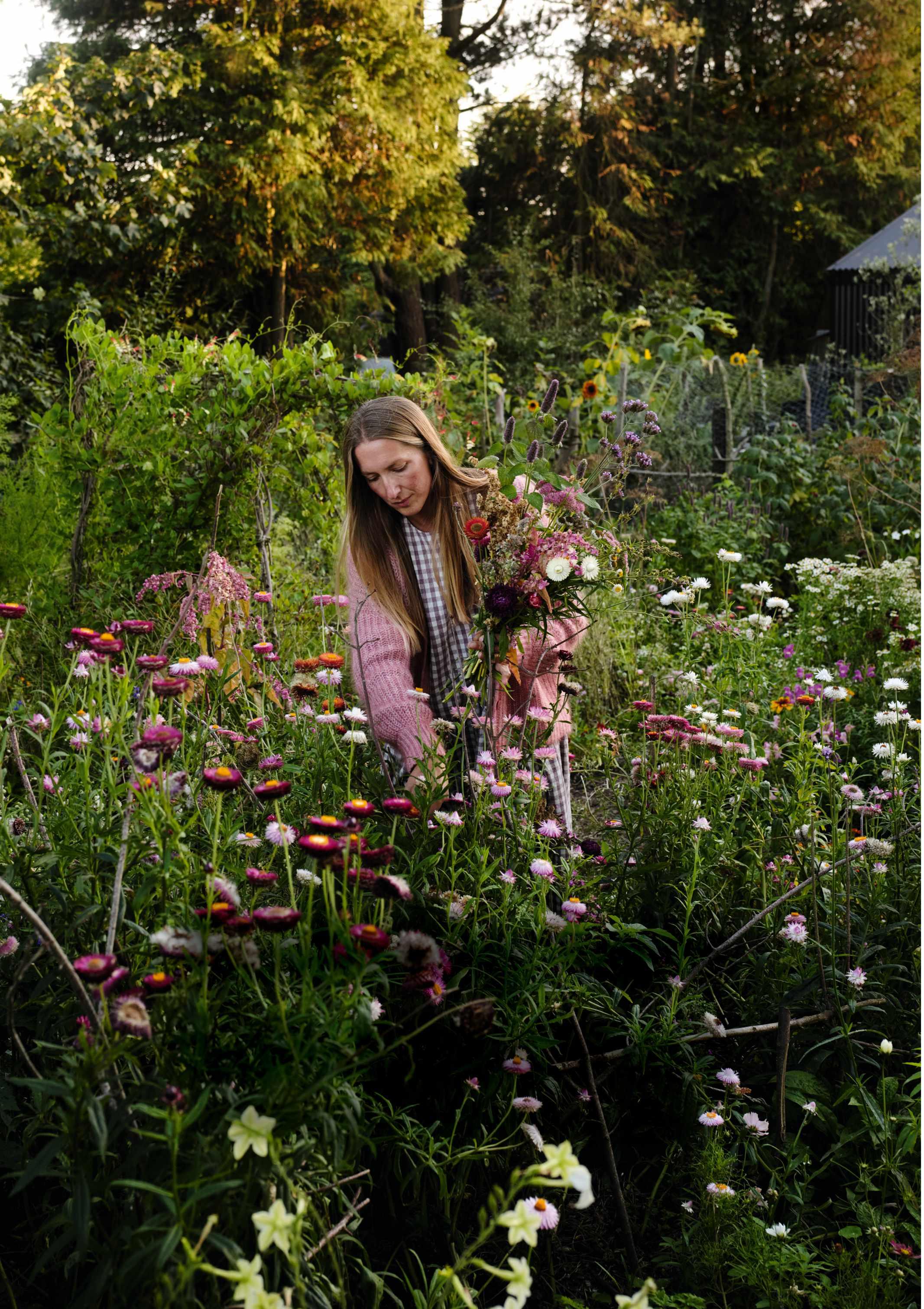
FEBRUARY 2023 GARDENSILLUSTRATED.COM 63
WORDS LIA LEENDERTZ PHOTOGRAPHS ANDREW MONTGOMERY
Floral artist Bex Partridge picks fresh Xerochrysum bracteatum from her garden on the DevonDorset border. These she dries in her studio to create her beautiful dried bouquets and wreaths.
Left As well as being
Below An everlasting floral display, featuring winged everlastings and sea lavender alongside ethereal dried dahlias, held in place with a vintage metal flower frog nestled in a hand-crafted ceramic bowl.

Bex Partridge’s studio is an ethereal, grotto-like space. Rack upon rack of dried flowers hang down, the petals puckering and twisting as they dry. Xeranthemums crowd one window while single dahlias dangle in front of another. There are delicately hued plant-dyed ribbons draped from a branch, and vases of dried flowers on every surface. But perhaps the most surprising thing is the almost overwhelming scent.
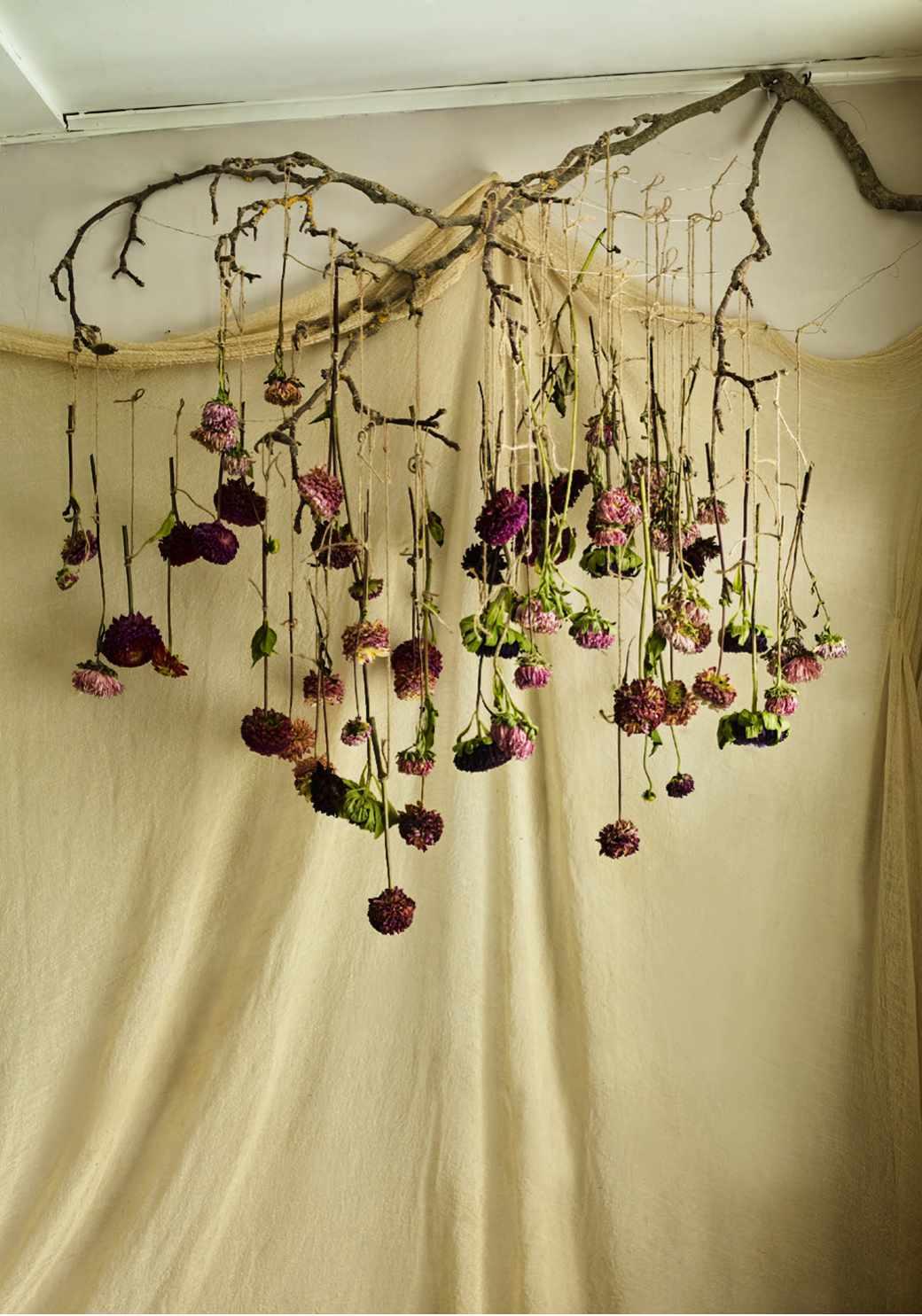
“Most people don’t expect the scent,” says Bex. “It is a bit like opening a spice drawer, if more floral. At the moment I have lots of artemisia drying here and the smell is divine.”
The studio is in the half-acre garden of the house on the DevonDorset border where she lives with her husband and two sons, and overlooks her flower patch. But she started her dried-flower business when they lived in Surrey. “I had always worked in corporate officebased jobs, but I always gardened.” When her second son was born, she found that life had slowed down. “I was noticing things. I began growing more and shifted our allotment to flowers. And then I left a bunch in a vase until they dried out and my interest was piqued.”
She started putting together wreaths and bouquets, and selling them via a website and Instagram, and now she is often commissioned to create dried-flower installations for people’s homes and for retail spaces: delicate curtains of floating single flowers or floral boughs dripping with amaranth and hops. She loves the subtlety of dried flowers. “I know it’s not a popular opinion but I don’t particularly love fresh dahlias. I find them exuberant and hard to work with. But when you allow them to dry, they are stunning. It’s the muted tones, the softness, the textures, the intricacies. Dried flowers draw you in.”
When they moved in 2020, it was with the hope of living a life that was more in tune with the natural world, and dried flowers fit well

64 GARDENSILLUSTRATED.COM FEBRUARY 2023
This image Dahlias and asters hang from a magnolia branch to dry out in Bex’s studio.
practical, hanging bunches of flowers upside down for drying also makes a stunning display in Bex’s compact work space.
DRIED FLOWER BOUQUET
“Dried flower bouquets can make beautiful gifts for friends and loved ones,” says Bex. “It is a way of extending the best of the summer blooms.” Here she has combined lady’s mantle (Alchemilla mollis), with strawflower (Xerochrysum bracteatum ‘Silvery Rose and White’), quaking grass (Briza media) and white larkspur (Consolida ambigua).
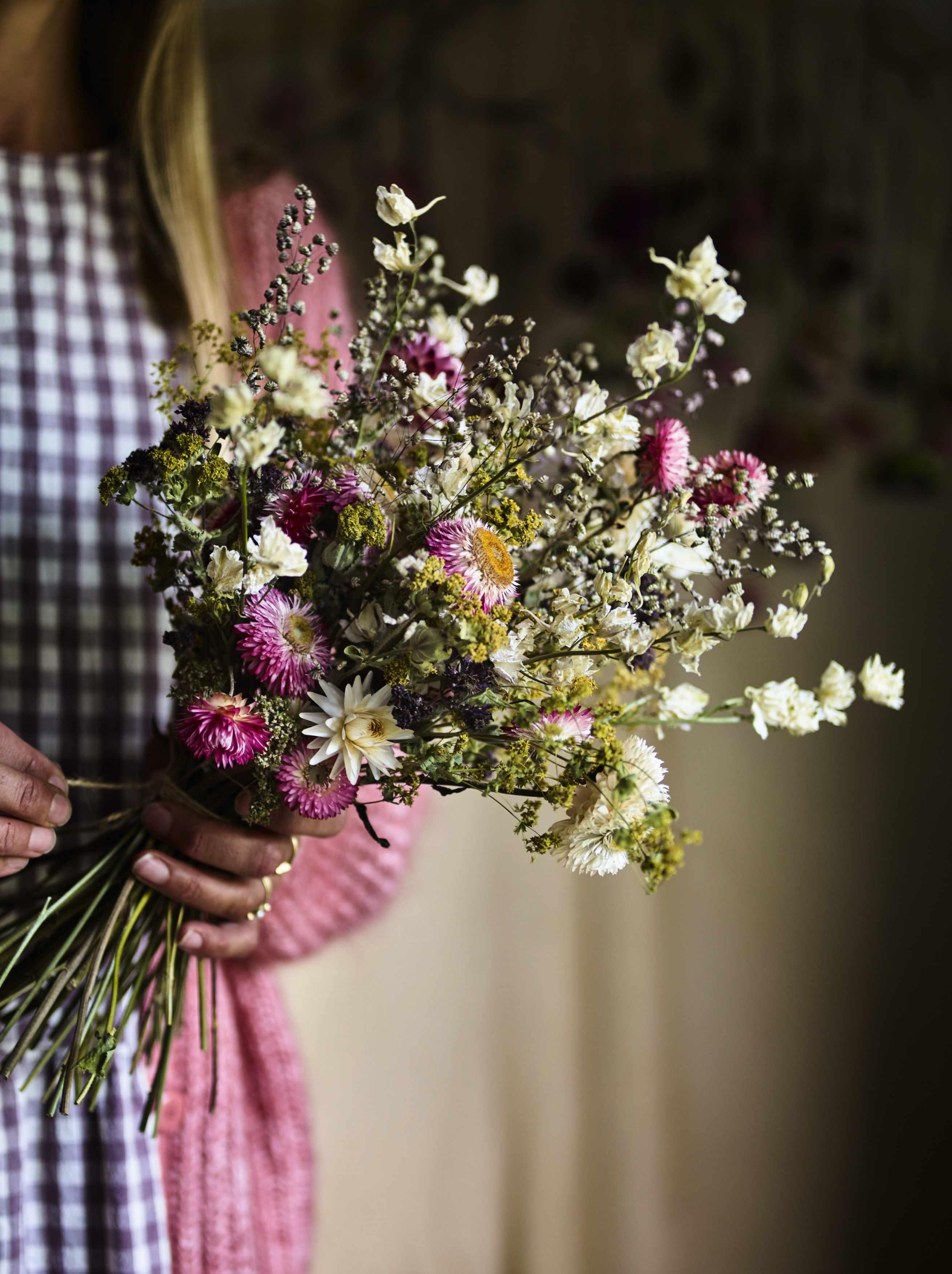
FLOWER CROWNS
Bex uses coated wire to create the bases for her flower crowns, which are popular with brides as they can be kept for many years and hung on the wall for decoration. Here she has used the winged everlasting flower Ammobium alatum combined with Origanum ‘Kent Beauty’, an astrantia and Cupid’s dart (Catananche caerulea) seedheads, finished with a natural-dyed ribbon. Bex only uses plant-dyed ribbons, which tone in with the soft muted colours of her pieces.

Bex’s tips for drying �owers
“I always say anything dries,” says Bex. “It’s whether you are willing to accept that thing as dried and not dead.”
• Dry flowers in a room with ambient temperature. They will fade if kept too hot and grow mouldy if too cold. They don’t need to be dried in the dark, but out of direct sunlight is best. Avoid bathrooms and kitchens, because of their humidity.
• Pick flowers when they are at their best, so when they are open but not yet going to seed.
• Pick seedheads and grasses when they are still ‘in the green’ in the most part. If you pick them when they are already turning brown they will turn brittle and be hard to work with. They will also as scatter their seeds across the floor of your drying room.
• Pick tall spire flowers, such as nepeta, larkspur and delphinium, when the bottom half is in flower and the top half still in bud, or you will lose the bottom flowers as they dry.
• The majority will dry best hanging upside down. Make bunches of five to ten stems, tie with a piece of string and hang. They look beautiful hanging out to dry so if you are short on space consider making a display out of them.
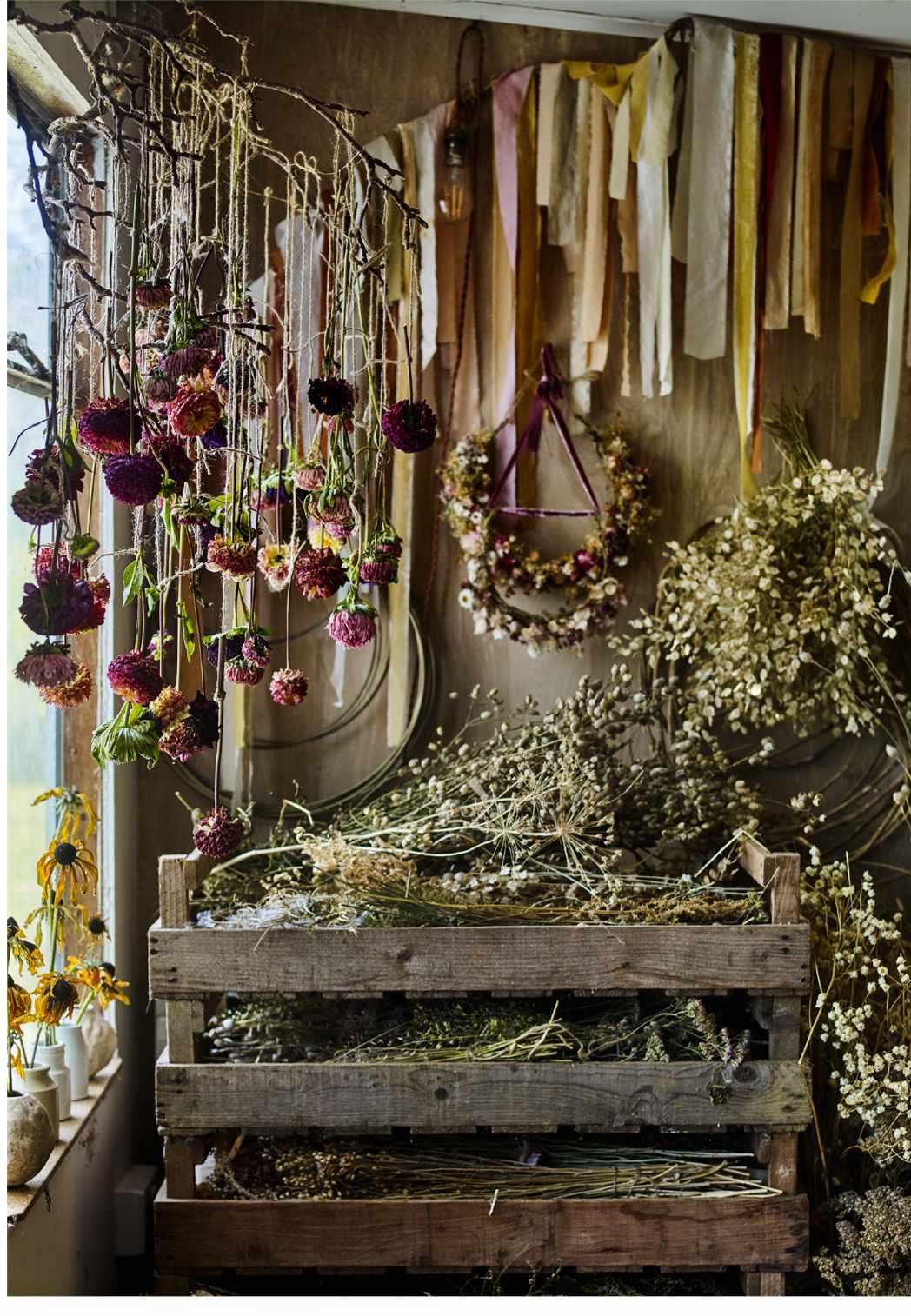
• Anything fleshy, such as dahlias, asters and peonies, should be hung individually to allow as much air as possible to circulate around the petals.
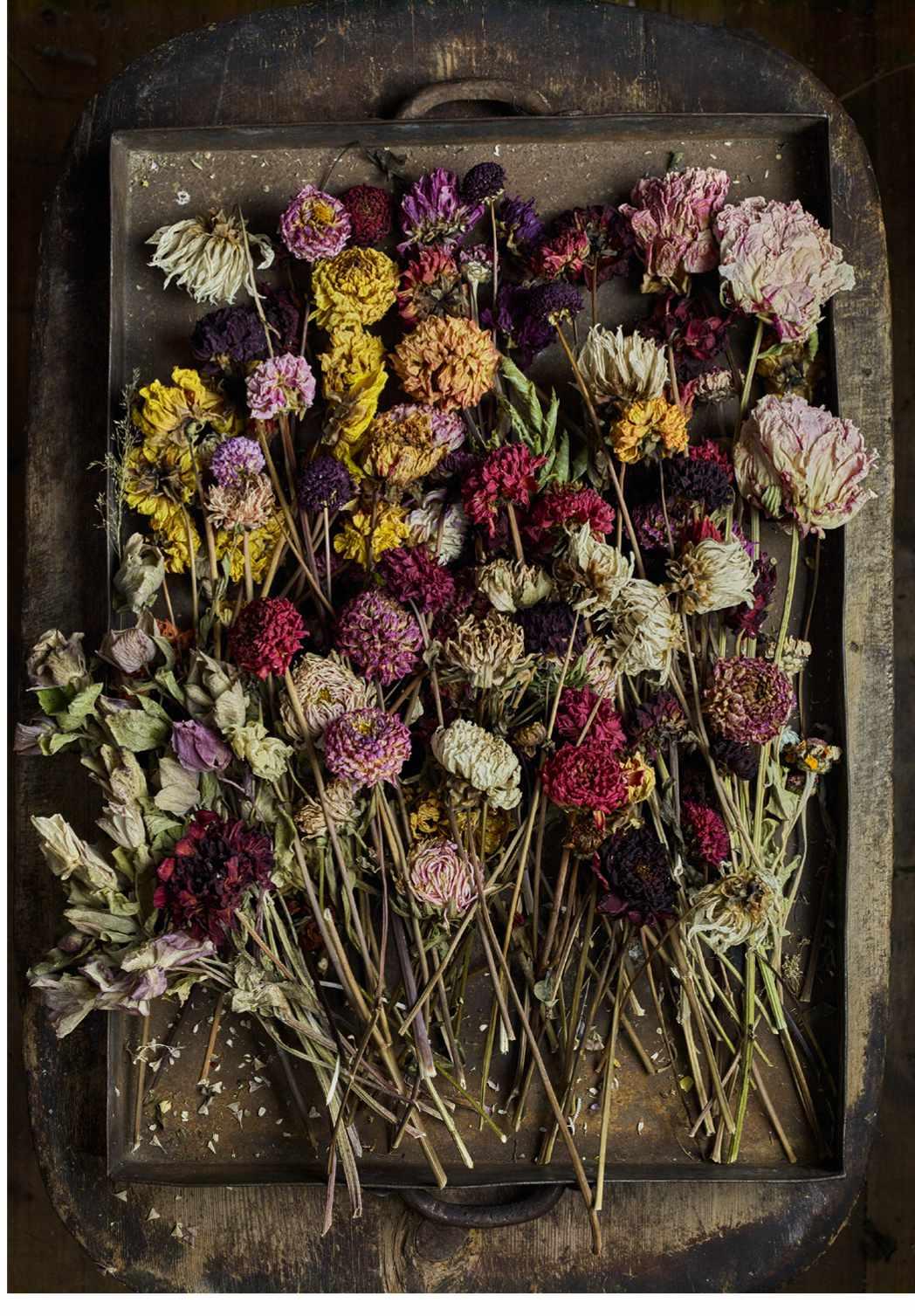
• Some flowers dry better standing upright in a vase. Sanguisorbas, gypsophilas and hydrangeas all keep their structure best if left upright in a vase with no more than around 2.5cm of water.
Bex prefers the muted tones and textures of dried dahlias, seen here with hellebores and peonies, to the freshly picked flowers.
with that vision, being a way of making the most of the flowers from the garden, without the constant churn of fresh flowers. “It’s magic that you can take something that’s fleeting in the garden or in a vase and dry it out and it will last for months or even years.”
She grows a lot of annuals, in the garden and on a nearby allotment. “Everlastings, such as Ammobium alatum and Xeranthemum, are flowers with papery petals and among the best dried flowers. They are annuals, along with other favourites of mine for drying, such as larkspur, nigella and poppy for seedheads. Annuals are prolific: you get a lot of stems from every plant.”
There are also perennials dotted around the garden that she harvests from. “Many perennials are wonderful for drying well but they’re not as prolific as you would get with an annual. I select a few every now and then and leave the rest to flower in the garden.” Delphiniums, hydrangeas, solidago, eryngiums and sea lavenders all dry beautifully, as do echinaceas and rudbeckias and anything daisy-like. Bex particularly loves using seedheads and grasses. “When we moved here the lawn was mowed into straight lines. We decided to just let it go wild and see what was in the seed bank. This amazing number of different grass seedheads sprang up, and lots of wildflowers as well. It is these interesting and often wild plants that when paired with colourful annuals can help curate an organic, wild display that is reflective of the wonderful outside world. I welcome in teasels, knapweed and umbellifers such as wild carrot into my garden to grow among the more obvious dried flowers.”
Her beautiful creations certainly look like an artfully curated slice of countryside. “The aesthetic qualities of my work reflect my life now,” she says. “I’m so immersed in the natural world here, it’s in tune with the seasons, it’s organic, it’s wild, and a little bit magical.” n
USEFUL INFORMATION
See more of Bex’s work on Instagram @botanical_tales and find details of her online and in-person workshops at botanicaltales.com
Bex’s studio with hanging dahlias mid drying and others stored in crates. She also plant-dyes her own ribbons and strips of fabric.
FEBRUARY 2023 GARDENSILLUSTRATED.COM 67
Planting for prosperity
Many of the hyacinth cultivars in Alan Shipp’s National Collection were once thought to be lost, but the man dubbed the ‘Noah of hyacinths’ is bringing them back into cultivation
WORDS NAOMI SLADE PHOTOGRAPHS MIMI CONNOLLY
 Rows of pastel-coloured Hyacinthus orientalis, growing in Alan Shipp’s Cambridgeshire nursery.
Rows of pastel-coloured Hyacinthus orientalis, growing in Alan Shipp’s Cambridgeshire nursery.
For many, the fragrant, familiar flowers of hyacinths evoke a particular nostalgia, yet in comparison to other spring bulbs, they’re a niche horticultural interest. But as the spring mists rise over a quiet field in Cambridgeshire, it is hard to resist the romantic rows of flowers that make up the National Collection, and are testimony to decades of obsession.

Here, collection holder Alan Shipp grows 250 cultivars of Hyacinthus orientalis, amassed over more than 35 years and from all across Europe – thought to be the largest collection of its kind in the world. Alan is now internationally renowned as a hyacinth expert, yet he fell into this area of horticulture by chance.
“My father and grandfather were market gardeners, but we couldn’t compete with the new, massive farms, so I started looking for a high-output diversification crop,” he explains.
In 1985, he bought 100 hyacinth bulbs for 8p each in a nursery sale; there were five cultivars and, as a temporary measure, he planted them in his garden. “When I dug them up, I missed one,” he says. “It had rolled under a shrub and lay there on its side, with its rootlets in the soil for 12 months. By the time I found it, the slugs had eaten right
through the base plate. But small bulbils had formed at the bottom of the scales. Realising that I now knew how to propagate them, I thought ‘I’ll do that’.”
With the addition of 200kg of stock bulbs, the nascent hyacinth farm was soon underway, and shortly afterwards Alan made contact with the holder of the National Collection of hyacinths at Barnard Castle, and offered to propagate his stock, for free.
“The collection holder was Philip Swindells, and he brought me two bulbs each of 50 varieties in the back of his estate car,” says Alan. “But because he decided that a 200-mile trip with a car full of strongly scented hyacinths was too much to bear, he cut off all the flowers and I received 100 pots of leaves, so I took it from there.”
For a while, Alan’s collection stabilised at around 108 cultivars, but as his reputation grew, people increasingly got in touch, asking him to identify unusual hyacinths. This he does from a combination of old breeding records, catalogues and even through works of art, and in 1998 he struck gold when Rita Raziulyte got in touch from Lithuania. Her collection of antique bulbs had been acquired from a floricultural field station in the former Soviet Union. Two of her plants had double yellow flowers, a form and colour thought to be
FEBRUARY 2023 GARDENSILLUSTRATED.COM 69
ALAN’S TOP HYACINTHS
1 Hyacinthus orientalis ‘Ophir’ The world’s first double yellow hyacinth. Thought to be lost until rediscovered in a collection of bulbs from Lithuania, it was identified from a botanical collage by 18th-century artist Mary Delany. 20-25cm x 10-15cm.
2 Hyacinthus orientalis ‘Grande Blanche Imperiale’ Alan has found references to this cultivar with elegant, blush-white flowers in a catalogue dated 1798, but he believes that the cultivar itself is older still. 20-25cm x 10-15cm.
3 Hyacinthus orientalis ‘Raphael’ The exotic, filamented flowers of this relatively new cultivar are extremely unusual in hyacinths. It was introduced in 2005 by Alan’s friend, the late Dutch breeder Kees van der Salm. 20-25cm x 10-15cm.
4 Hyacinthus orientalis ‘Patricia Sadler’ A cultivar that was bred by Alan Shipp himself and was named for the daughter of a couple who owned a nearby garden centre. 20-25cm x 10-15cm.
5 Hyacinthus orientalis ‘Distinction’ Dating back to 1880, a cultivar that stands out from the seasonal pastels with its imperial purple flowers. 20-25cm x 10-15cm.
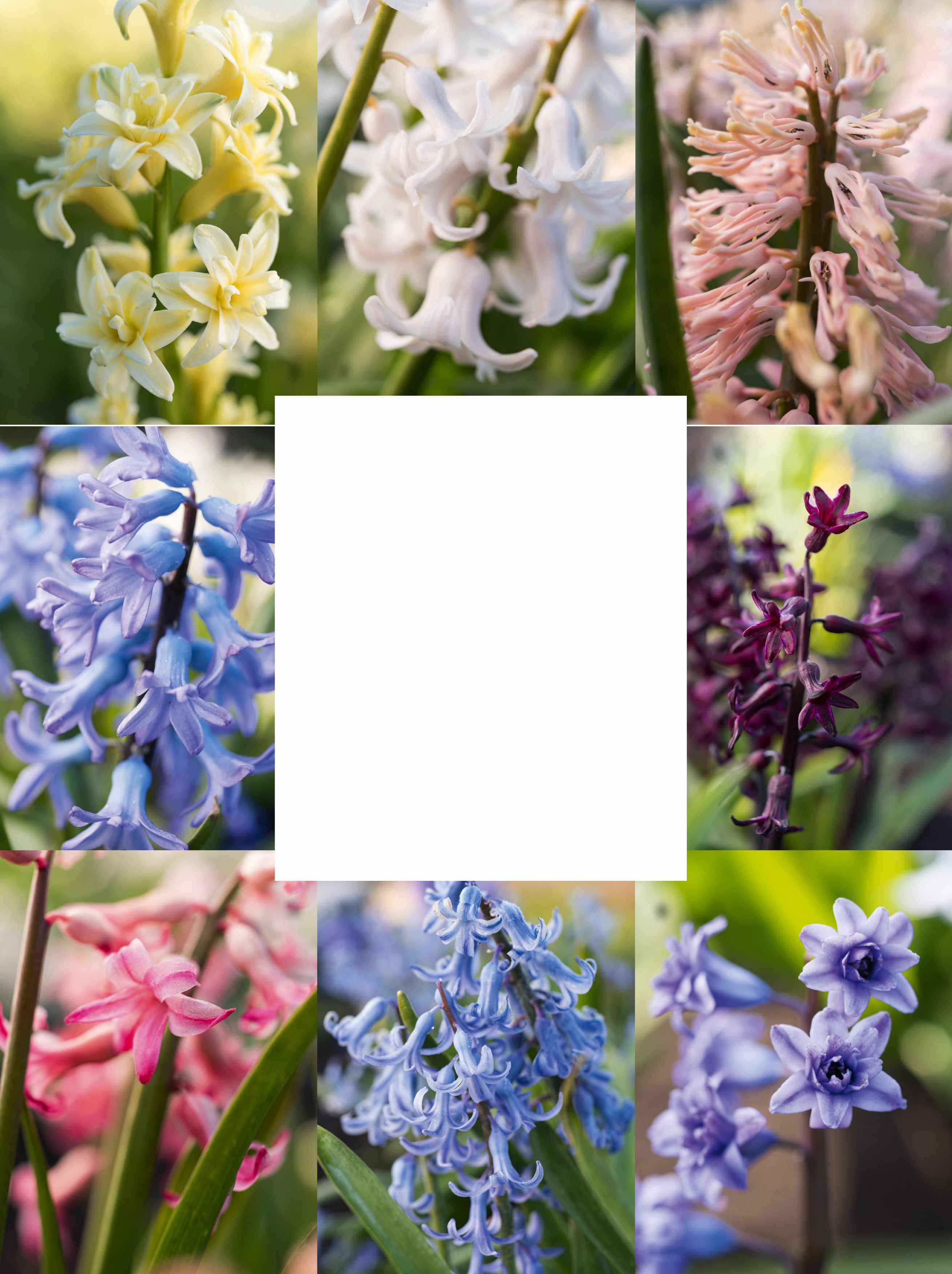
6 Hyacinthus orientalis ‘Gertrude’ Dating from 1850, the waxy flowers of ‘Gertrude’ are a soft, clear pink with a fine magenta stripe. 20-25cm x 10-15cm.
7 Hyacinthus orientalis ‘Myosotis’ An heirloom hyacinth that can be traced back to 1896. Its name is derived from its glorious forget-me-not blue flowers. 20-25cm x 10-15cm.
8 Hyacinthus orientalis ‘Flore Pleno’ A cultivar brought to Alan’s attention as a double form of the small Roman hyacinth, which is naturalised in southern France. However, it transpired it was a far more interesting double form of H. orientalis, which was first illustrated as early as 1608. 20-25cm x 10-15cm.
Alan’s top hyacinths continue on facing page. See page 73 for details of hardiness ratings.
1 2 4 5 6 7 8 3
extinct in cultivation. One was known to be ‘Sunflower’; the other has been recently re-identified as ‘Ophir’, which dates from the late 18th century when hyacinths were at the height of their popularity.
“Hyacinth mania started in the early 18th century when Haarlem florist Pieter Voorhelm spotted a late double flower with a red centre, which he propagated and named ‘Konig van Groot-Brittanje’ after William of Orange,” says Alan. “Up until that point, the doubles with a squiggly bit in the middle were discarded, because it was thought they were deformed. By the time hyacinth mania peaked in 1737, it was all about white doubles with coloured centres, but ‘Ophir’ was the world’s first double yellow hyacinth. When it was introduced in 1770, it sold for 8,600 florins – which made it around £800 per bulb.”
Another rare treasure is Hyacinthus orientalis ‘Gloria Mundi’, which was introduced in 1767 and which Alan thought was lost until he bumped into Alan Street, the late head nurseryman at Avon Bulbs, at an RHS Bulb Committee meeting. “He [Street] came up to me and
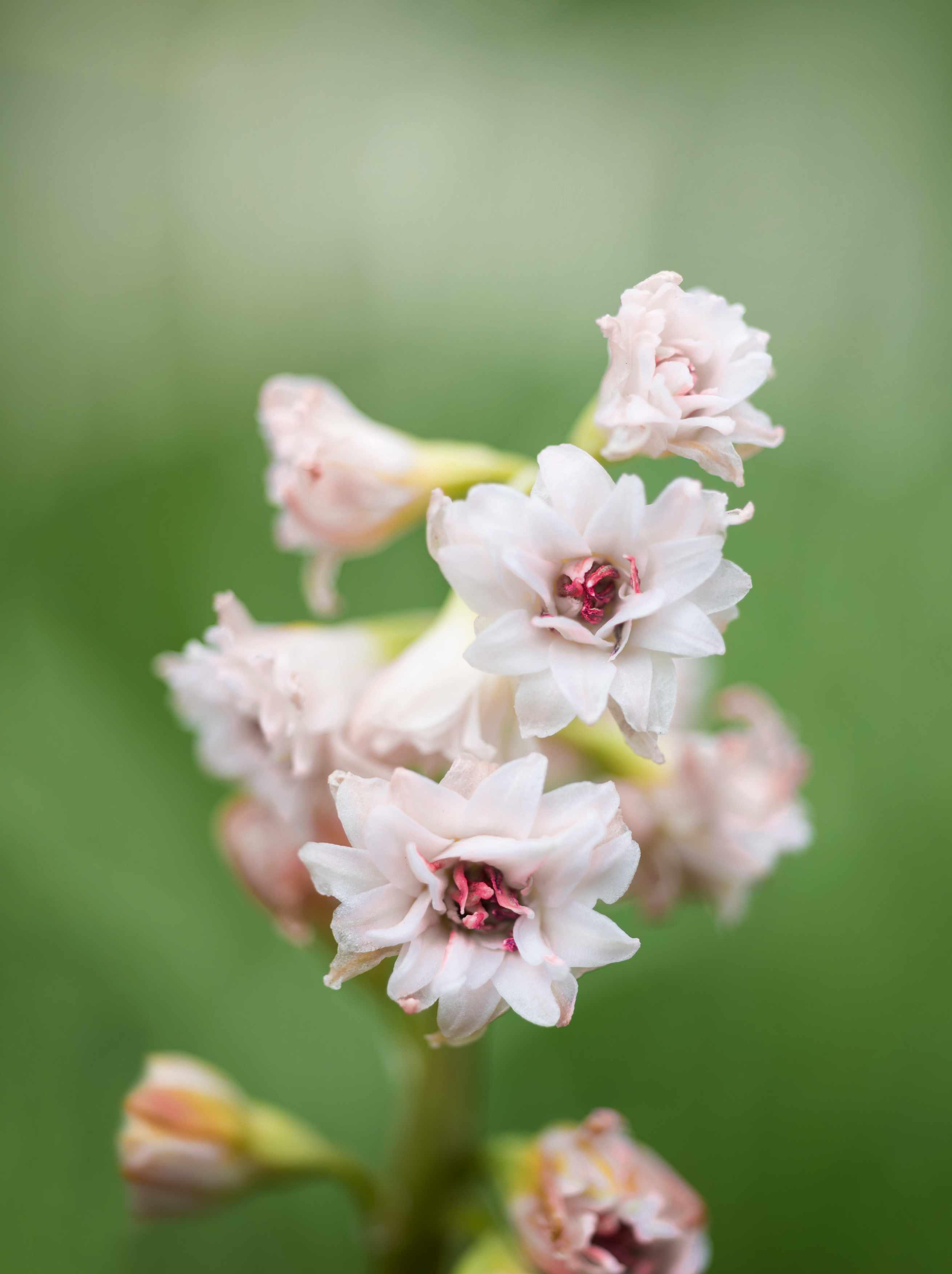
said ‘I’ve got an unusual red and white double hyacinth you might be interested in’,” says Alan. The ‘Gloria Mundi’ that Alan Street had been growing for years without recognising its significance had come via a Swiss friend from a Romanian garden (a gift to another keen Swiss gardener who’d been delivering aid). When Avon Bulbs later exhibited it, it won an RHS Award 250 years after it was first introduced.
Although he is alive to the possibilities of new and distinctive seedlings, Alan is a collector and enthusiast rather than an avid breeder. When asked to choose a favourite cultivar, he says he could narrow it down to “ten at a push”. But he still grows a number of hyacinths that are no longer in production elsewhere, exporting small quantities of rarities such as ‘Ophir’ and ‘Grande Blanche Imperiale’ to Old House Nursery in the USA, where he has been dubbed the ‘Noah of hyacinths’, as well as selling bulbs at his nursery open days.
With ever more cultivars becoming available, Alan is feeling positive about the future of hyacinths, and is also exploring
This survivor from the late 18th century, when hyacinths were all the rage throughout western Europe, is a glorious white double with a red centre. It was thought to be lost for many years. 20-25cm x 10-15cm.
When Avon Bulbs exhibited ‘Gloria Mundi’, it won an RHS Award 250 years a�er it was �rst introduced
Hyacinthus orientalis ‘Gloria Mundi’
FEBRUARY 2023 GARDENSILLUSTRATED.COM 71 9
Alan’s top hyacinths continue on page 72.
ALAN’S TOP HYACINTHS
10 Hyacinthus orientalis ‘Purple Dream’ A beautiful, lavender-mauve cultivar, which was among a number of seedlings sent to Alan by his late friend, the Dutch breeder Kees van der Salm. 20-25cm x 10-15cm.
11 Hyacinthus orientalis ‘Sarah Bateman’ Another cultivar bred by Alan Shipp, this clear blue hyacinth was named for the wife of a man who sold Alan a vintage tractor. 20-25cm x 10-15cm.
12 Hyacinthus orientalis ‘Sunflower’ A hyacinth with dense, full-double blooms, ‘Sunflower’ dates from before 1897. It was sent to Alan from Lithuania in the same shipment that contained the rare ’Ophir’. 20-25cm x 10-15cm.
13 Hyacinthus orientalis ‘Queen of the Blues’ A heritage cultivar dating from at least 1870 with classic and lovely clear-blue flowers. 20-25cm x 10-15cm.
14 Hyacinthus orientalis ‘Roi des Belges’ Its fragrant, bell-shaped, pink flowers have a darker rose stripe on each petal. 20-25cm x 10-15cm.
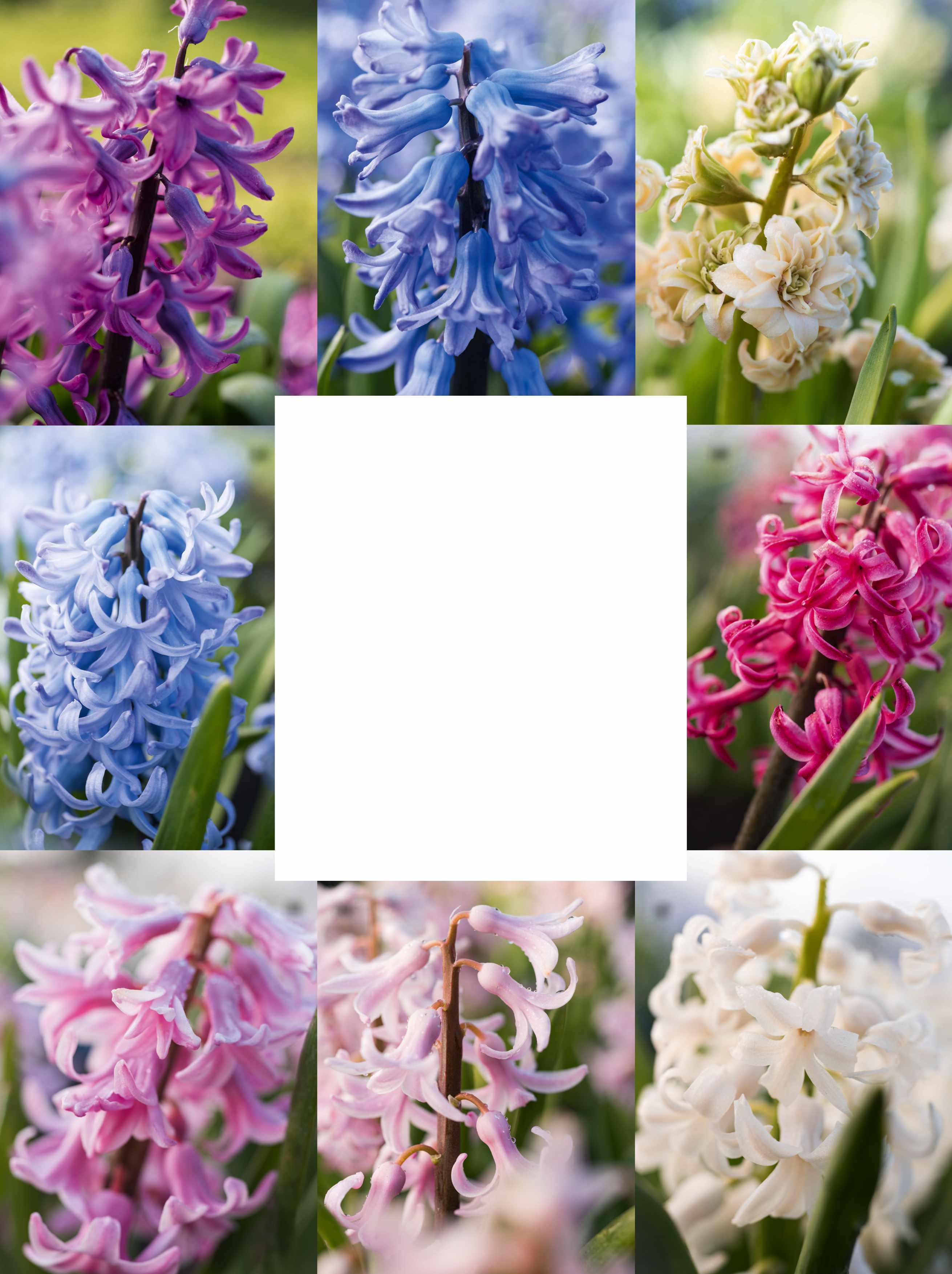
15 Hyacinthus orientalis ‘General de Wet’ A delicate pink cultivar presumed to be named for the rebel leader and politician Christiaan de Wet (1854 -1922) who served in both the first and second Boer Wars. 20-25cm x 10-15cm.
16 Hyacinthus orientalis ‘Gigantea’ One of the old hyacinth cultivars that was conserved in the former Soviet Union, the flower spike is a delicately rosy jingle of bells. 20-25cm x 10-15cm.
17 Hyacinthus orientalis ‘Saaremaa’ Other than the fact it was bred in Estonia, little else is known about the history of this flower, which Alan acquired from the Lithuanian collection of Rita Raziulyte. 20-25cm x 10-15cm.
Alan’s top hyacinths continue on facing page along with details of hardiness ratings.
10 11 13 14 15 16
12
17
options to protect the future of his own collection. “I’m 85 now so I suppose at some point in the next decade I’ll have to retire,” he says. “But I’ve always loved hyacinths. Nothing approaches them for palette and nowhere else do you get that range of colours in March.” n
USEFUL INFORMATION
Address Bannold Road, Waterbeach, Cambridgeshire CB25 9LQ.
Tel 01223 571064. Open 25-26 March, 11am-5pm.
Alan’s nursery opens annually on the last weekend of March and bulb orders can be placed at these open days. He also holds a bulb sale on the last weekend of August. Find out more about Alan’s collection and other National Collections at plantheritage.org.uk
Where else to buy
• Avon Bulbs Burnt House Farm, South Petherton, Somerset TA13 5HE. Tel 01460 242177, avonbulbs.co.uk
• Bloms Bulbs Primrose Nurseries, Melchbourne, Bedfordshire MK44 1ZZ.
Tel 01234 709099, blomsbulbs.com
• de Jager Bulbs Church Farmhouse, Ulcombe, Maidstone, Kent ME17 1DN.
Tel 01622 840229, dejager.co.uk
• Farmer Gracy farmergracy.co.uk
• Jacques Amand International
The Nurseries, Clamp Hill, Stanmore, Middlesex HA7 3JS.
Tel 020 8420 7110, jacquesamandintl.com
• Kevock Garden Plants Kevock Road, Lasswade, Midlothian EH18 1HX.
Tel 0131 454 0660, kevockgarden.co.uk
How to grow hyacinths
• Hyacinths will grow in any good, well-drained garden soil and perform well in a range of situations including borders and rockeries. They need some moisture to grow and flower properly, but avoid boggy areas where they may rot, and don’t overwater container-grown plants. A drier situation is preferred when the leaves have died back and they are dormant.
• In the garden, plant the bulbs around 10cm deep in September or October for flowers that will arrive in March and April. You can also buy prepared bulbs for forcing, and these will produce flowers to grow indoors in pots or specially designed vases of water, over winter. The difference between these and garden bulbs is that bulbs for forcing have already been exposed to a period of cold, which stimulates production of the hormones required for stem extension. As a result, flowers are produced in winter rather than in spring.
• When in growth, hyacinths like plenty of light to help build up the bulb for the following spring.
• Deadhead spent flowers if desired and feed regularly with a high-potassium liquid plant food until the leaves start to yellow.
• Grown in containers, bulbs will diminish with time and will cease flowering unless they are well fed and potted up regularly. Because of this, hyacinths are best planted outside in open soil after the blooms have gone over.
Hyacinthus orientalis ‘Hollyhock’
This late-blooming cultivar, with tight double florets in vivid magenta and classic good looks, is a sport of ‘Tubergen’s Scarlet’, which itself is a sport of ‘Distinction’. 20-25cm x 10-15cm. AGM*.
*Holds an Award of Garden Merit from the Royal Horticultural Society. All Hyacinthus orientalis featured have a hardiness rating of RHS H4, USDA 4a-8b.
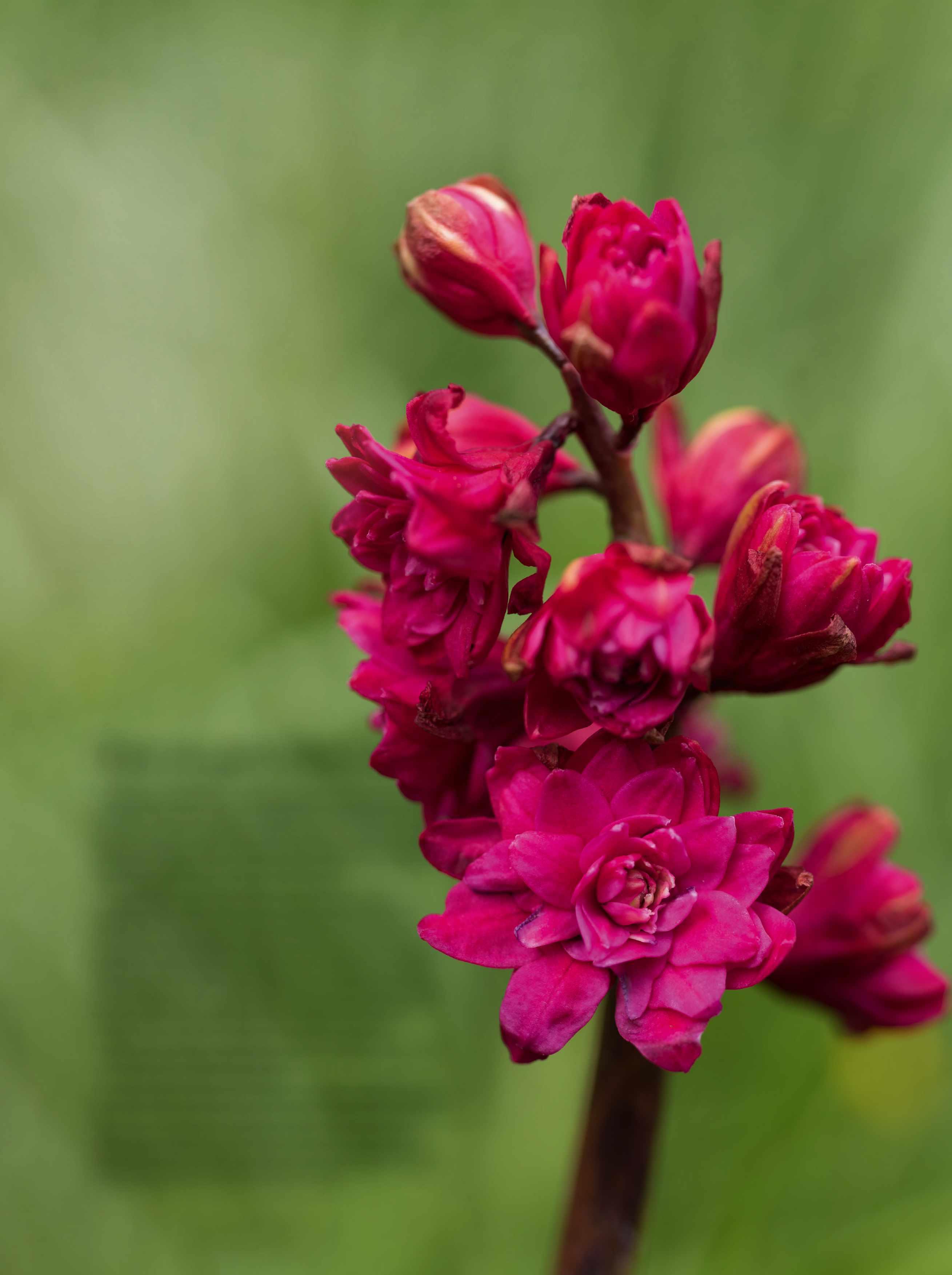
FEBRUARY 2023 GARDENSILLUSTRATED.COM 73
18
IN BRIEF
What A gardener’s garden planted for year-round interest with a vegetable garden, a woodland garden and a spectacular ‘privy garden’. Where Victoria, Australia.

Size Half an acre.
Soil Rich basalt loam.
Climate Cold, wet winters with cool, increasingly dry summers with occasional temperature spikes and considerable variation between years. Hardiness zone USDA 9a (Sunset Zone 15).
To one side of Simon’s house the ‘privy garden’ is enclosed by Arts and Craftsstyle hedges of glossy-leaved Escallonia ‘Iveyi’, a hybrid of two Chilean plants, which does well in his conditions. It offers the perfect foil to the grasses, such as Miscanthus sinensis ‘Silberfeder’, Cenchrus longisetus and Calamagrostis x acutiflora ‘Karl Foerster’, which add softness and movement to the vibrant selection of perennials, including Phlox paniculata ‘Hesperis’, Eucomis comosa ‘Oakhurst’ and Hylotelephium Herbstfreude Group.
74 GARDENSILLUSTRATED.COM FEBRUARY 2023
Mix and match
Australian gardener Simon Rickard is inspired by the great gardens of Britain but, rather than slavishly copying them, he uses plants that will thrive in his plot in the Central Highlands of Victoria
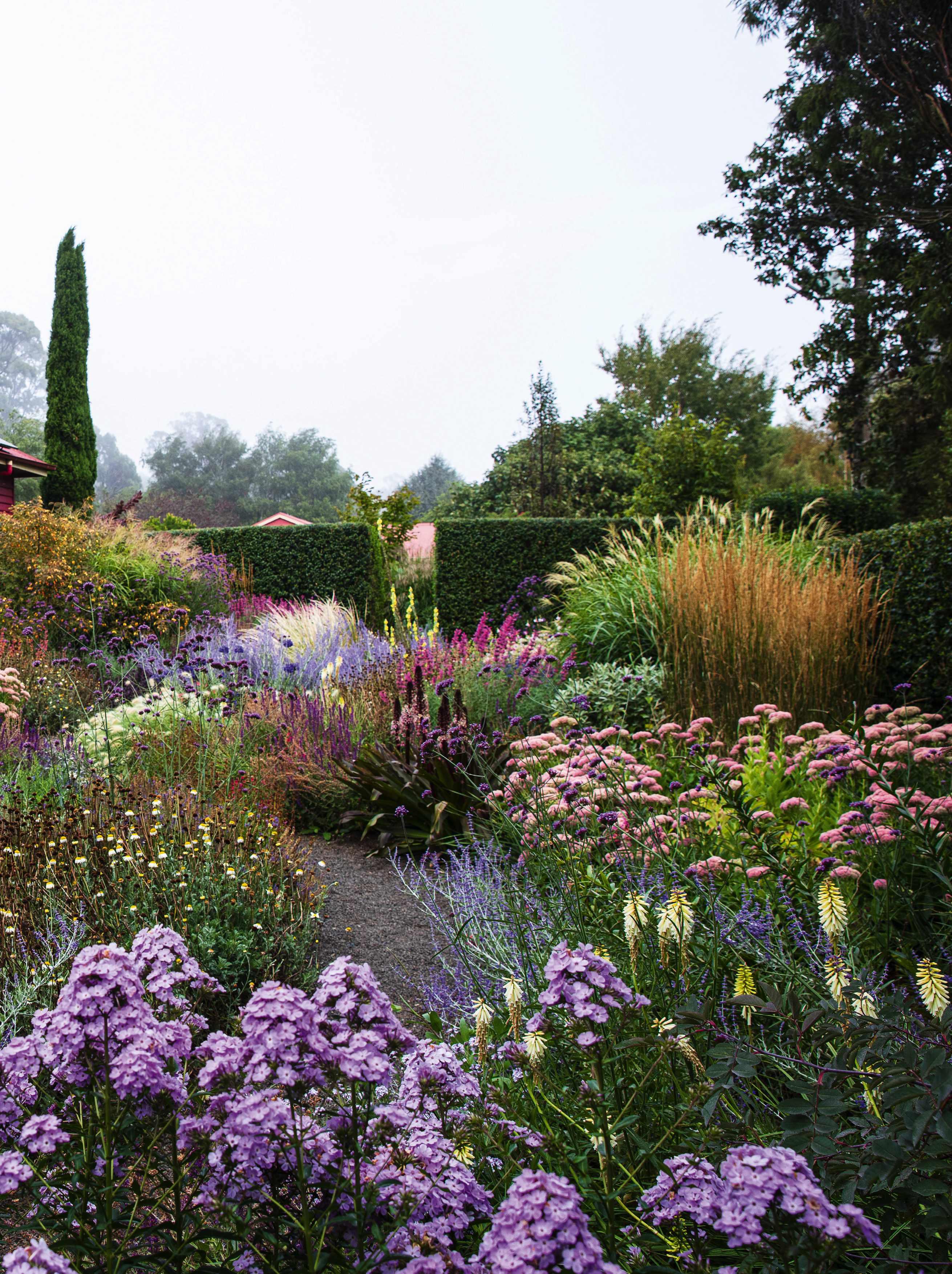 WORDS NATASHA GOODFELLOW PHOTOGRAPHS CLAIRE TAKACS
WORDS NATASHA GOODFELLOW PHOTOGRAPHS CLAIRE TAKACS
Imagine Australia and, chances are, you’ll picture somewhere hot, sunny and within striking distance of a beach. Even if you know that Melbourne has a cooler, rainier climate than much of the rest of the country, you may still be surprised to learn that just over an hour northwest of here, in Victoria’s Central Highlands, things can turn very cold indeed, with wet, snowy winters and temperatures sometimes as low as -7°C. Summers, on the other hand, are brief and can ricochet between relatively cool and extremely hot. “Think of the South of France in August,” says Simon Rickard, who has made his home here in the small town of Trentham. “It can be brutal.”
An avid gardener since childhood, for seven years Simon was head gardener at two of the flagship gardens of The Diggers Club (an Australian organisation similar to the RHS), St Erth and Heronswood, and now designs gardens, leads garden tours and lectures all over the globe. He is also a talented musician specialising in Baroque and Renaissance bassoons, and his studies, which included four years in Europe, gave him the opportunity to visit many of the gardens he had read so much about. “Great Dixter, Sissinghurst, Kew… British gardens are the best in the world,” he says.
It was the spirit of these gardens that Simon wished to conjure when he started to make a garden here in Trentham 18 years ago. Though the towering eucalyptus trees of the Wombat State Forest can be seen at the end of the street, the plot itself was completely bare save for a covering of grass. “I began by earmarking parts of the garden for different purposes,” says Simon. “The vegetable and fruit garden obviously had to have full access to the sun. I wanted the front garden to look impressive from the road, and I wanted to create a more private space behind.”
Then came the planting, informed by two guiding principles. “I wanted a garden that looked good for much of the year, so shape and foliage were always going to be more important than colour,” says Simon. Second, in selecting his plants he has not adopted the plants he saw growing in British gardens, but has instead embraced the British approach to garden making, with far happier
To continue turn to page 80
This page, from top
Designed for maximum impact from the street, Simon’s front garden looks good for most of the year with long-lasting shrubs and perennials chosen primarily for their form and foliage, such as the tall Cupressus sempervirens ‘Glauca’ and the large New Zealand flax Phormium colensoi

Gardener Simon Rickard in his richly planted ‘privy garden’. “I always think about form before colour,” he says, “but I’m interested in all kinds of plants, in how I can get them to grow and look good together side by side.”
The orange and scarlet hips of Rosa moyesii ‘Geranium’ alongside the acid-yellow flowers Bupleurum fruticosum add a splash of bright, late-summer colour to Simon’s front garden. The darker hues of the purple smoke bush Cotinus ‘Grace’, and palm-like Cordyline australis Purpurea Group tone well with the house.
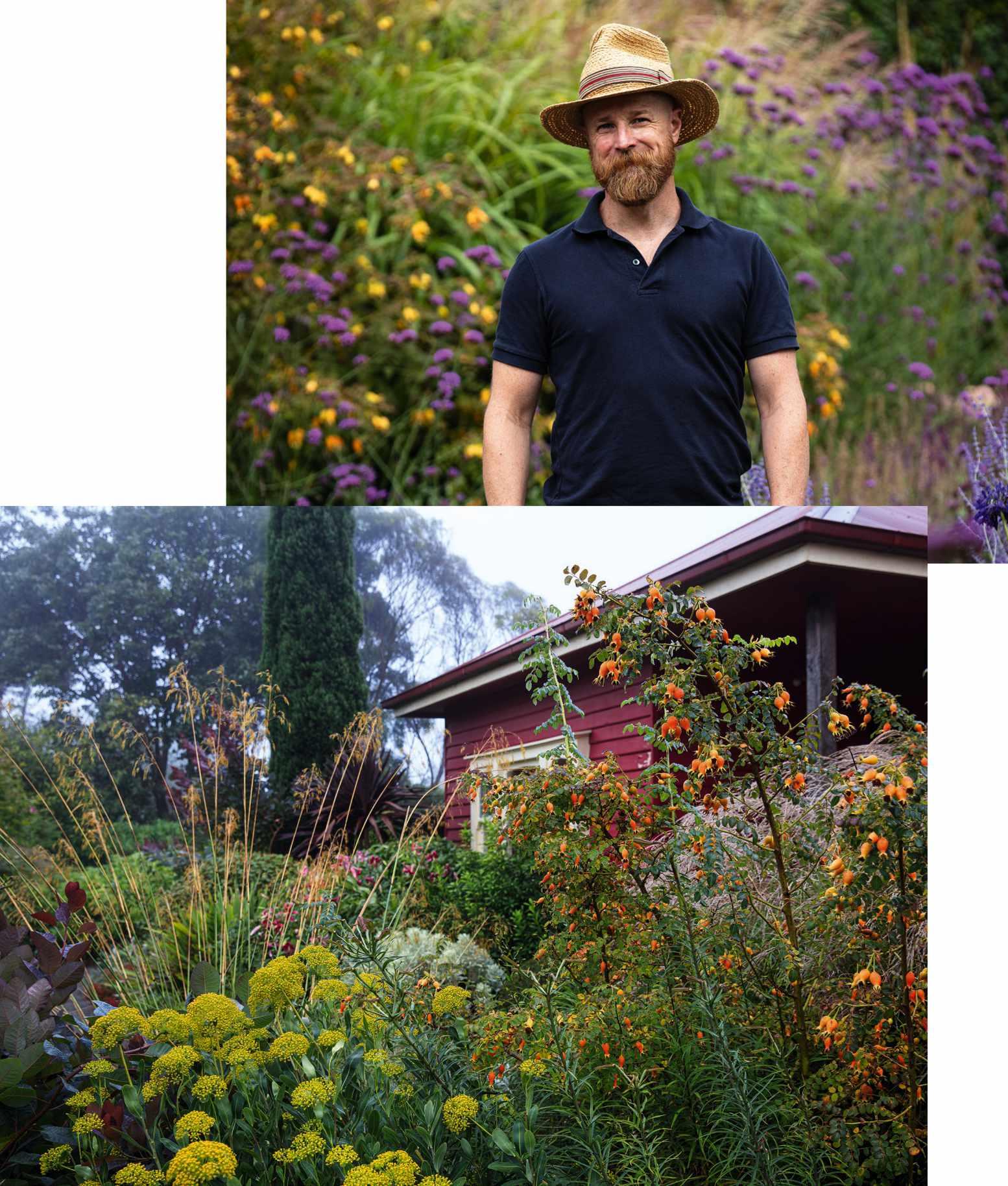
76 GARDENSILLUSTRATED.COM FEBRUARY 2023
I wanted a garden that looked good for much of the year, so shape and foliage were always going to be important
8 KEY PLANTS
1 Lilium ‘Casa Blanca’ Florists now prefer to use the Dutch hybrids but this old cultivar is a really good garden plant – robust, reliable and virus-resistant.
1.5m x 50cm. AGM*. RHS H6, USDA 5a-8b†
2 Cistanthe grandiflora A highly floriferous shrubby succulent with single, magenta-pink flowers borne on tall, wiry stems. Looks good planted en masse. 60cm x 75cm. USDA 8a-10b.
3 Azorella pedunculata A cushion-forming plant that is ideal for groundcover. Simon laughingly likens it to artificial grass. “It looks like that every day of the year,” he says. 2cm x 50cm. RHS H6.
4 Agastache ‘Nadine’ Agastaches have a reputation for being short-lived, rather pernickety plants but this Australian selection is far superior to many others, being both self-supporting and long-lived. 1m x 50cm. USDA 6a-9b.
5 Verbena rigida This South American native flowers for months no matter if it’s 40ºC or 10ºC, and has become Simon’s ‘signature perennial’ in the gardens he designs for clients. 40cm x 60cm. AGM. RHS H3, USDA 9a-10b.
6 Stipa ichu Similar to Stipa tenuissima, which is banned in Australia, the Peruvian feather grass has none of the Mexican feather grass’s invasive tendencies and looks wonderful when backlit. 1m x 60cm. USDA 8a-10b.
7 Pachystegia insignis Known as the Marlborough rock daisy, this is the most asked-about plant in Simon’s garden. Its daisy-like flowers, which develop in late summer into attractive seedheads, are held above glossy, dark-grey evergreen leaves with a beautiful white felting underneath. 75cm x 1.25m. RHS H3.
8 Bupleurum fruticosum More commonly grown in the UK than in Australia, this evergreen shrub with clusters of yellow flowers is extremely well-suited to the southern Australian climate. Bees love it. 2m x 2m. RHS H4.
*Holds an Award of Garden Merit from the Royal Horticultural Society. †Hardiness ratings given where available.
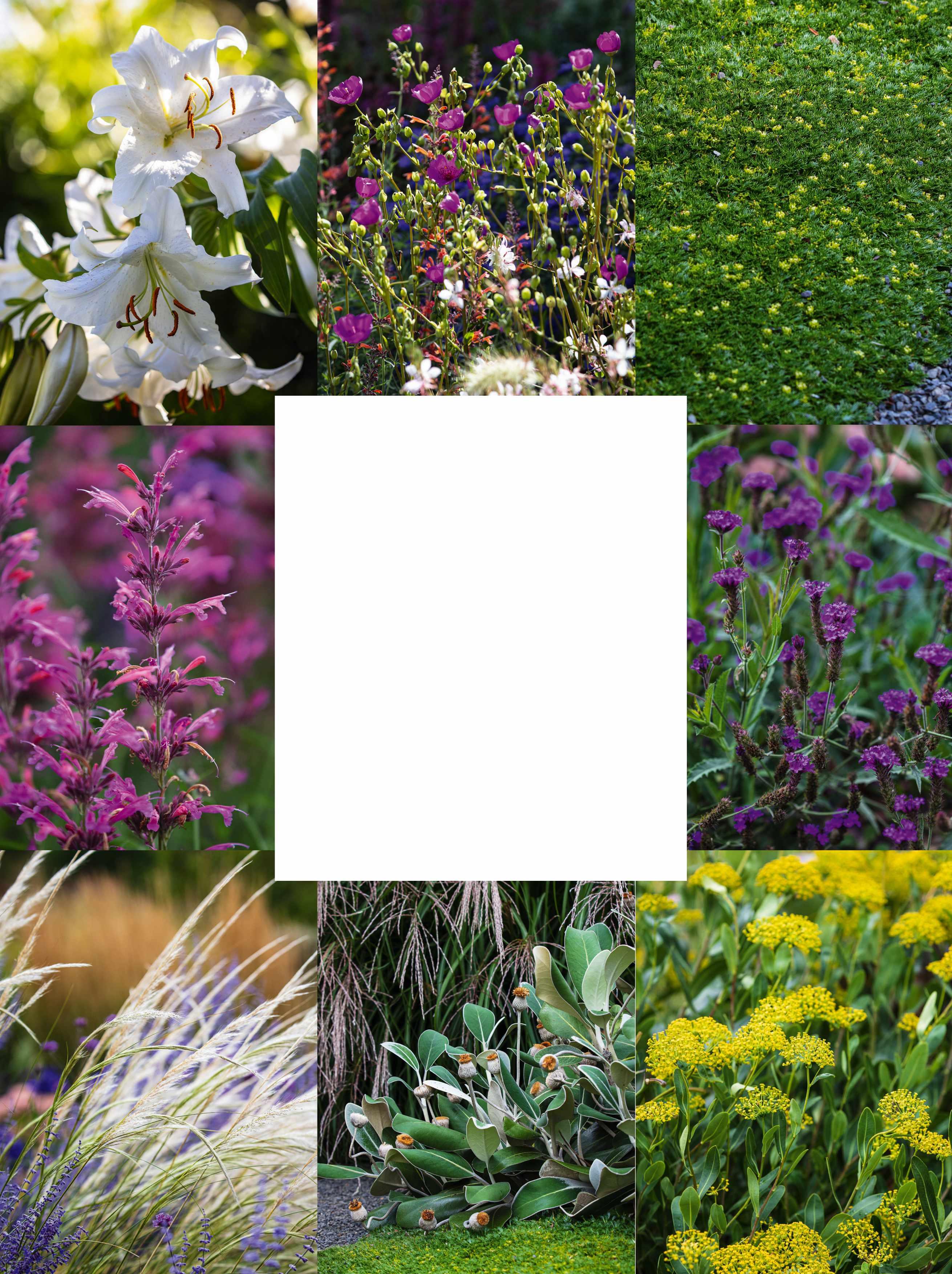
1 2 4 5 6 7 8 3
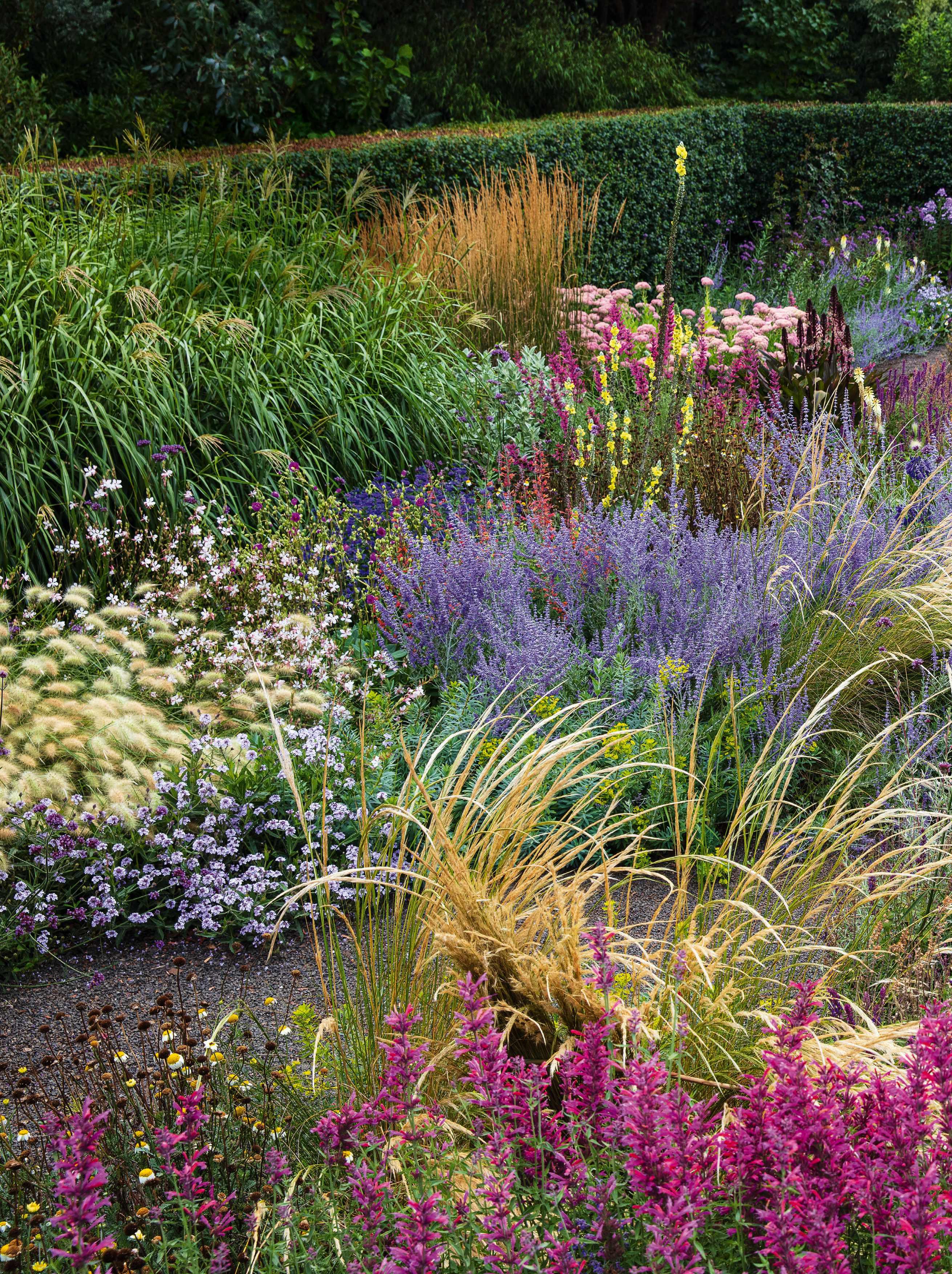
78 GARDENSILLUSTRATED.COM FEBRUARY 2023
I’ve got a bit of everything in there, and it makes me really happy. It’s clashing, a little tasteless perhaps, but it’s just joyous
Simon loves this corner of the ‘privy garden’, with its bold plantings of blue Salvia yangi ‘Little Spires’, which Simon describes as a “palate cleanser”, alongside the shocking-pink tender perennial Agastache ‘Nadine’, the tall, purple Verbena bonariensis and low-growing, lilac Verbena rigida f. lilacina ‘Polaris’, while Verbascum bombyciferum ‘Polarsommer’ and Kniphofia ‘Little Maid’ add unexpected hits of yellow.
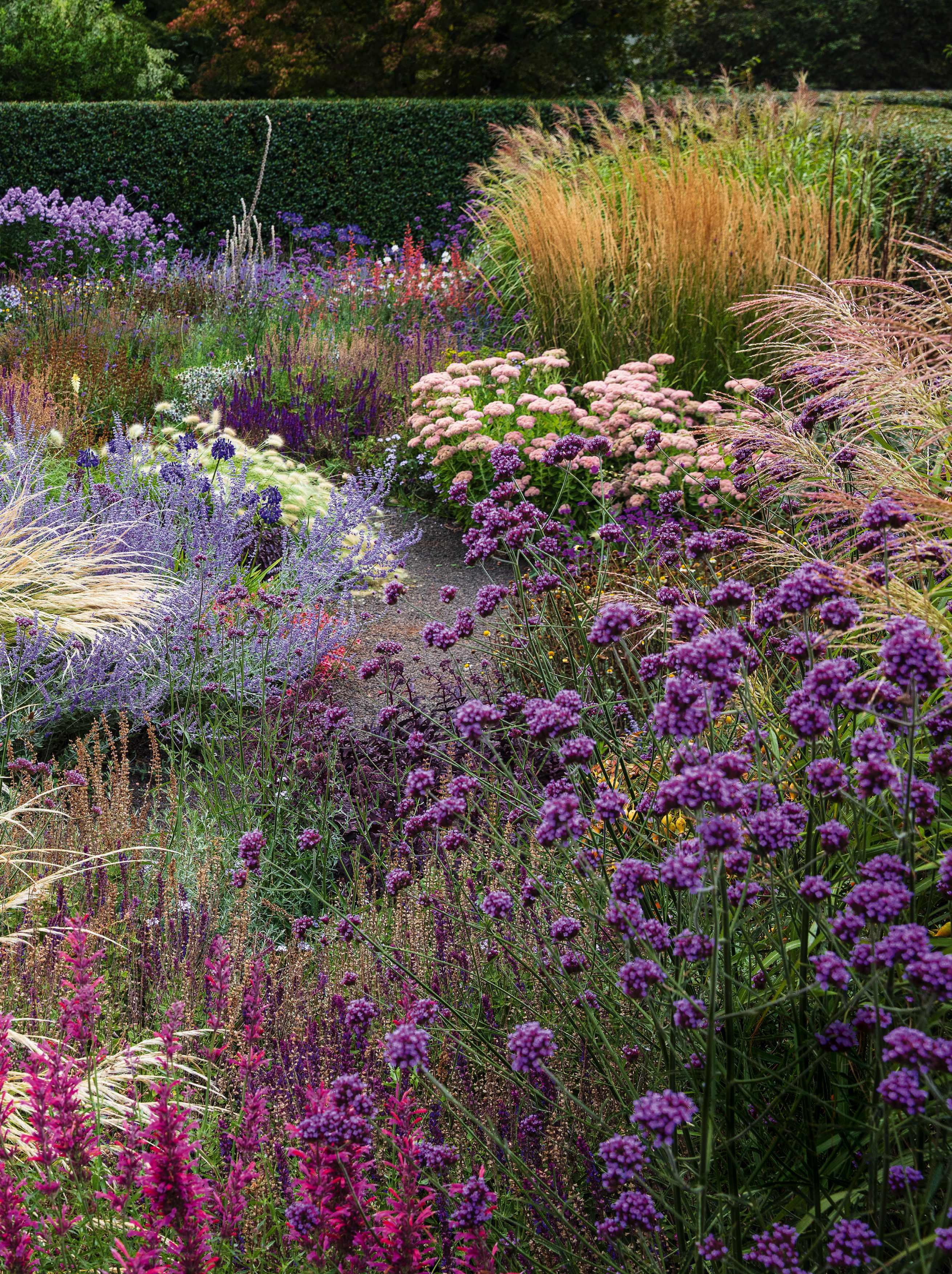
results. “I think too often Australians learn the wrong lessons from British gardens,” he says. “We tend to obsess over Russell lupins or delphiniums, which just can’t cope in our climate, and in so doing, set ourselves up for failure. For me, the real strength of British gardens is the selection of plants from similar climates to the UK’s, all brought together in a unique aesthetic. That’s what I’ve tried to do here.”
Pointing out that his conditions are more similar to that of Cape Town in South Africa than Sydney or Brisbane, he has taken a magpie approach, identifying climates similar to his own – the mountains of Turkey and Greece, the Chilean Andes and the east coast of New Zealand’s South Island, for example – and selecting plants that catch his eye. So, a trio of Mediterranean Cupressus sempervirens ‘Glauca’ zig-zag down the plot, adding height and structure, next to repeated clumps of New Zealand Cordyline australis Purpurea Group and Phormium ‘Anna Red’. Daphne bholua, the Nepalese paper plant, North American Cornus sericea ‘Baileyi’ and Corsican Helleborus argutifolius, meanwhile, ensure plenty of winter interest.
Despite concerns in some quarters about the attractiveness of exotic plants to native wildlife, Simon reports that his wild garden visitors seem to positively thrive on the mix. “Native animals cannot read a plant’s passport, and they’re just as happy to suck nectar from Oriental lilies as they are from a native grevillea,” he says.
In summer, the hedged ‘privy garden’, based on an Arts and Crafts garden room, is the undoubted star of the show – a mass of densely planted grasses and perennials with only the slimmest pathway snaking through. “I wanted to make it just about the viewer, the flowers and the sky,” says Simon. This is also the space where Simon feels freest to challenge himself, experimenting with colours and combinations. “I’ve got a bit of everything in there,” he says, smiling broadly. “Acid green; lilac; purples; shocking, toxic pink; yellow… and it makes me really happy. It’s clashing, a little tasteless perhaps, but it’s just joyous. I guess it’s kind of like Baroque music in a way – a bit over the top, but it really excites the senses.” n
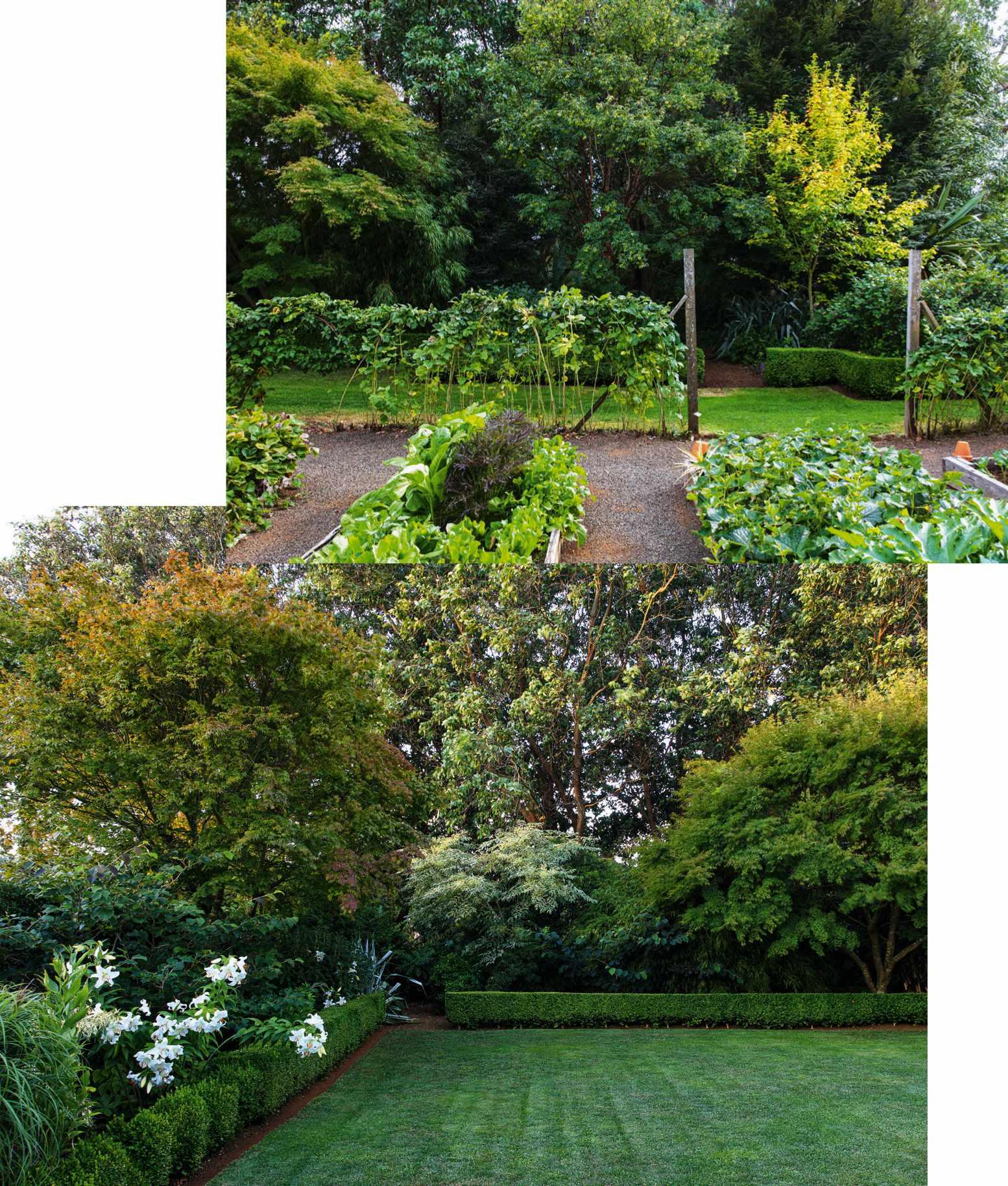
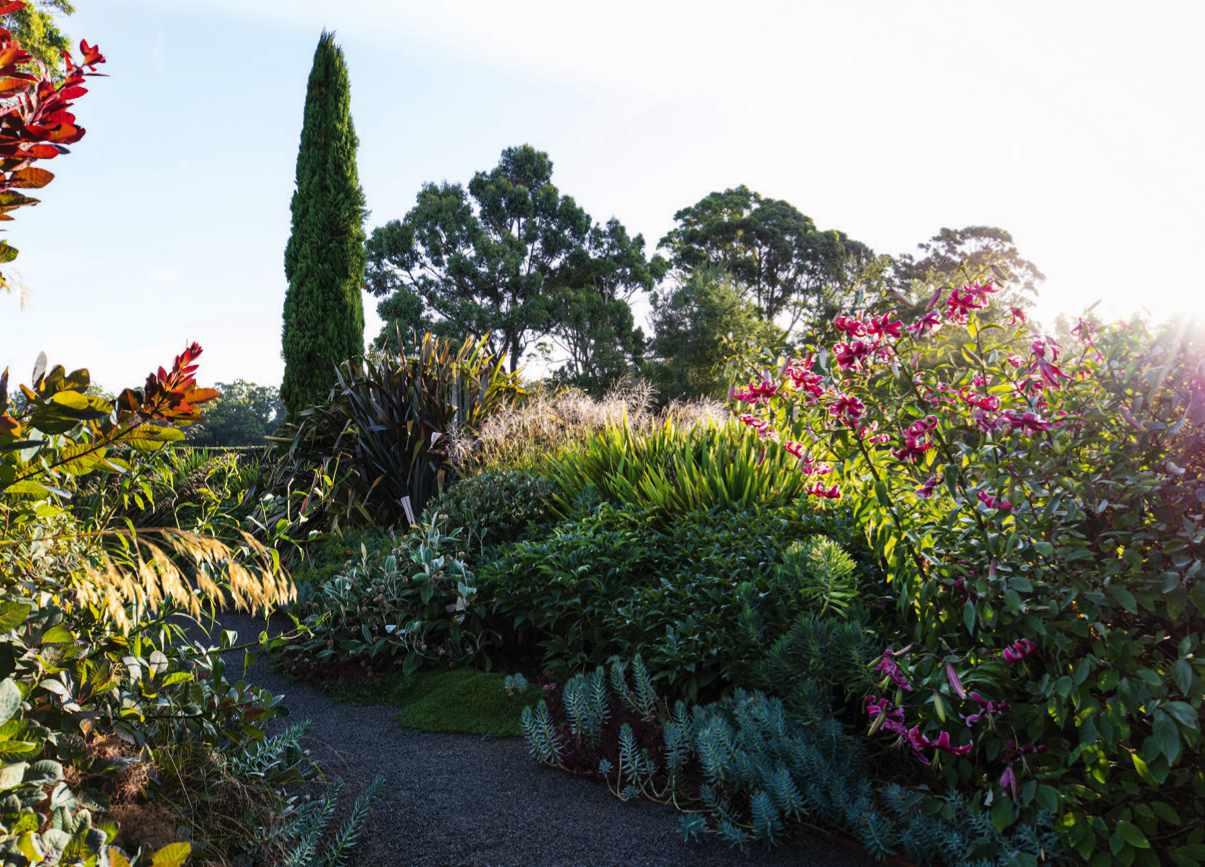
USEFUL INFORMATION
Find out more about Simon’s work at simonrickard.com
This page, from top
An eclectic mix of plants, including Pachystegia insignis from New Zealand, Euphorbia rigida, native to parts of Europe, Africa and Asia, and the neat mat-forming Azorella trifurcata, from South America, spill over a path of crushed basalt stone, known as ‘blue metal’. A deep red Lilium ‘Miss Feya’, adds colour, while tall Cupressus sempervirens ‘Glauca’ acts as punctuation and helps bring the garden into scale with the native Eucalyptus obliqua trees beyond.
In the sunniest part of the garden, Simon has created a productive vegetable and fruit garden edged with Rubus idaeus ’Tulameen’ bushes.
Lilium ‘Casa Blanca’ brings a splash of white to a calm lawn edged by a low Buxus sempervirens ‘Suffruticosa’ hedge, and surrounded by graceful Asian trees, including Acer palmatum and Aralia elata ‘Silver Umbrella’, that evoke a British garden.
80 GARDENSILLUSTRATED.COM FEBRUARY 2023
Too o�en Australians learn the wrong lessons from British gardens and so we set ourselves up for failure
Simon’s woodland garden continues his theme of successfully mixing plants from different regions. A spectacular Cordyline indivisa, native to New Zealand, grows below the tough Asian bamboo, Fargesia scabrida. At ground level the wonderfully mottled Podophyllum ’Spotty Dotty’ mingles with Disporopsis pernyi, alongside a mix of ferns and hellebores.
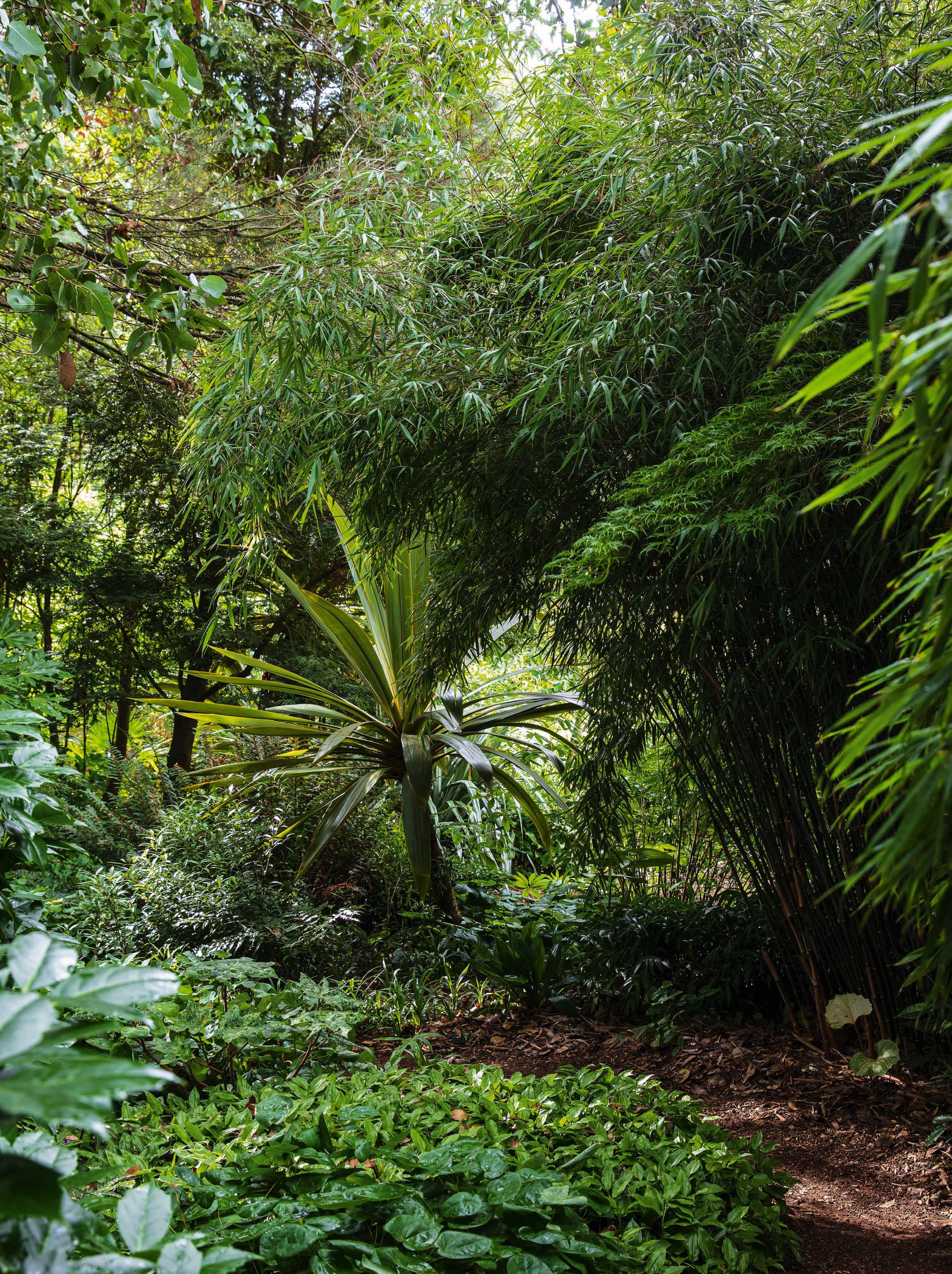
BATH DECORATIVE ANTIQUES FAIR

THE PAVILION, BATH, BA2 4EU 10-11 MARCH 2023

PREVIEW
THURSDAY 9 MARCH

Complimentary Tickets: bathdecorativeantiquesfair.co.uk
SINGLE SNOWDROPS £11 PER 100
SINGLE SNOWDROPS £95 PER 1000
DOUBLE SNOWDROPS £16 PER 100
DOUBLE SNOWDROPS £140 PER 1000
ENGLISH BLUEBELLS £16 PER 100
CROCUS £9 PER 50
MINIATURE DAFFODILS £10 PER 50
ACONITES £10 PER 50
DWARF IRIS £10 PER 50
FRITILLARIA £10 PER 50
MINIATURE TULIPS £10 PER 50
SNOWFLAKES £15 PER 10
IN THE GREEN CREDIT AND DEBIT CARDS ACCEPTED P&P FREE, MAKE CHEQUES & POSTAL ORDERS PAYABLE TO ANGLIA BULBS, LORDS LANE, WISBECH, CAMBS PE13 4TU TEL: 01945 410966 ALL BULBS TOP QUALITY
SNOWDROPS
Image courtesy of La Place Antiques
News, garden design insight and sourcebook Design
LANDSCAPED LIVING
Australian landscape architect Jane Irwin is working with UK architects David Chipperfield and Assemble Studio to design a new residential area in Canberra, Australia. Occupying 34 acres of a former dairy farm, the three-and four-storey buildings will feature roof gardens and will be set around a central landscape space that changes from open grassland, where it meets the adjacent Jerrabomberra Wetlands, to woodland towards the east. On either side of the central garden, pairs of buildings will frame semi-enclosed courtyards, and the excavated spoil that is currently covering the existing site will be used to sculpt a terraced landscape with areas for gathering, reflection and play. jila.net.au; davidchipperfield.com
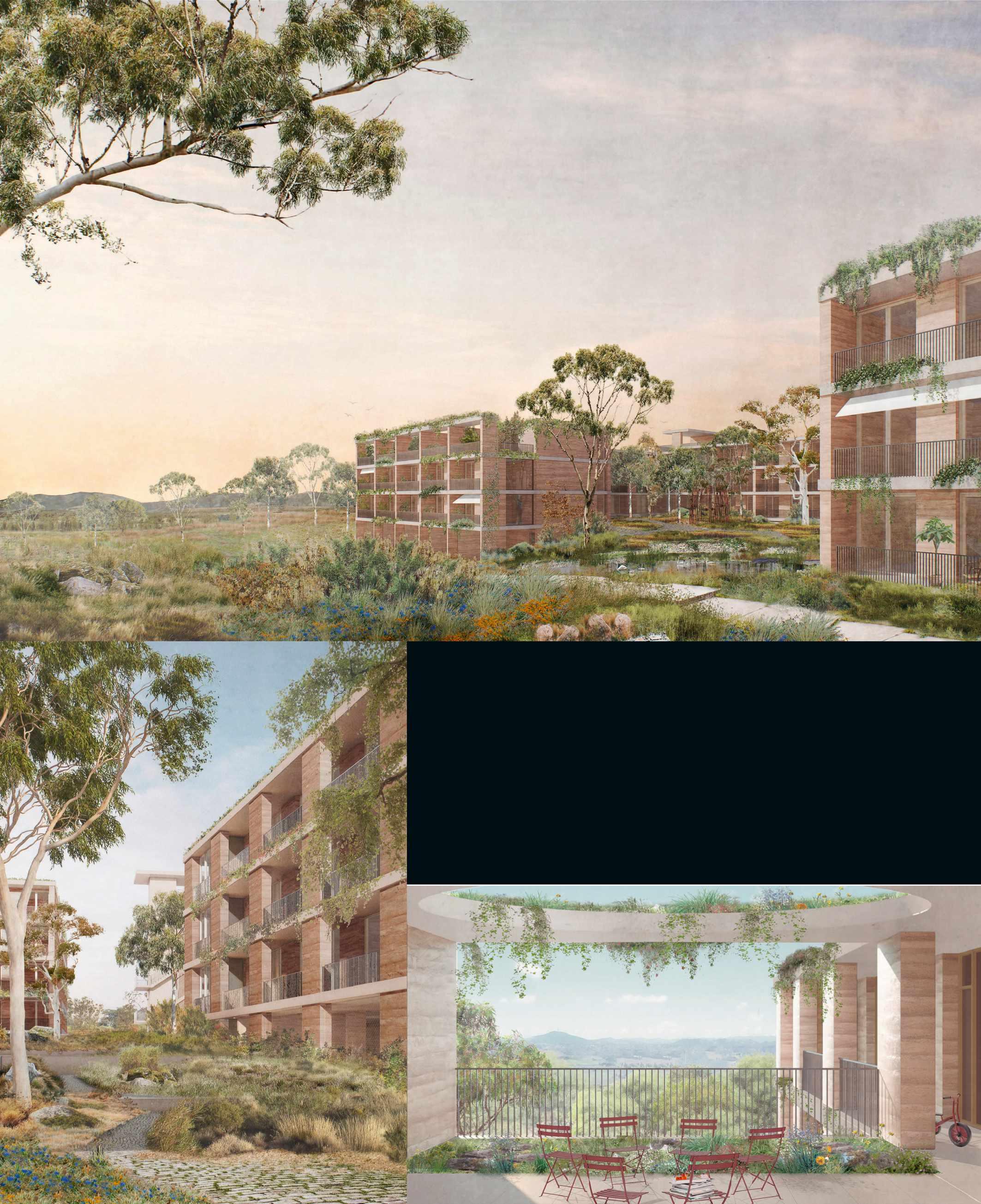
FEBRUARY 2023 GARDENSILLUSTRATED.COM 83
DAVID CHIPPERFIELD ARCHITECTS, ASSEMBLE AND JANE IRWIN.
News
COMPILED BY ANNIE GATTI
1 PLYMOUTH PARK
Detailed design plans are now being drawn up for a new, 1km-long linear park in Plymouth, Devon, that will create a green vista through the city centre leading to the sea. Avenues of trees will line the new landscape, which will include water features – a rill, a stream, dancing fountain jets – alongside play spaces, places to stop and rest, improved café seating areas, and a new amphitheatre space for performance in the existing Braille Garden. Trees and other plants will be selected for their resilience to the extremes of climate change. plymouth.gov.uk
2 SERPENTINE PAVILION
This year’s Serpentine Pavilion, which will be unveiled in June, has been designed by Paris-based architect Lina Ghotmeh. Inspired by nature and echoing the grounds and canopies of the trees surrounding the site, À table will use sustainably sourced timber ribs to support its suspended pleated roof. At the heart of the pavilion will be a table, around which people will be invited to gather and think about how to re-establish our relationship with nature and the Earth. The Pavilion will also be a platform for the Serpentine’s programme of live events. serpentinegalleries.org; linaghotmeh.com/en

runs
SENSORY GARDEN FOR CARE HOME
Care provider Loveday has installed a calming, sensory garden for people with dementia at its care home in Abbey Road, north London. Designed by Ed Freeman of Reardon Smith Landscape, the garden has been laid out using straight pathways, clipped hedging and raised beds. Generous quantities of evergreen planting create a lush, calm feeling while spring bulbs and selected perennials add an injection of colour placed in front of white screens. A water wall provides a sensory experience and a focal point on the back boundary. lovedayandco.com; reardonsmithlandscape.com
COVID MEMORIAL
The winning entry of the Sheffield Covid Memorial Competition is a stainless steel weeping willow tree designed by George King Architects. Bent steel tubes will fan out from the twisted trunk to form the branches of the tree, which will arch down to the ground, to create a space where people can gather. Messages of thanks to healthcare workers and tributes to loved ones will be embroidered on to ribbons and attached to the branches, forming the ‘leaves’ of the sculpture. The memorial, which will be surrounded by York stone paving, is due to be installed in Balm Green Gardens this spring. georgekingarchitects.com
TREETOP GARDEN
A Berkshire garden, which flows out across a steep escarpment into the treetops beyond, was the Supreme Winner in Pro Landscaper Magazine’s Small Project Big Impact awards 2022. Designed by Adam Vetere Landscape & Garden Design, the garden features a cantilevered deck, which appears to float across the 5m-high escarpment that cuts diagonally through the garden. The south-facing garden also features garrigue-style planting, with topiary for winter interest, in raised beds and a metal pergola to provide a shady eating area. Beyond this, steps lead down to the deck edged in Corten steel. adamvetere.co.uk

PARK ART
A new artwork, created by Harun Morrison, which highlights Britain’s role in the Atlantic slave trade, has opened in Gladstone Park in northwest London. The Anchor, The Drum and The Ship is a landscaped garden produced by Lin Kam Art on behalf of Brent Council, and is made up of three flower beds with planting, selected by Antonia Couling, that includes plants from Europe and Africa. The park is named after the Victorian Prime Minister whose father owned plantations in the Caribbean and received the largest of all payments made by the Slave Compensation Commission. brent.gov.uk; harunmorrison.net
DESIGN FEBRUARY 2023 GARDENSILLUSTRATED.COM 85
3 4 5 6 6 3 4 5
2 LINA-GHOTMEH; 5 ELLIE WALPOLE; 6 ANTONIA COULING © LIN KAM ART 2022.

OPEN TO NATURE
Californian landscape architect Scott Lewis has created an informal garden, open to the landscape, for two wildlife-loving artists
WORDS VERONICA PEERLESS PHOTOGRAPHS MARION BRENNER AND DAVID WAKELY
�e brief
It’s not often that a landscape architect gets to influence the placing of a new house, but that is what happened on this project in the Portola Valley in the San Francisco Bay Area. Scott Lewis, of Scott Lewis Landscape Architecture, was able to collaborate with Turnbull Griffin Haesloop Architects on moving three proposed interconnecting buildings six metres to the north. This created more garden space on the south side, and allowed the garden to wrap around the property and frame views to the west. It also allowed for a potting shed and preserved an Arctostaphylos manzanita grove.
The clients are artists and keen gardeners who wanted an informal garden that would blend into the surrounding landscape, known as oak chaparral. They also wanted to welcome wildlife – to the extent that they did not want boundaries. They requested native, drought-tolerant plants and an attractive way to showcase their succulent collection. A green roof and water harvesting and storage had already been incorporated to the house design, and the conservation of resources on the property was paramount.
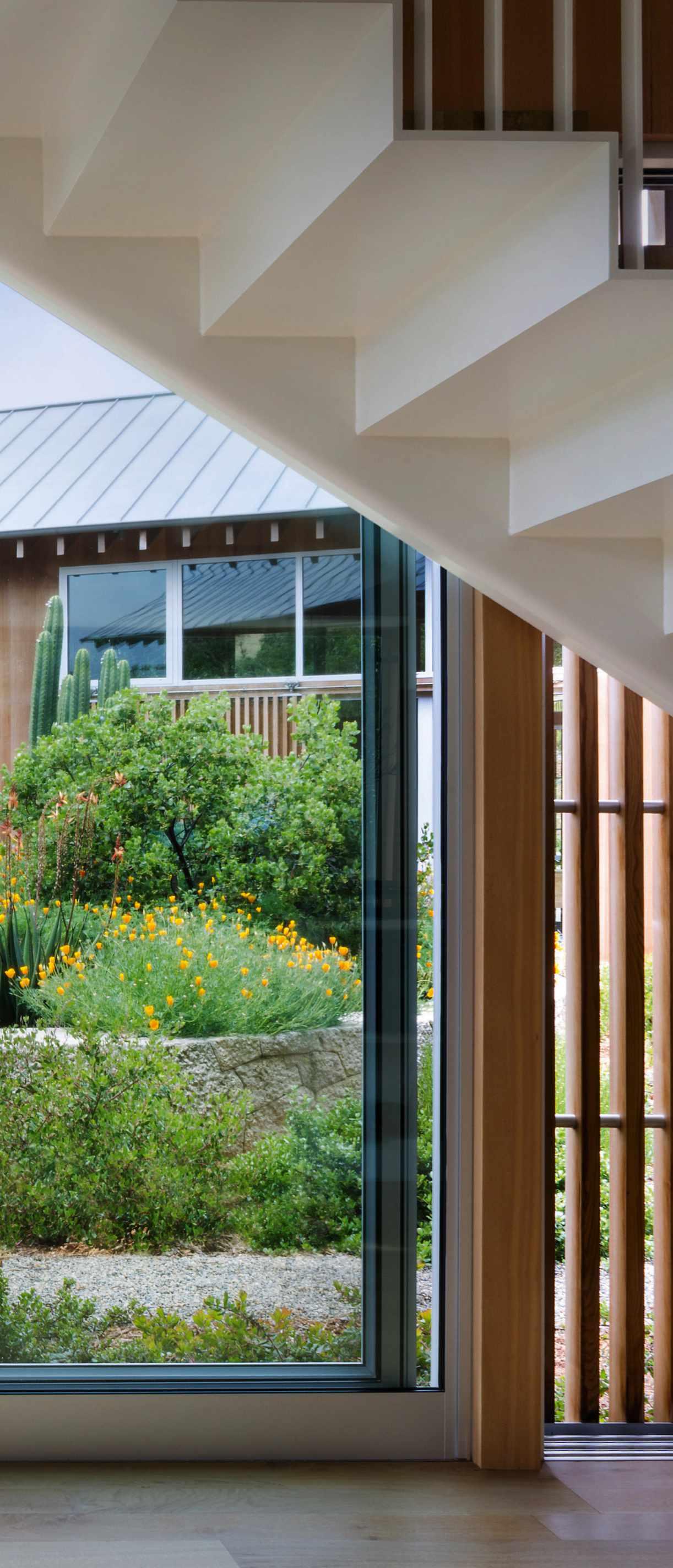
�e design
Scott proposed a “designed landscape” that would blend with the oak preserve beyond, using native and drought-tolerant plants and minimal hard landscaping. He also added a further requirement. Tall California redwoods were shading the site, blocking the view and showing signs of stress. “Redwoods don’t grow naturally on these hillsides,” he explains. “Their preferred environment is on the coast, where there’s ambient moisture from the fog. With climate change, the redwoods that were planted 30, 40 or 50 years ago in this area are getting stressed without irrigation. We decided to replace them with something more see-through and a better habitat for flora and fauna.”
The project was an enjoyable collaboration between Scott and his team, the clients and the architects, and in 2022 it won an American Society of Landscape Architects (ASLA) award. “There’s no lawn, but this is a good model for how to work in this climate to create a very beautiful look,” Scott says.
Turn the page to discover more design ideas
Left The new house is made up of three interconnected buildings, including studios for the artist owners. They wrap around a stone circle housing a collection of succulents, mixed with colourful plants that include the state flower, Eschscholzia californica
FEBRUARY 2023 GARDENSILLUSTRATED.COM 87
DESIGN INSIGHT
A designed landscape
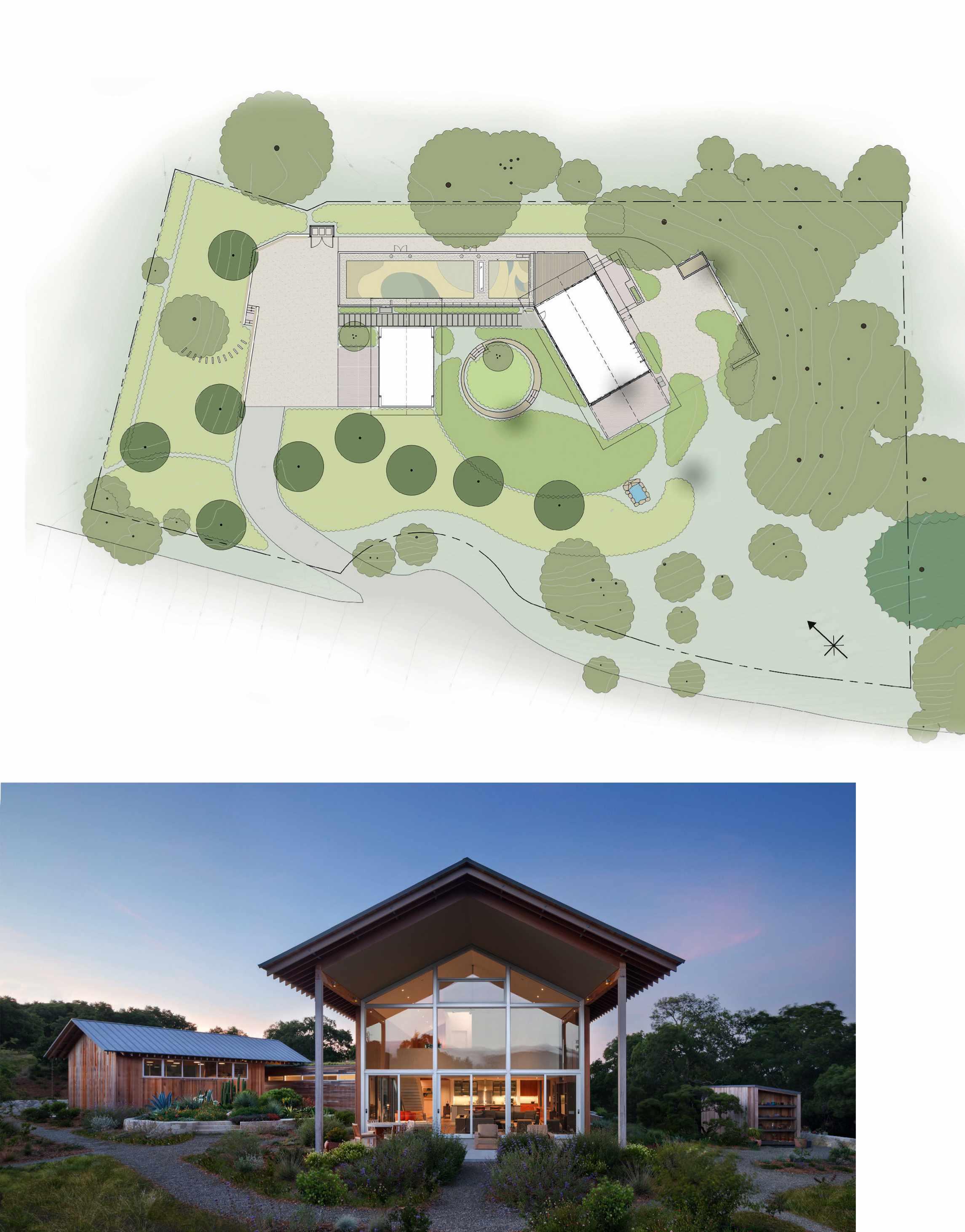
KEY FACTS
What Private garden on a gently sloping site. Where California. Size One acre. Soil Thin, silty clay. Climate Mediterranean.
1 No boundaries
Unusually, the clients didn’t feel it necessary to fence their site. “They weren’t planning a rose garden, or a garden more suited to the east of the country, or a space filled with precious plants. They wanted something very much of its place,” says Scott. “They wanted durable, native and drought-tolerant plants that would attract the wildlife that already passed through the existing garden.” Wildlife here includes not just birds, bees and butterflies, but also deer, raccoons and skunks.
2 3 1 4
N
1
2 Potting shed
Designed by the architects, the Western red cedar building echoes the house. The outdoor shelving displays plants, while the interior is for potting and storage. Nearby, a mazanita tree (Arctostaphylos manzanita) with beautiful, contorted cinnamon bark is framed against an exterior wall of the shed. This area is surrounded by gravel to allow for experimentation with new plant cultivars. Beyond, a culinary garden and outdoor grill are incorporated in a cast concrete terrace off the kitchen.


4 Hard landscaping
There is limited hard landscaping the garden. The terrace outside the main living area is simply a single slab of cast concrete that flows from the house. Almost all of the paths and surfaces are surfaced with a grey pea gravel. The owners did not want any edging around the borders for a more informal look, and also wanted to be able to move plants around. “We brought in some soil, but mostly, the existing soil was decompacted so that it became friable again,” explains Scott. “The paths were tamped down so that the soil was as firm as possible and gravel was then put on top.”
3 Stonework
Rough-hewn stone walls define the edges of the space, evoking the natural rock outcrops on the site. These were made of tufa limestone, the preferred material of the sculptor and stonemason Edwin Hamilton. “It can be cut very tightly and has an interesting texture,” says Scott. Edwin assembled the raised circular bed that houses succulents and the L-shaped seat wall near the potting shed in his workshop, numbering each piece on the back so it could be reassembled on site. He then added texture to the surface by using a blunt chisel.

FEBRUARY 2023 GARDENSILLUSTRATED.COM 89
DESIGN INSIGHT
Turn the page for planting ideas 2 3 4
The planting
1 Succulent circle
The owner had collected a range of succulents that she wanted to consolidate, now housed within the tufa stone circle. “They now look like a giant table arrangement from inside the house.” The owner supervised the planting, and Scott’s team added fillers and trailing plants that drape down the side and give a little softness to the walls.


2 Native plants
The property uses a grey water and rainwater harvesting system as a source of irrigation, devised in conjunction with a water management company. The key to water saving on this project, however, was the plant selection. “Native plants don’t need much irrigation,” explains Scott. “California normally gets its rain in the winter, between November and March, and that’s what they’re adapted to. We have no rain between April and October, but native plants don’t need water in summer, as they go dormant or lose their leaves. That said, our recent dry winters means there’s an increasing need for irrigation then.”
Scott used a handful of plant groups, including salvias, grasses and ceanothus. “Within those, different species and varieties add layers and beauty.” Large Cleveland salvias (Salvia clevelandii) are a key plant as they are big, bold and weed-smothering. “They have a strong, musky scent and I’ve grown to love them more than lavender.” The native deer grass (Muhlenbergia rigens), which has tall flower spikes, is another key plant –“Despite its name, deer don’t eat it” – alongside the state plant, California poppy (Eschscholzia californica), which self-seeds freely. Ten new live oaks
1
were added and California pipevine (Aristolochia californica) trails in the trees’ understorey. Scott also used a handful of drought-tolerant, non-native plants, including Salvia x jamensis (sometimes sold as Salvia greggii), which is native to Texas and Mexico and comes in a wide range of colours.
“Having lived on the site for around ten years, the clients were familiar with the wildlife that passed through – primarily deer,” says Scott. “You can manage that if you have a palette of plants that might be nibbled occasionally, while the real food sources are elsewhere.” The clients already had a handle on what deer eat, so the garden has suffered only a few losses. “Deer ate a native redbud that we planted at the back of the house, but ignored one at the front.” Scott and the clients selected almost 40 native, drought-tolerant plants, planted in bold drifts, that would appeal to the birds, bees and butterflies of the adjoining nature reserve.
3 Green roof
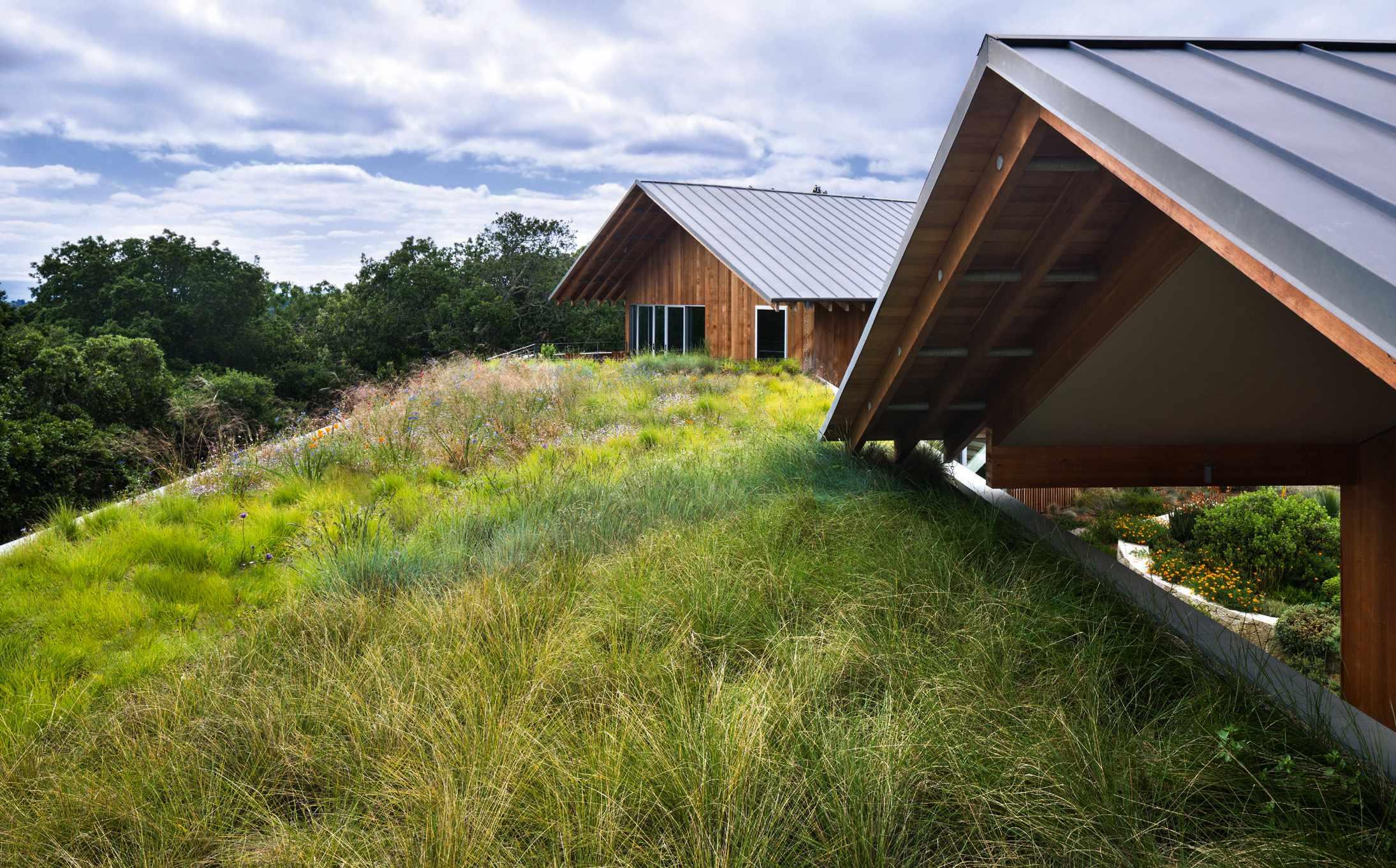
On top of the studio’s flat roof Scott created a meadow garden using eight different grasses, plus native wildflowers and bulbs that were chosen in collaboration with the clients and US grass expert John Greenlee. Providing interest throughout the year, it also helps to merge buildings with garden, and with the landscape beyond. It is planted using a tray system, with a 22cm depth at its deepest point to accommodate grasses. The plants, mostly plugs and small plants in 9cm pots, were laid out on site, for an organic look. The shortest plants are near the deck in front of the bedroom, while the tallest grasses are at the end farthest from the house. Drip irrigation is used in summer, when the temperatures are typically above 30°C. “The plants are always green, for the visual effect but also for fire safety,” explains Scott.
USEFUL INFORMATION
Find out more about Scott Lewis Landscape Architecture at sllasf.com
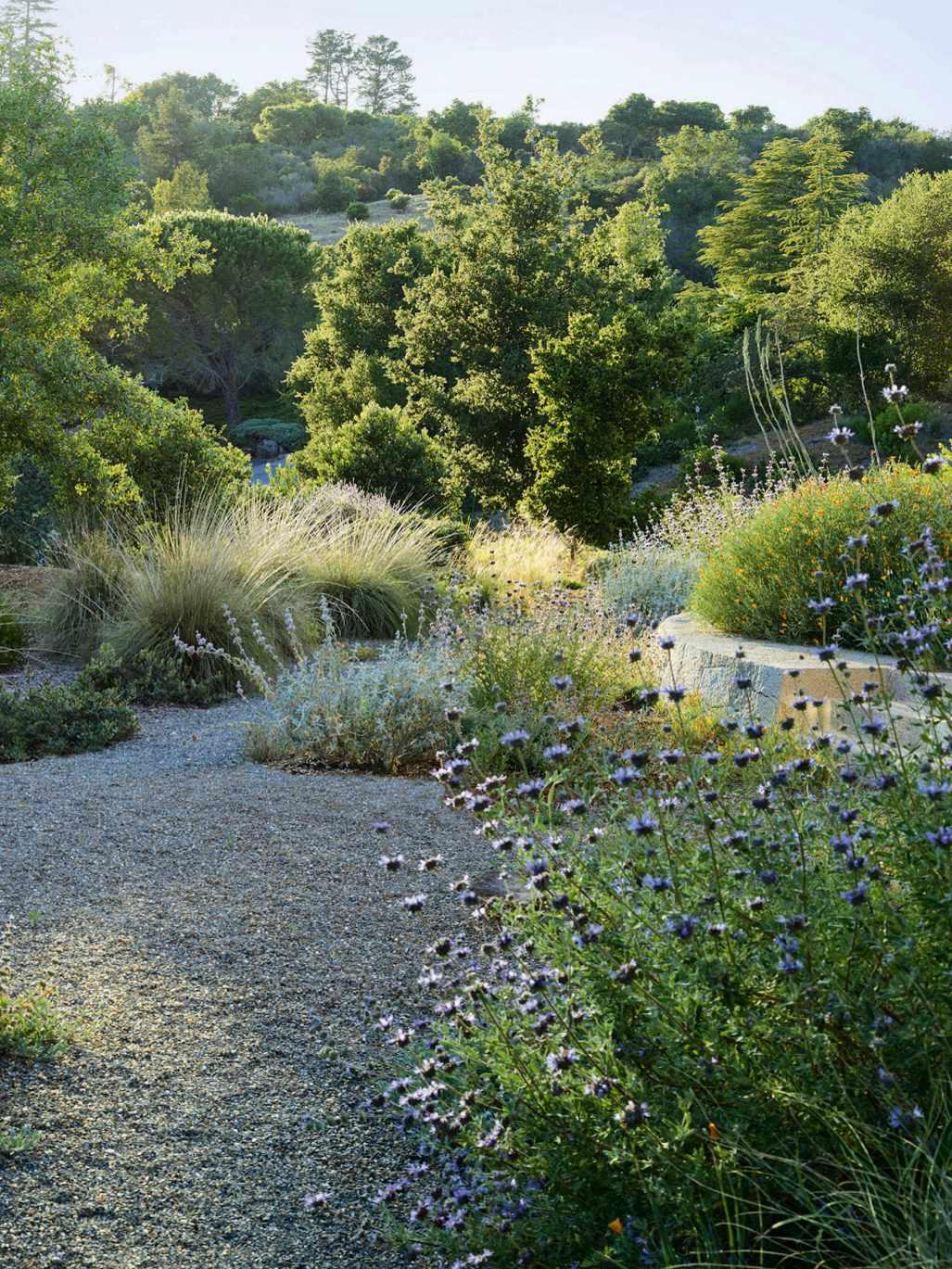
FEBRUARY 2023 GARDENSILLUSTRATED.COM 91 DESIGN INSIGHT 3 2
SOURCEBOOK
Plant display stands
Show off your pots and containers in dramatic style this spring
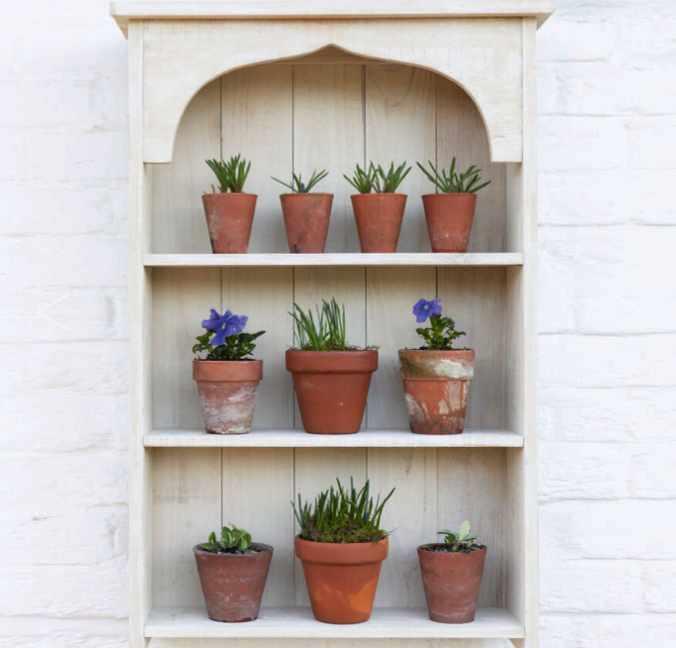
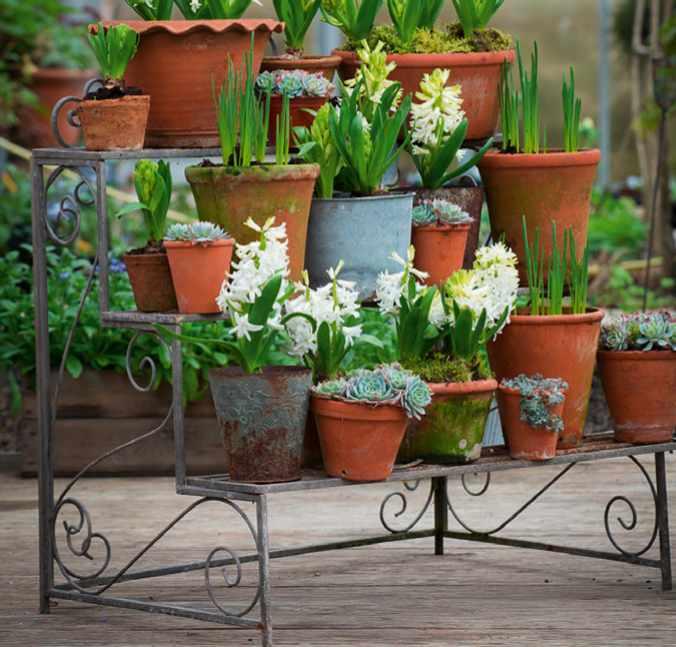
COMPILED BY MOLLY BLAIR
LOW KEY Barrington Plant Stand, £130, Garden Trading, 01993 845559, gardentrading.co.uk
VINTAGE VIBE
Rustic Cast Iron 3 Tiered Garden Plant Etagere, £189, The Farthing, thefarthing.co.uk
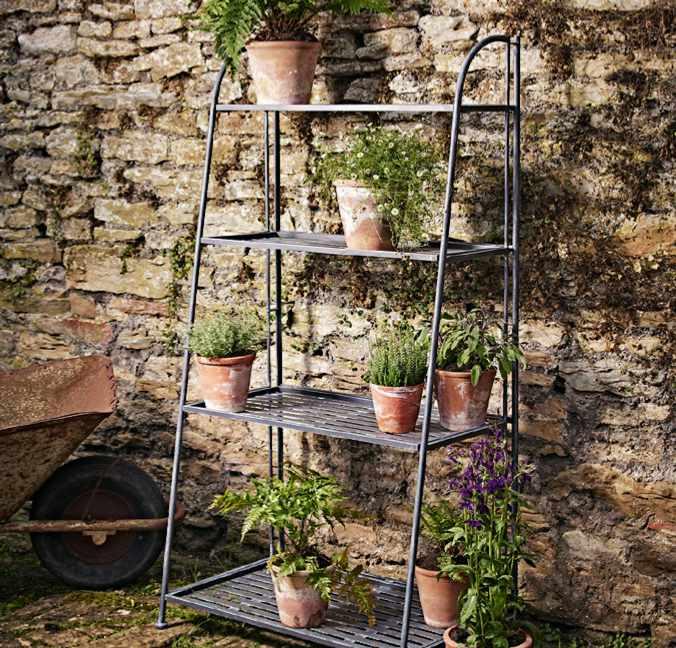


COLOUR SPLASH
Plantsman’s Benches £780, Alexander Hoyle, 07528 019255, alexanderhoyle.co.uk
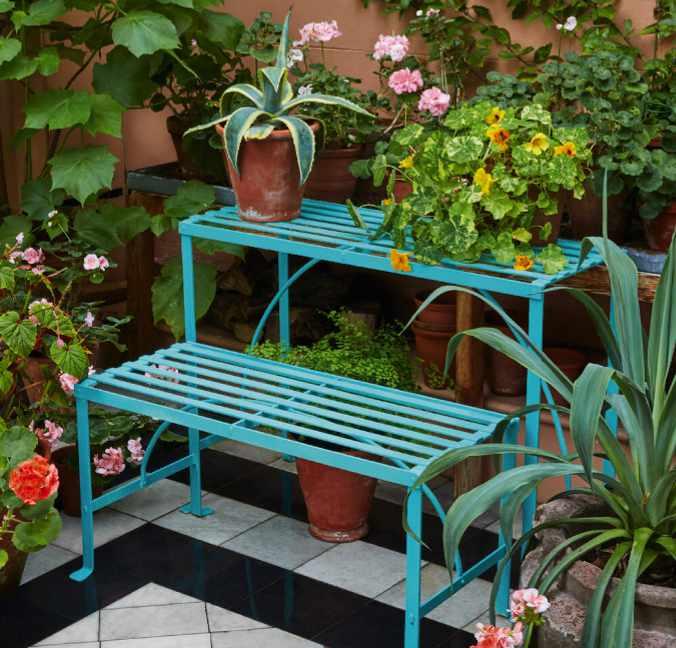
TIMBER TOWER
Rowlinson Garden Creations Plant Stand, £133.66, Bradfords, bradfords.co.uk
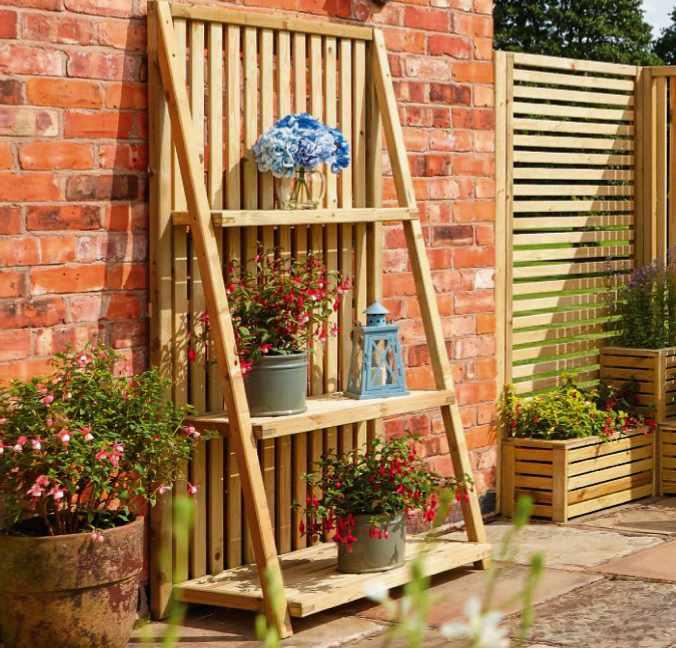
HANDMADE CHOICE
Classic Auricula Theatre, From £185, Bud To Seed, budtoseed.co.uk
CLEAN CUT Como Tiered Plant Stand, £168.75, Cox & Cox, 0330 333 2123, coxandcox.co.uk
ORNATE DETAILS
Iron Plant Theatre, £139.95, Sarah Raven, 0345 092 0283, sarahraven.co.uk
CONTEMPORARY PICK
Menton Plant Stand, £495, The Worm That Turned, 0345 605 2505, worm.co.uk
FOR FOLDING
3 Tier Folding Plant Stand, £44.99, Von Haus, vonhaus.com
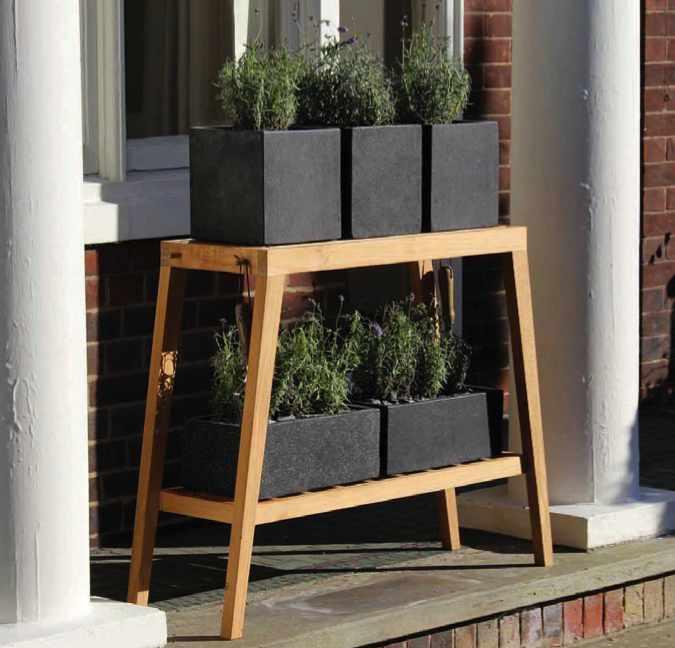
Discover a wider range of plant stands by scanning this QR code with your phone camera, or visit gardensillustrated. com/plantstands

92 GARDENSILLUSTRATED.COM FEBRUARY 2023
DESIGN
Education Guide
Are you looking to change career, gain accreditation or simply learn more about your passion? Choose the best option for you from this selection of full-time, part-time and short courses.



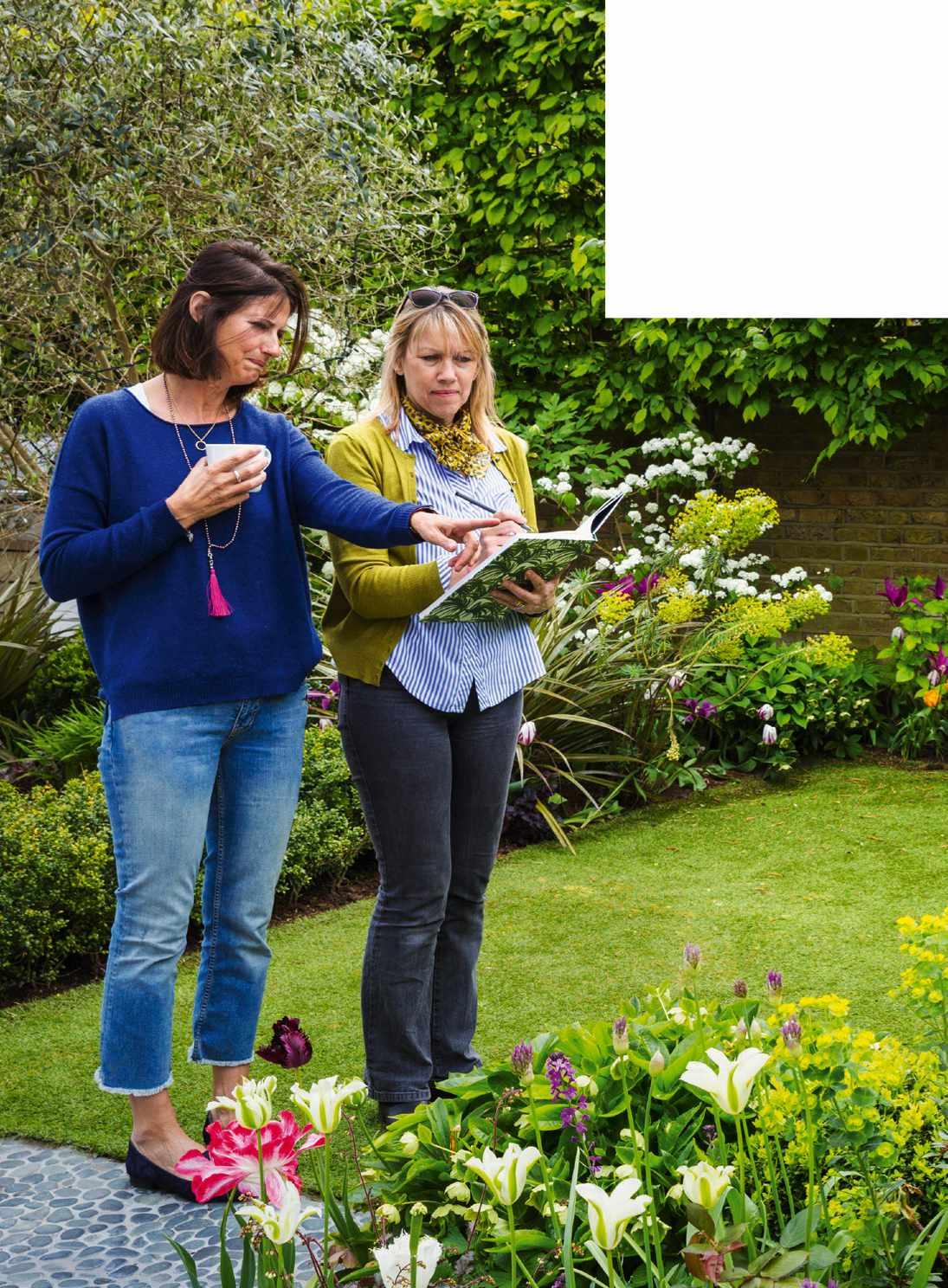
ADVERTISEMENT FEATURE
Images Clockwise: Getty/Luis Alvarez, FangXiaNuo, Oliver Rossi, Mint Images
Juliet
Sargeant’s
Sussex Garden School
From composting-to-cross Stitch, enjoy a garden-inspired day at �e Sussex Garden School
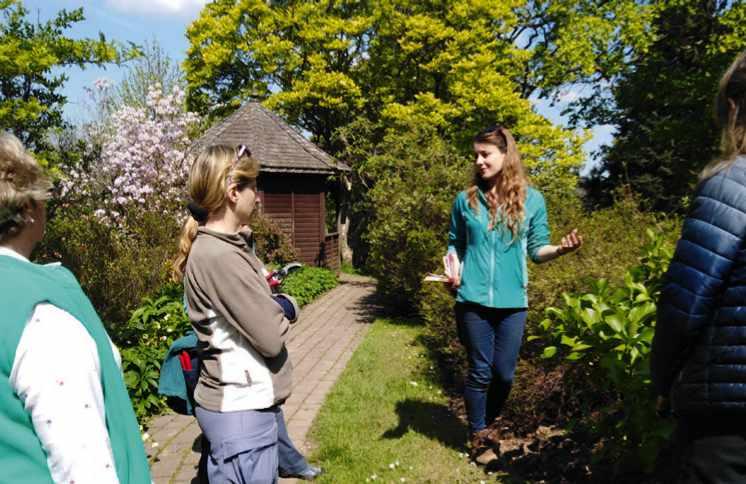
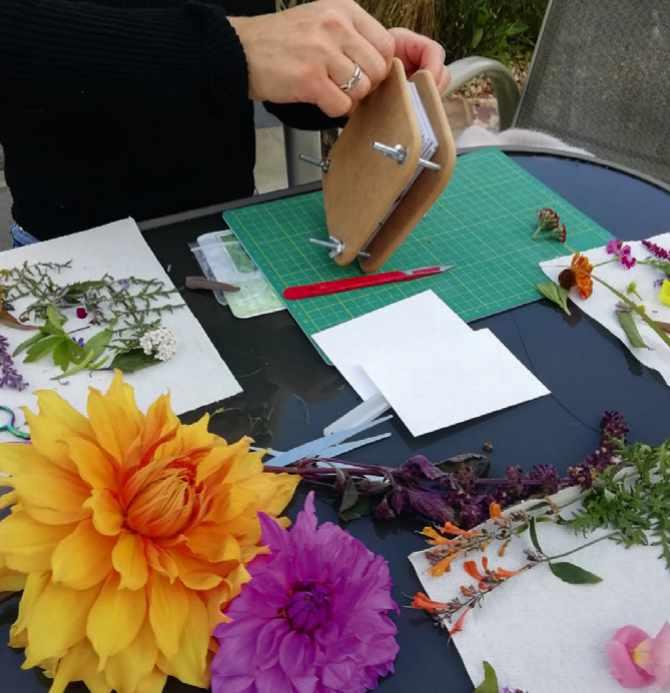


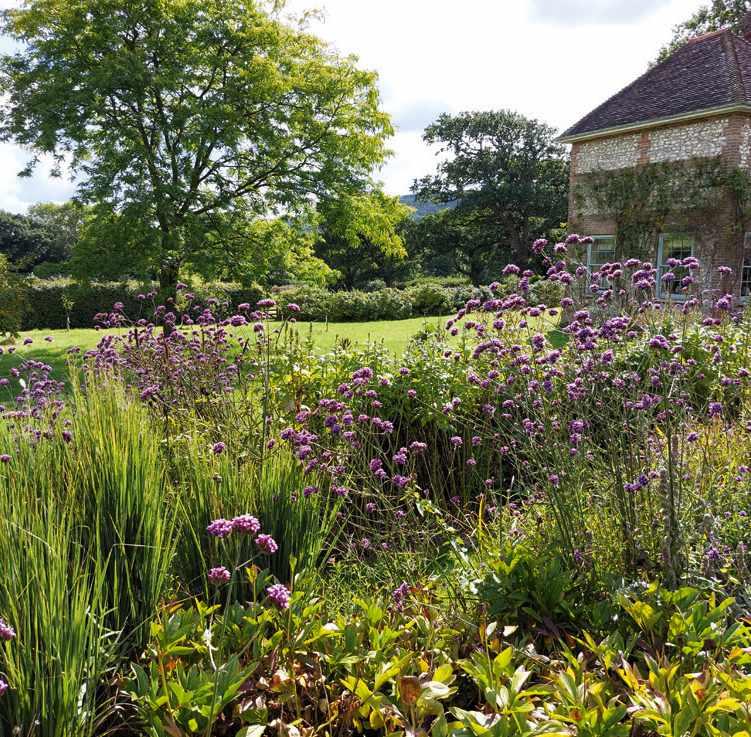
Juliet Sargeant is an award-winning garden designer and Radio 4 Gardeners Question Time panellist. She delights in sharing her love of plants, design and ‘all things garden’.
Juliet has gathered together an expert team of designers, creatives and crafters to o�er a wide range of courses, inspired by landscape.


At The Sussex Garden School, you can spend a day learning about anything from composting to cross-stitch. Our aim is to take you out of your everyday, and give you time to immerse yourself in nature. At one of our beautiful Sussex garden venues, you will be treated to a delicious lunch or refreshments and enjoy a relaxing atmosphere with like-minded enthusiasts. Our step-by-step design days will guide you through improving your own plot.
Taught by experienced professionals, these illustrated courses will equip you to plan the layout or planting that will give your garden that professional look. We have two-day, design-your-own-garden courses; wildlife gardening; pond design and various planting days. Each workshop is accompanied by illustrated, colour handouts and all the necessary equipment. Our craft courses are hands-on, have-ago days, with a variety of garden-inspired themes. This year we are delighted to o�er seasonal introductions to pressed flowers, lino-printing and fused glass art. Each day starts with a welcome cuppa and introduction to the craft. Drawing inspiration from the lovely cut-flower fields of Pitfield Barn Farm, you will develop your
own designs to translate into the medium of the day. It is so satisfying to leave, not only with a new skill, but also with homemade gifts for yourself or a friend.
For 2023, we are delighted to be joined by professional horticulturalist, Jenny Samuels. This is a rare opportunity to garden alongside a seasoned gardener, learning all her tricks of the trade as the year progresses. With her new course ‘How to Garden Greener’, Jenny will be emphasising sustainable gardening techniques and how to create a garden that is great for wildlife, as well as people. We also o�er gift vouchers, so check our website, to find a garden-inspired course for yourself or a friend.

info@julietsargeant.com sussexgardenschool.com
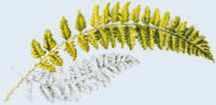
ADVERTISEMENT FEATURE
�e London College of Garden Design
Widely regarded as one of the world’s leading garden design colleges, the London College of Garden Design has a wide range of courses for those aiming to start a career in garden design and continuing professional development for experienced designers.
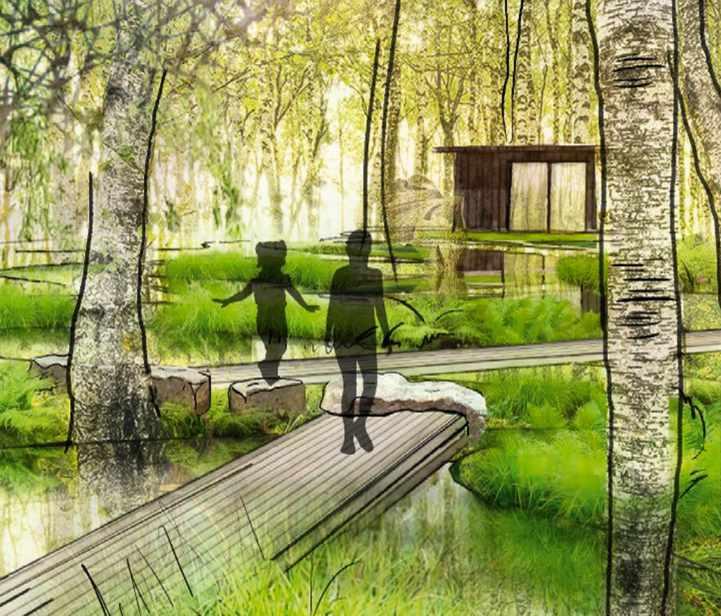
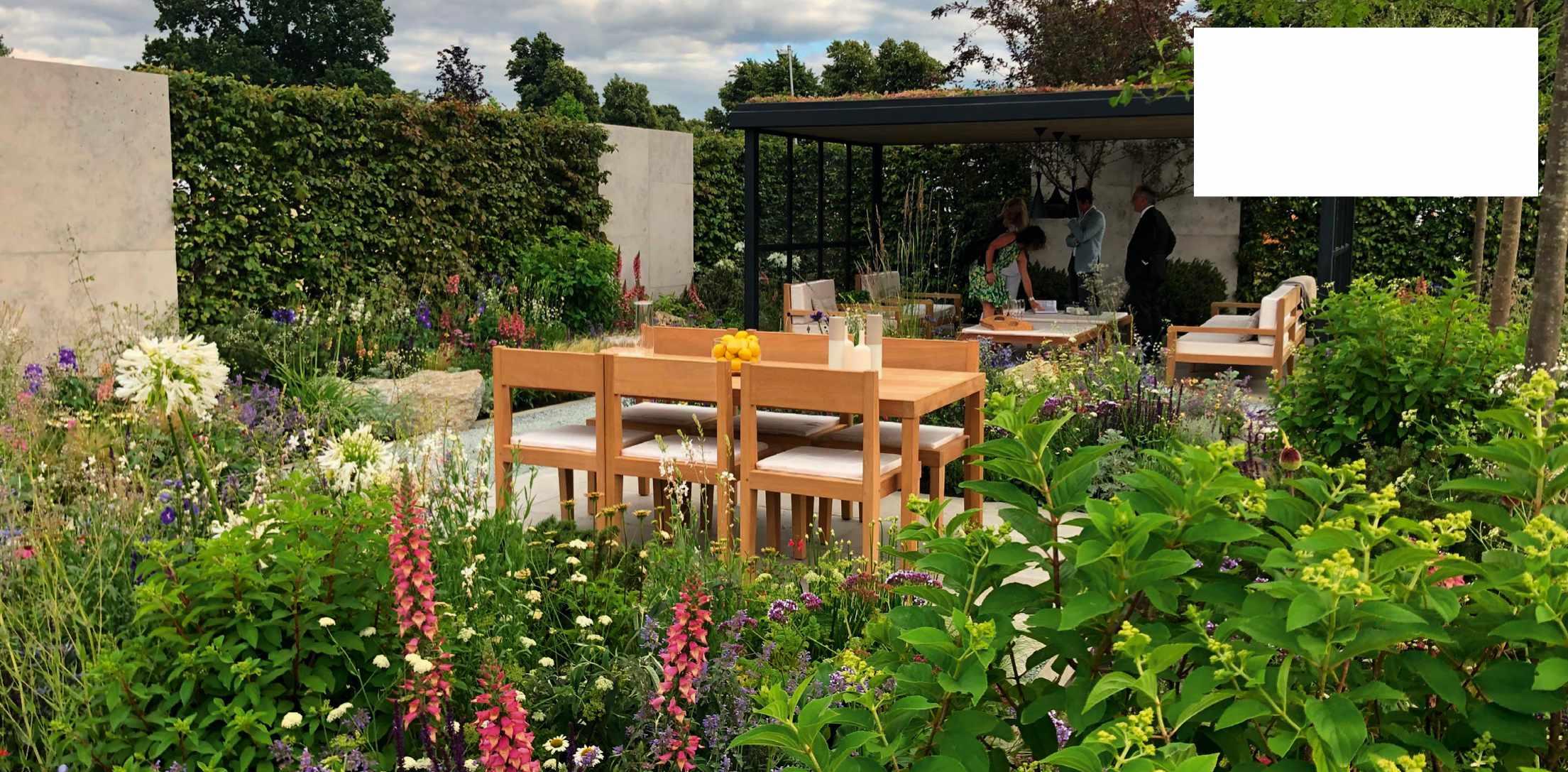
THE LEADING GARDEN DESIGN DIPLOMA
Our one-year Garden Design Diploma led by Andrew Wilson welcomes students both in-person at the Royal Botanic Gardens, Kew, and in real-time online classrooms. We o�er an exciting and often demanding environment that teaches not just the fundamentals of design but also develops skills in planting and construction design and running your own successful garden design studio.
Every class is taught by expert tutors who are all practicing professionals and we ensure that our students get the opportunity to take part in inspirational visits and free graduate seminars. And if you are in Australia or New Zealand you can join this course with our partner college in Melbourne.

AWARD WINNING GRADUATES
Our students have won the majority of Society of Garden Designers Student Awards since they began and regularly graduate to work for some of the world’s leading designers and win major awards
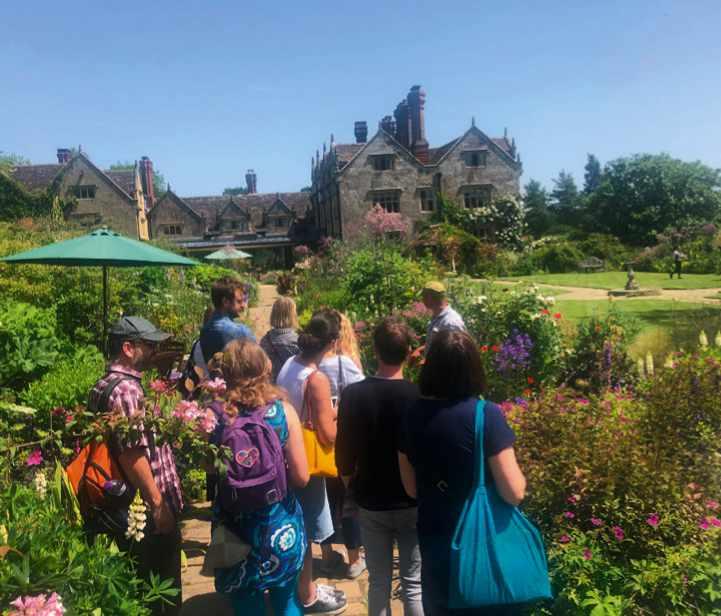
for themselves. Our free graduate programme gives you extra training opportunities and the chance to design gardens in prestigious locations.
CONTINUING PROFESSIONAL DEVELOPMENT
There are a wide range of opportunities to develop your career through our other extended courses. Our six-month intensive Planting Design Diploma is led by Andrew Fisher Tomlin with the involvement of some of the world’s leading planting specialists. We also o�er a certificate programme in Construction Design to help you enhance your career prospects. These are also available online in real-time classrooms or in blended learning formats. To find out more download a prospectus from our website.
CLASSROOM BASED COURSES
We also o�er courses in conjunction with the Royal Horticultural Society at RHS Garden Wisley and at Denmans Garden in Sussex. All these courses aim to be suitable for both professionals and the garden enthusiast. In 2023 they will include subjects such as designing for wildlife, for well-being and seasonal planting design. info@lcgd.org.uk
01483 762955 | lcgd.org.uk
EDUCATION GUIDE
Inspiring courses for the garden professional
�e Viking Cruises Lagom Garden at the 2019 RHS Hampton Court Garden Festival, designed by 2016 graduate Will Williams.
Students have the option to study in-class and online.
Planting Design Diploma students on a �eld trip.
2019 graduate Helen Saunders’ awardwinning design for an educational landscape and wildlife habitat.
Inchbald is one of the most established garden design schools in the world. For over 50 years we have been creating successful garden design careers.
So many of the world’s leading designers are Inchbald graduates. /�i��Ûi >���Li�iwÌi` vÀ���Ì�i���}��ÃÌ>�`>À`


of tutoring on which the school’s reputation is built. Now they help our current students on their pathway to success by off ering advice, internships and frequently employment.
Find out more visit inchbald.co.uk today.
CREATING CAREERS YEARS ADVERTISEMENT FEATURE Luciano
60 020 7730 5508 | gardens@inchbald.co.uk | inchbald.co.uk ESTABLISHED 1960 Some of Inchbald’s star graduates On campus and online full time and part time courses Target the garden design school Ì�>Ì >���ÜÃ���Õ Ì��ÃÌ>ÀÌ���ÕÀ V>ÀiiÀ Ü�Ì��V��w`i�Vi
Giubbilei, Marcus Barnett, Kamelia Bin Zaal, Philip Nixon, Angus Thompson, Jonathan Snow
Scotland’s Rural College

Scotland’s Rural College o�ers a range of courses from NC level to postgraduate in subjects ranging from Horticulture to Garden and Greenspace Design.


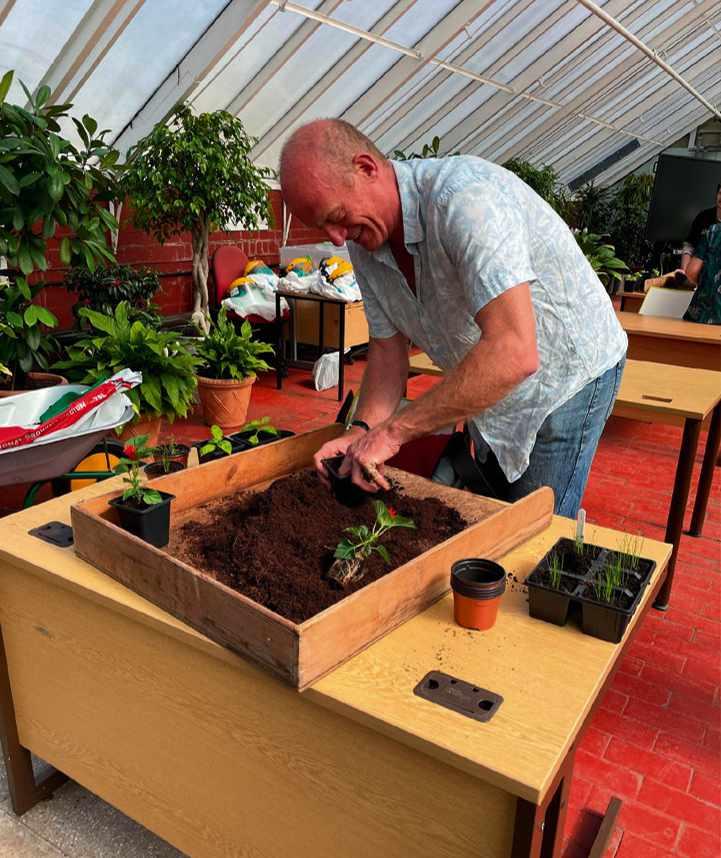

Students learn at the Edinburgh campus in conjunction with the illustrious Royal Botanical Gardens as well as the stunning Queen’s Park Victorian glasshouse in the south side of Glasgow. With degrees awarded by the University of Glasgow, the institution sees many of its students go on to flourishing careers, with alumni including the BBC Gardeners’ World presenter Frances Tophill.
The institute also o�ers a variety of programmes related to the land-based industries with Wildlife and Conservation Management being a popular choice with mature students or those returning to learning and looking to give something back and engage with nature. Returners aged 25 and over can take advantage of the
Change Your Path bursary of £1,000 to help with the cost of becoming a new student.
One recipient of the bursary, Kristyna Andrlova, changed from a career in the hospitality industry, to study Garden Design in Edinburgh her reasons for the change are “Simple yet complex. In my eyes, garden design means creating a piece of art, that consists of pieces of life. Life process fascinates me and I always wanted to create and help protect the environment. I think garden design encompasses all of these and so much more.” Her plans after graduating are ambitious also, “I would like to get some work experience while studying and after graduation get a job in a GD/landscaping firm. Eventually, I would like to start my own business once I feel

competent enough to do so.”
Ana Basto, another recipient, switched from working in a warehouse to the HND Wildlife and Conservation Management Programme at the Oatridge Campus. “I’ve found each aspect of the course has increased my knowledge and understanding and given me a realistic overview of the field of conservation. The Change Your Path bursary has given me the opportunity to focus on my studies for the last academic year, by supporting me with my finances and reducing some of the added pressures of studying full time while working part-time.”

sruc.ac.uk/horticulture sruc.ac.uk/gardendesign sruc.ac.uk/conservation

EDUCATION GUIDE
Gardenize
Keep track of your plants with the Gardenize gardening app!
Beginner, enthusiast or professional. Are you ready to take your gardening to the next level? Garden smarter and let Gardenize be your gardening partner. As a plant lover, you’ll likely want to stay on top of things year-round. Discover the simplicity of having your garden in your phone and doing work in your garden from anywhere.
On the Gardenize app you have all your plant notes, images, and garden events in one place, instantly searchable and available, wherever you go and regardless of the temperature outside. By keeping everything in one place, and creating an organised index feed of your plants, areas and methods of cultivation, you will have all the information you need whenever you need it. Check on the seeds you need while you’re in the garden centre, mark where you plant your bulbs while in your garden and show photos of your flower beds when at social events and someone asks how they were planted.
In order to keep track of everything you need to remember in your garden, you can set reminders when you need to prune your
apple tree, repot your tomatoes or plant your bulbs, you can read inspiring articles about gardening now, and create your own garden to-do lists. Free up your mind and let Gardenize remember for you.
“I’m so glad Gardenize exists! Without your app, I wouldn’t have even remembered the names of my plants, let alone where they are and how to take care of them.”

Ann, Sweden
“I’m loving the app! Fully enthralled now, I have my areas and plants linked. It’s great that I can add multiple photos to each plant and event. Using the app and sorting out photos is just as fun as being out in the garden. Thank you for a fantastic app!”
Cameron, USA
Do as over 400,000 other gardeners and download the Gardenize gardening app to keep track of your garden. Good luck in your garden, and getting organised with Gardenize!

gardenize.com

ADVERTISEMENT FEATURE
Garden Masterclass
Garden Masterclass is Annie Guilfoyle and Noel Kingsbury and we o�er a unique education portal for garden and landscape people.
• We seek out experts and innovators, whether well-known or waiting to be discovered. We organise live one-day workshops in gardens across the British Isles.

• Many of our workshops are recorded, allowing others to share in the experience.


• We produce educational webinars,
recordings are available from our website.
• We commission films about exceptional gardens and their creators.
• Our membership scheme gives access to exclusive live and web-based events, discounts on webinars and recordings and access to an extensive online library.
• Some of what we do is free! Thursday
Garden Chat is our weekly public service broadcast at 6pm London time. All are recorded for YouTube and website viewing. • We have over 50 hours of recorded webinars, 70 hours of free public viewing along with 70 hours viewing exclusively for our members. gardenmasterclass@gmail.com gardenmasterclass.org
EDUCATION GUIDE
Great Dixter House and Gardens
Study Days are led by head gardener Fergus Garrett and held at Great Dixter House and Gardens.

Each Study Day includes a lecture in the house as well as talks and demonstrations in the garden. Subjects are tailored to provide insight into the Great Dixter ethos of gardening. Refreshments and lunch are included and there is a 10 per cent discount for attendees on plant sales in the nursery on the day. Great for all ranges of gardening knowledge. £160.00 per person.
COMING UP
20 February 2023 – Succession Planting in the mixed border – Fergus will use the borders at Great Dixter to illustrate how you can create a long season border using structural plants, underplanting and interplanting of bulbs, self-sowers, and pockets of ephemerals, climbers, and good maintenance.
6 March 2023 – Designing with Plants –Learn how to combine plants using colour, shape, texture, repetition and balance. The aim is to bring you closer to designing your borders and associating plants with ease. Includes slides and talks, plus sessions in the garden. education@greatdixter.co.uk greatdixer.co.uk

ONE YEAR GOOD GARDENING DIPLOMA
September 2023 – beg July 2024 BOOKING NOW
Covers the best in planting design while training in the more serious aspects of horticultural techniques. Practical sessions held at Arundel Castle under the guidance of head gardener Martin Duncan and at Sandhill Farm House, Rogate. Lectures by many leading gardening personalities and regular visits to outstanding private gardens. Students also learn to draw up planting plans.
(1 day a week (Tues), 10.30am–3.15pm, over three terms)
THE ESSENTIAL GARDEN DESIGN DIPLOMA
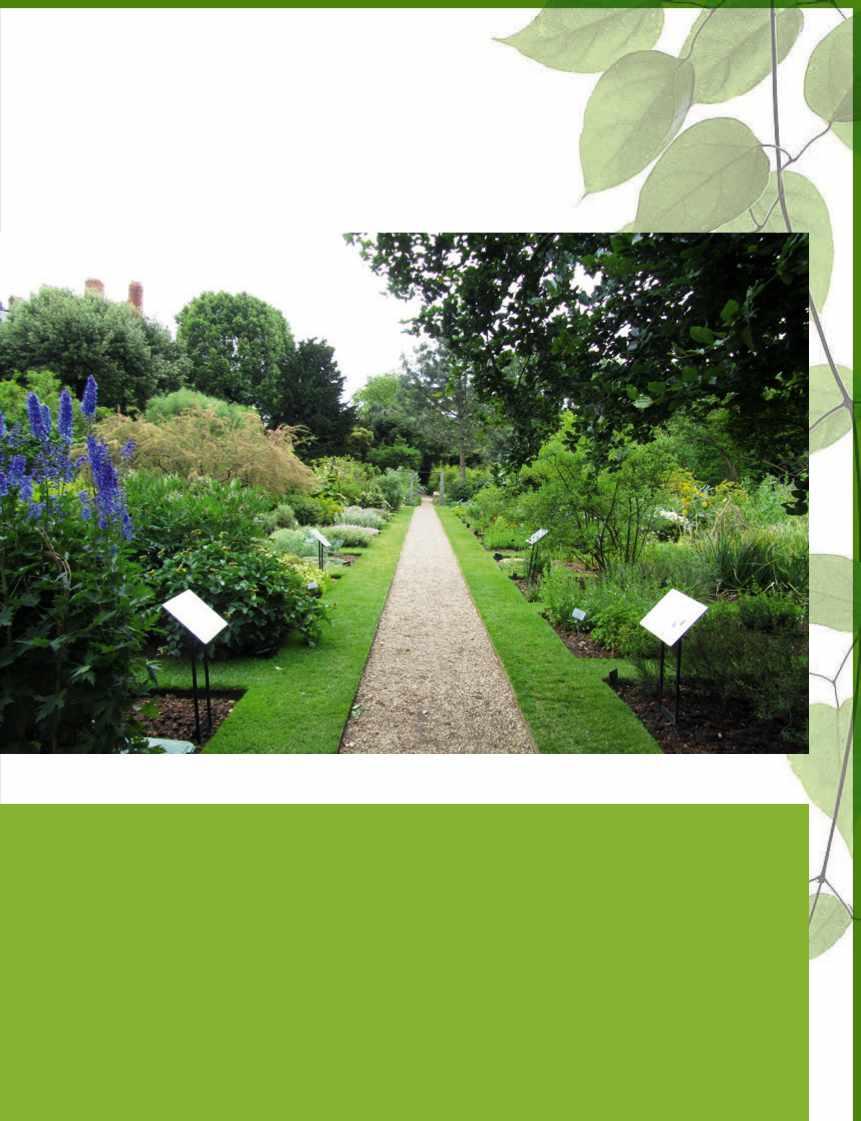

January – March 2024
Based at the Chelsea Physic Garden and led by Rosemary Alexander and architect Catriona Rowbotham, the course is an overview of Garden Design, covering all the elements needed to rethink an average garden. Taking students step by step through site surveying, using the grid, horizontal and vertical features, garden layouts and planting plans, costing and specification, plus drawing tuition and homework on design and plant portfolios. Tutors are well respected in the industry and will guide students on how to succeed in this diverse profession.
(2 days a week (Wed & Thu), 10.30am–3.15pm, plus 2 days homework)
GARDENING FOR BEGINNERS
Wednesday & Thursday 19, 20, 26, 27 April 2023
One of our most popular courses, led by master horticulturist Ben Pope, which aims to take each student through all the practical elements of caring for a garden from soil, tools, maintenance, seed sowing and propagating, weed control and pests and diseases. The first 3 days will be spent with lectures at the Chelsea Physic Garden and the final day will be spent gaining practical experience in Rosemary Alexander’s much praised garden near Petersfield and another private garden nearby, where Ben is in charge. Participants will be given a chance to prune, plant, sow seeds and regular maintenance tasks will be discussed. A light lunch and refreshments will be provided daily.
GARDEN DESIGN & CARING FOR YOUR GARDEN
Distance Learning Courses study anytime, anywhere in the world
A stepping stone to a new career. These two correspondence courses are a step by step guide to either designing your own garden or learning how to plant and maintain an existing garden: drawing up plans, hard landscaping, site analysis, planting, month by month tasks etc. Taught through a comprehensive course book, with projects submitted to us. (1-3 years to complete and individual assessment)
ADVERTISEMENT FEATURE
established as the leader in all design and gardening tuition and based at the unique and historic Chelsea Physic Garden
sure which Diploma course is for you? We prefer potential students to attend an Information Session when Rosemary explains the whole course content and you can see our facilities at the historic Chelsea Physic Garden. JUST CONTACT US TO SET UP A DATE/TIME www.englishgardeningschool.co.uk Email: info@englishgardeningschool.co.uk Tel: 01730 818373
Long
Not
Garden of Medicinal Plants – Chelsea Physic Garden Photo: R Alexander
Learn with us
Explore our programme of courses
• botanical art

• plant science
• ŚŽƌƟĐƵůƚƵƌĞ
• photography
• garden history
• ĐƌĞĂƟǀŝƚLJ�ĂŶĚ�ǁĞůůďĞŝŶŐ
@CUBotanicGarden
www.botanic.cam.ac.uk • Tel: 01223 331875

Norfolk School of Gardening
�e UK’s leading gardening school. For anyone with an interest in gardening and keen to learn more, from beginners to professionals.
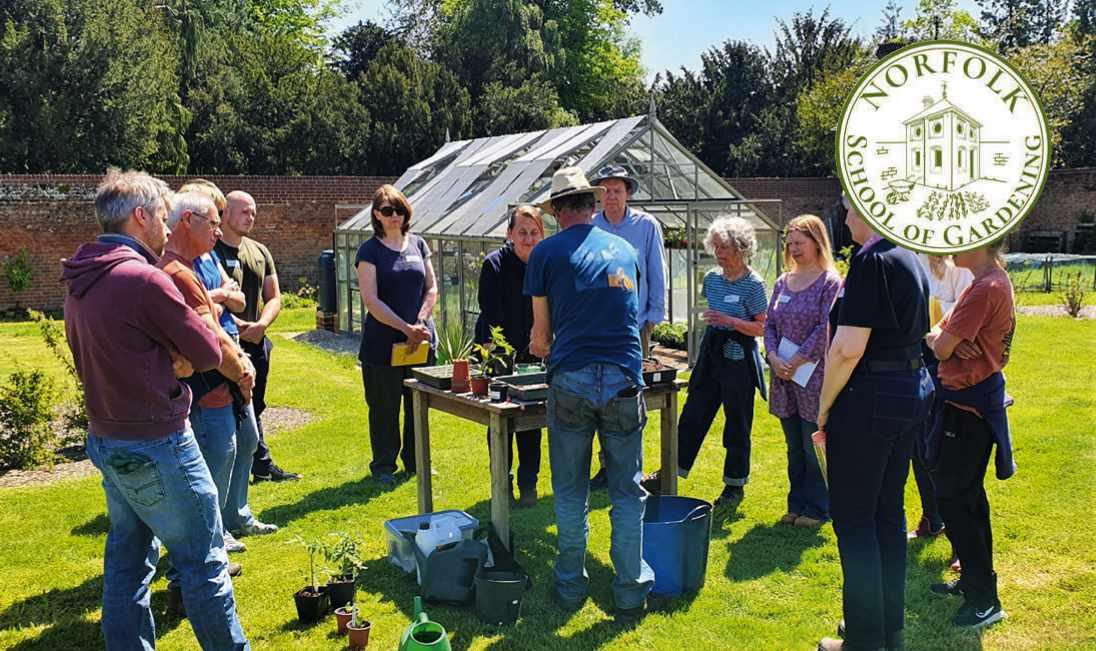
We o�er one-day courses in everything from pruning to propagation, from growing peonies to gardening sustainably, and so much more. Our long courses include the prestigious Certificate in Practical Horticulture from the Royal Botanic Garden Edinburgh and the very popular Introduction to Garden Design. We have recently launched our one-year Diploma in
Garden Design with guest tutors who are among the best designers in the world. Our class sizes are small and our outstanding tutors have huge and varied experience across horticulture.

info@norfolkschoolofgardening.co.uk norfolkschoolofgardening.co.uk @norfolkschoolofgardening
“I could not be more impressed with the quality of organisation, teaching and overall welcome that is so central to the Norfolk School of Gardening ethos.”
“The tutors have incredible depth of knowledge and never tire of answering the huge range of questions.”
“Whatever your aim, whether to get more from your greenhouse, learn how to prune your roses or develop green fingers – you will achieve it here.“
EDUCATION GUIDE
Image: Lizzie Harper
John Horsey Horticulture
Our very successful Diploma in Horticulture, which we have been running at Burrow Farm Gardens, will now be available on-line with regular face to face Zoom tutorials.
The course is based on a lifetime in Horticulture and, as requested by students, covers a much wider range of topics with a special emphasis on plants. It is ideal for those starting in the industry, career changers and those just interested in their gardens and horticulture.
johnhorseyhorticulture.co.uk | 01460 68905
START YOUR CAREER CHANGE HERE...
RHS THEORY AND PRACTICAL COURSES AT
THE UNIVERSITY OF BRISTOL BOTANIC GARDEN
Booking soon for courses starting Autumn 2023.
Study part-time, daytime or evening with experienced tutors.
For further details: botanic-garden.bristol.ac.uk
� 0117 428 2041
� botanic-gardens@bristol.ac.uk
LEARN MORE ABOUT YOUR GARDEN...
�e Plant School
Combining people who love their plants with knowledgeable professional enthusiasts who are keen to share their interest in plants. We aim to develop a deeper understanding of how plants prefer to grow and recognise how they interact with their surroundings.

The Plant School is the leading independent provider of education for students wanting a grounding in plant knowledge – all the courses are focused on learning about plants and trees with lectures by leading plantsmen. Courses have been


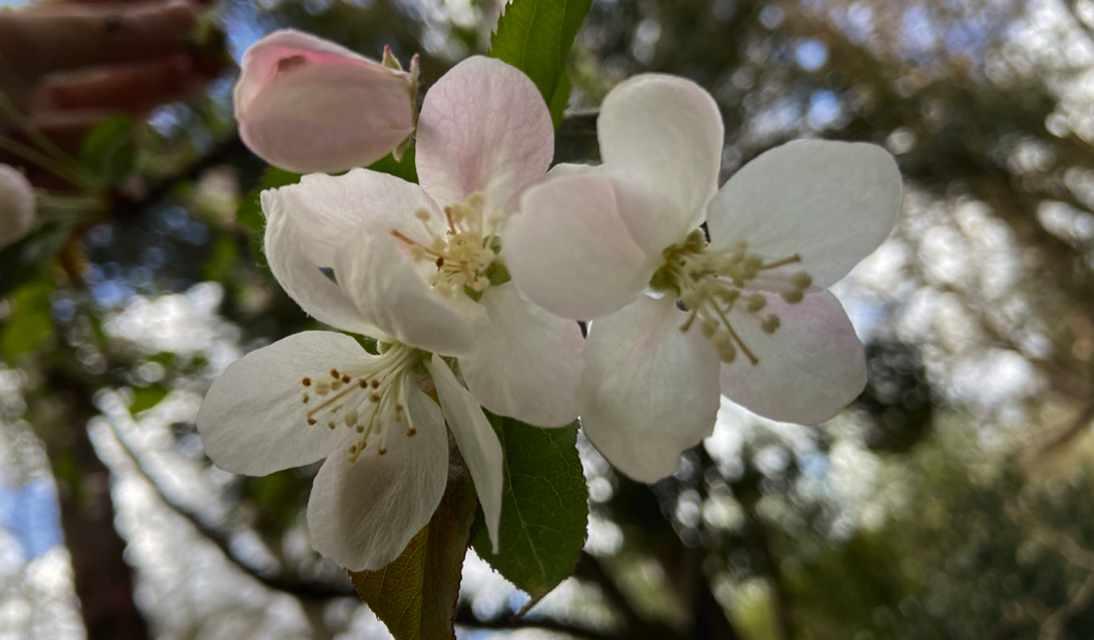
running for many years and cover the theory and practise of plants and their origins, from how to identify them to choosing the best species and cultivars for our gardens. This is covered by expert lecturers topped up with visits to plant collections.

• All courses run through the Academic Year. Ten days across ten months (September – June)
• Carefully chosen coursework
• Predominately London based
TEN-DAY COURSES
The Plant Course, The Tree Course, The Specialist Plant Course. Dependent on course, timetable includes visits to Kew, The Savill Garden, The Chelsea Physic Garden and The Garden Museum. Now taking bookings for September 2023 intake.

@theplantschool
theplantschool.com
ADVERTISEMENT FEATURE
Book reviews, the crossword, competition and Alice Vincent

FEBRUARY 2023 GARDENSILLUSTRATED.COM 103 DOWNTOOLS INDIA HOBSON/HAARKON Discover how to combine seasonal flowers and foliage in beautiful and unfussy arrangements, in florist Anna Potter’s new book, Flower Philosophy, reviewed on page 104.
BOOK REVIEWS
TOUGH PLANTS FOR TOUGH PLACES: INVINCIBLE PLANTS FOR EVERY SITUATION
 by Sharon Amos
by Sharon Amos
Pimpernel Press, £20
ISBN 978-1914902017
plant in the right place. Reviewer Rosy Hardy is a plantswoman and nursery owner.
Few gardens benefit from perfect growing conditions – all of us have areas that are dry, damp, exposed and so on. These trickier areas need plants that will not only survive but thrive there, and this book aims to help gardeners choose them.
Although aimed at beginners, it contains advice that all gardeners would benefit from a recap of. The most important starting point in any garden is the soil, and there’s good sensible advice about soil identification and soil improvement strategies. After this you should look at the environmental factors that will drive your planting choices, such as sun and shade. This is all well explained in an easy-to-read writing style.
This book allows you to follow easy steps, giving enough information without overload or complication to help you make correct plant choices. Included in the advice is the use of plastic membranes. I’m not a fan of these as membranes can cause more problems down the line,
and it’s better if we all use less plastic. However, there is good information to help with planting and establishing plants in new beds, and this is explained in an easy guide.
Once you move to the directory section, you’re able to jump straight to the plant suggestions for the conditions you’re dealing with in the garden, such as an exposed or coastal site. This isn’t an exhaustive plant list but this guide will help the beginner to avoid plant losses.
Overall, I liked the dual referencing of plants for the various conditions and growing preferences, such as sun, shade and so on. But, once you start looking at the individual plants there are some inaccuracies – though none that would make growing the plant any less successful. The plant descriptions would be improved with consistent use of Botanical naming alongside common names, rather than one or the other.
But this a good starting point and has much to recommend it.
FLOWER PHILOSOPHY: SEASONAL PROJECTS TO INSPIRE & RESTORE
by Anna Potter
White Lion Publishing, £20
ISBN 978-0711268579
Free yourself from the pressure of achieving perfection with this practical introduction to creating arrangements of seasonal flowers.
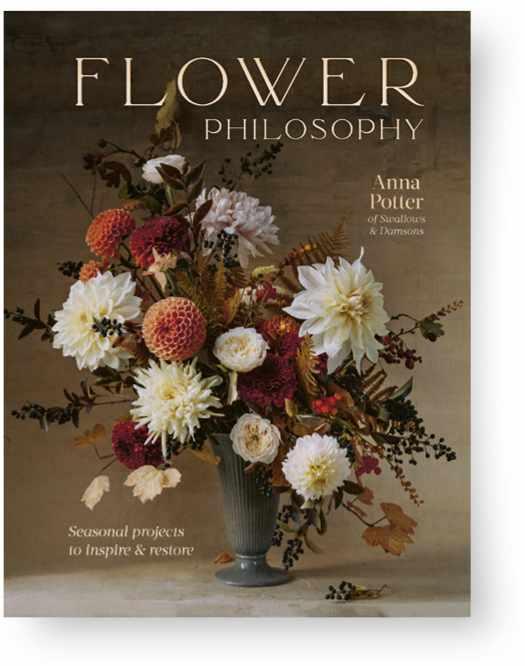
Reviewer Charlie Ryrie is a cut-flower grower and florist.
Anna Potter, the florist behind Swallows & Damsons, is known for her seasonal displays that feature not only flowers but fruit, vegetables, seashells and more. Here, she showcases her craft with varied projects including bouquets, wreaths and installations. Each combines conventional and foraged floral material, and is dramatically photographed, with a flower menu that allows readers to imitate her designs.
My favourite arrangements were those where the best seasonal blooms are placed in interesting containers with a few unexpected stems in the mix. These are universally attractive, and the flowing shapes she creates are inspiring, though it might be hard for non-florist readers to lay their hands on some of the featured flowers. Anna states her arrangements do not need to be followed slavishly, but it is often the special blooms that make them so appealing.
Projects are photographed in detail, with Anna’s favourite orange tones featuring strongly,
and the images are memorable. One shows Anna creating a large ephemeral wreath hanging between trees surrounded by a vast expanse of bracken that exactly matches the colour of her wavy hair, an image perfectly curated for social media.
Some of the seasonal designs are quite whimsical but the section on floristry basics is excellent and will be universally helpful for anyone designing with flowers. Anna’s commitment to sustainability is laudable and the pages on floral mechanics are fascinating, showing how she achieves some of her more complex constructions. The final flower thesaurus, described by the publishers as ‘unorthodox’, is more mood board than guide, but fun, with ideas for pairings, benefits to the senses and mood, meanings etc.
This book contains enough information and visual inspiration to satisfy most readers, and will delight the visually aware young florists who follow social media closely.
104 GARDENSILLUSTRATED.COM FEBRUARY 2023
A starting point to help beginner gardeners understand the constraints of their garden and succeed in growing the right
RHS COMPANION TO WILDLIFE GARDENING
 by Chris Baines
Frances Lincoln, £25
by Chris Baines
Frances Lincoln, £25
ISBN 978-0711281288
This revised and updated guide to wildlife gardening from the RHS includes advice on rewilding, along with new illustrations and projects. Reviewer Kate Bradbury is a writer specialising in wildlife gardening.
An oldie but a goodie, Chris Baines’s Companion to Wildlife Gardening was first published in 1985 and was fully revised and updated in 2016, incorporating the latest RHS research on issues, such as use of pesticides, native plants, messy areas and habitat boxes. It remains an excellent and comprehensive guide: you’ll find information on why gardens are important and specific plants to grow, along with the more general principles of wildlife gardening, such as how to recreate wetland, woodland edge and meadow habitats in gardens. There are also tips on propagation, identifying and recording wildlife, and growing food. (I was sad to see that Chris is still advocating the killing of large white butterflies, however, despite acknowledging that they mostly lay eggs on nasturtiums.)
The 2016 revision also featured a new chapter entitled Over the Garden Wall, where readers were encouraged to see beyond their gardens, assessing local green spaces, mapping nature networks, recording
Other books
What else to read this month, from a useful guide to botany to a celebration of Europe’s most useless structures.
A GARDENER’S GUIDE TO BOTANY by Scott
 Zona
Zona
Cool Springs Press, £22
ISBN 978-0760374450
The science behind what makes plants tick, delivered in simple terms. Suitable for advanced gardeners, novices, and houseplant owners.
GROUNDED
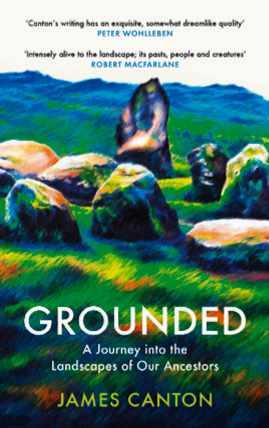 by James Canton
by James Canton
Canongate, £18.99
ISBN 978-1838855871
wildlife and campaigning against their loss, particularly in cities. Now, for 2023, this last chapter has been rewritten to include information on rewilding and nature recovery, alongside original tips on how to plan and present an argument to councils who are – at least supposed to be –taking biodiversity and green spaces more seriously these days. This puts a more positive slant on a chapter that was formerly a touch depressing, as it now focuses on the power of communities and of nature itself to heal, rather than the scourge of lawnmowers, bad tree planting and spraying of caterpillar food plants.
As ever, this book remains relevant, useful and engaging. The images are beautiful (most remain unchanged since the 2016 update), and it should be on the bookshelf of every gardener, not just those with a particular interest in wildlife. However, if you already have the 2016 revised version, I don’t think you need to replace it with this one.
James Canton takes us on a journey through England, seeking to understand what landscape meant to those who came before us.
ORCHID MUSE
by Erica Hannickel
WW Norton & Company, £25
ISBN 978-0393867282
Historian Erica Hannickel brings together fascinating tales of orchid obsessives throughout history, and o�ers tips on how to grow your own orchids at home.

REKHA’S KITCHEN GARDEN by Rekha
 Mistry
Mistry
Dorling Kindersley, £18.99
ISBN 978-0241558362
The BBC Gardeners’ World regular shares advice gleaned from her more than 30 years of growing, with tricks and tips on how to grow over 40 seasonal crops.
THE STORY OF FOLLIES by Celia Fisher

Reaktion Books, £35
ISBN 978-1789146356
A guide to these fanciful buildings in Britain, Ireland and beyond, placing them in their historical, social and architectural context, and examining their relevance for today.
FEBRUARY 2023 GARDENSILLUSTRATED.COM 105
Rewards PROGRAMME
Brighten these dark winter days with the fantastic o � ers available through the Gardens Illustrated Reader Rewards scheme
SAVE 20%
HOW IT WORKS
1Browse
Take a look at some of our latest fantastic o�ers, covering gardening, lifestyle, travel, food and drink, and more.

2 Redeem
Follow the link provided in each o�er and apply the o�er code when placing your order.
3 Find even more
Go to gardensillustrated.com/o�ers to find the full range of discounts, deals and competitions available to you.
THE PERFECT TIME TO PLAN
Make the most of dark winter days and cosy up with Create Academy’s huge selection of gardening courses that will help you achieve your garden goals for the year ahead. Learn how to plan more successfully, grow more productively and become better custodians of the land with Create Academy’s beautiful online courses taught by pioneering gardeners, horticulturists, organic farmers and florists. Discover how tuning into the seasons, nurturing biodiversity and embracing low intervention practices can enrich your life, and the lives of others. Whether you’re considering retraining, seeking inspiration or simply want to learn new skills, Create Academy’s courses will grow your knowledge and connect you with the magic of nature.
Use code GARDENS20 when booking your course at createacademy.com
To browse our full selection of o�ers, go to gardensillustrated.com/o�ers
The Land Gardeners
Arthur Parkinson
106 GARDENSILLUSTRATED.COM FEBRUARY 2023
Dan Pearson
Give yourself something to look forward to when you book a fantastic UK break with Parkdean Resorts. Whether you want to go on holiday in the next few weeks or you’re planning ahead to later in the year, you can enjoy 10% o� spring, summer and autumn breaks, and 5% o� during school holidays and bank holidays. Parkdean Resorts has 66 sites across the country and o�ers a range of accommodation options, from cosy lodges perfect for a romantic weekend to family-friendly caravans and glamping.

UP TO 10%

To browse our full selection of o�ers, go to gardensillustrated.com/o�ers REDEEMING YOUR OFFER Visit parkdeanresorts.co.uk/partnerships/ parkdean-rewards/ and use code GARDEN44 to claim your discount
FEBRUARY 2023 GARDENSILLUSTRATED.COM 107
Get away from it all SAVE
PRINT VERSION
You can buy printed issues of the magazine published up to six issues ago at buysubscriptions.com or see below for details.
DIGITAL VERSION
Save money when you subscribe to the digital edition –see page 22
CLOTHBOUND SLIPCASES
Cost from £9.99 each (inc p&p). Subscriber discounts available – see below for details.
TO ORDER PRINTED COPIES OR SLIPCASES
ACROSS
1 Wall-trained fruit tree that branches out? (8)
6 The Japanese laurel genus is … ‘Gold Caribbean Island’ (6)
GARDENS ILLUSTRATED PRINTED ISSUES ORDER FORM


Complete this form and send to: Gardens Illustrated, Back Issues, PO Box 3320, 3 Queensbridge, Northampton NN4 7BF (You may photocopy this form).
SINGLE ISSUES
I would like to order copy/copies of issue(s)
SUBSCRIBERS NON-SUBSCRIBERS
n UK – £5.29 per copy
n EU – £5.99 per copy
n UK – £6.49 per copy
n EU – £7.49 per copy
n Rest of world – £6.99 per copy n Rest of world – £8.49 per copy
CLOTHBOUND SLIPCASES
I would like to order slipcase(s)
SUBSCRIBERS
n UK – £8.49 each
n EU – £9.45 each
n Rest of world – £10.80 each
NON-SUBSCRIBERS
n UK – £9.99 each
n EU – £10.50 each
n Rest of world – £12 each
Postage & packaging is included in all prices.
PAYMENT DETAILS
n I enclose a cheque/international money order made payable to Our Media Ltd for £
n I would like to pay by credit/debit card, please debit my card
Visa n Mastercard n
n n n n n n n n n n n n n n n n
Expiry date n n n n Issue no. (if shown) n n
Signature Date / /
YOUR DETAILS
Title Forename
Surname
Address
Post/Zip code
Daytime tel no.
Email address
Subscriber number (if applicable)
KEEP IN TOUCH
Gardens Illustrated (published by Our Media Limited) would like to send you updates, special o�ers and promotions by email. You can unsubscribe at any time.


Please tick here if you would like to receive these n
We would also like to keep in touch by post and telephone about other relevant o�ers and promotions from our publisher Our Media Limited. If you’d rather not be contacted this way please tick here post n phone n .For more information about how to change the way we contact you, and how we hold your personal information, please see our privacy policy, which can be viewed online at policies.immediate.co.uk/privacy
9 Shallow container for eg germinating seeds (4)
10 Produce from a kitchen garden? Give up! (5)
11 After cabbage, it’s a Cordyline tree (4)
12 Twiggy broom, not a garden plant! (5)
14 Gladiolus with red-edged, yellow flowers, named after US city – makes salsa veg! (3,5)
15 A pink, double-flowered camellia –‘Hail Mary’? (3,5)
17 Horsetail (Equisetum arvense) is a living one (6)
18 Bits of garlic bulbs cook initially adores (6)
20 The quince genus – I can do mutation around end of February (7)
22 Grow in size – mushroom? (8) 23/4 down Another name for houseplant Epipremnum (pothos) –Old Nick’s hedera (6,3)
26 A small, named narcissus … a tiny garden pest! (4)
27 A dark pink Twyning dahlia – make merry! (5)
29 Rich soil mix of sand, clay and organic matter (4)
30 Large shrub rose with creamy white, semi-double flowers – shown in Geneva database (6)
31 A common name for plant in Leonotis genus – near soil disturbance (5,3)
DOWN
2 Woody plant – right in the middle of damaged bush (5)
3 Rockery plant, Lobularia genus –transforms slum, say (7)
4 See 24 across
5 Genus of plants with petunia-like flowers – I put in laurel arrangement (7)
6 Odontoglossum orchids hail from this mountain range (5)
7 Leylandii is a fast-growing form (7)
8 Species name of eg Arenaria, signifying plant comes from a Spanish archipelago (9)
13 The mulberry genus – moisture initially spoilt ours (5)
16 Light yellow sunflower with a dark centre, for a February sweetheart (9)
17 Lost colour like a dying flower (5)
19 Genus of plant commonly called vervain – in clover, Ben admitted (7)
20 Parsley-like aromatic herb, genus Anthriscus (7)
21 Galanthus ___, the common snowdrop – snail, sadly, consuming four (7)
23 Term describing golden variety, eg of Scots pine (5)
25 Woody, usually tropical, climbing plant – anil, maybe, includes one (5)
28 A late-cropping raspberry found in Brogdale orangery (3)
SOLUTIONS TO JANUARY CROSSWORD

BUYING BACK ISSUES OF
"
U N I T E D K I N G D O M UNITED KINGDOM 0 3 3 3 0 1 6 2 1 14 03330 162114 O U TS I D E U K OUTSIDE UK + 4 4 1 6 0 4 97372 2 +44 1604 973722
ACROSS 1 Marjoram 6 Seseli 9 Russet 10 Rousham 11 Perianth 13 Purple 14 Fuego 15 St George 17 Scorpion 20 Nepeta 22 Offset 24 Iceberg 26 Lateral 27 Basket 28 Sahara 29 Alyssum. DOWN 2 Azure 3 Jasmine 4 Rot 5 Myrrhis 6 Stump 7 Scherzo 8 Limelight 12 Naomi 14 Ficifolia 16 Genie 18 Rosetta 19 Neillia 21 Presses 23 Tyria 25 Gleam 27 Bay. Crossword • Solutions to this issue’s crossword will be printed in the March issue
WIN A LUXURY STAY FOR 2
WIN Two nights for two at Middlethorpe Hall

Middlethorpe Hall, the only country house hotel in the city of York, is the perfect base to combine both a country and city experience. Set within 20 acres of its own award-winning gardens and parkland, the beautiful William and Mary house was formerly the home of the famous 18th-century writer and poet Lady Mary Wortley Montagu (1689-1762), who is best known for her letters describing her travels to the Ottoman Empire with her ambassador husband. It was also home to Fanny Rollo Wilkinson (1855-1951), the first woman to make a professional career as a landscape gardener in the UK, and a Civic Trust blue plaque marking her achievement was unveiled in the walled garden last year.
The gardens at Middlethorpe Hall have much to explore. There are many specimen trees within the grounds, an enchanting walled kitchen garden, including a mellow brick Dovecote, dating back to 1681 and rescued from dereliction in 1980 and now used as a wine cellar. Other features include the Rose Garden, walled White Garden, Spring Garden and a lake surrounded by a glade of trees.
The hotel itself offers 29 bedrooms, an award-winning restaurant and boutique spa. Each of the bedrooms at Middlethorpe Hall is individually designed and has its own distinct story. The classically panelled dining room provides the perfect setting to enjoy the two AA Rosette restaurant.
THE PRIZE
• Two-night stay for two at Middlethorpe Hall in a main hall room.
• Three-course dinner for two on one evening.
• Afternoon tea for two on one afternoon.
• Daily breakfast.
• A 25-minute spa treatment each and use of the spa facilities throughout the stay.
• A short, guided tour of the gardens followed by coffee or tea.

HOW TO ENTER
For your chance to win, answer the following question:
What’s the name of York’s historic shopping street, which dates back to Roman times?
a) The Shambles
b) The Muddle
c) The Jumbles
Enter online at gardensillustrated.com/middlethorpe
Closing date 11.59pm, 28 February 2023.
Terms and conditions apply*
TERMS AND CONDITIONS
Entrants must be UK residents, aged 18 or over. Prize is based on two guests sharing a double or twin bedroom. Valid for stays over a 12month period from March 2023, excluding the Easter, Christmas and New Year (21 December 2023 – 6 January 2024), Valentines and Bank Holiday periods. Three-course dinner for two on one evening excludes drinks, which can be purchased. Afternoon tea for two on one afternoon excludes alcohol, which can be purchased. Daily breakfast for two. A 25-minute spa treatment per person and use of the spa facilities throughout your stay. A brief guided tour of the gardens followed by coffee or tea in the hotel. Full terms and conditions can be found at gardensillustrated.com/middlethorpe
In 2008, Historic House Hotels Ltd and all its interest in the three Historic House Hotels (Hartwell House, Bodysgallen Hall and Middlethorpe Hall) became the property of the National Trust, by donation, with all profits henceforward benefiting the houses and the charity. middlethorpe.com
MIDDLETHORPE HALL
now to win a mini-break for two at historic Middlethorpe
York FEBRUARY 2023 GARDENSILLUSTRATED.COM 109
Enter
Hall in
COMPETITION
Spectacular snowdrops
Make time in the new year to visit this collection of stunning gardens

1FULLERS MILL
This award-winning enchanting and tranquil plantsman’s garden offers unusual shrubs, perennials, lilies and marginal plants along with over 100 varieties of snowdrop for you to enjoy. Experts from local nurseries and gardens will be on hand to answer your snowdrop-related questions.
West Stow IP28 6HD | fullersmillgarden@perennial.org.uk | fullersmill.org.uk
2YORK GATE
Discover the outstanding snowdrop displays in this wonderfully inspiring magical one-acre garden. Each of the unique ‘rooms’ offers a beautiful display in one of the country’s finest small gardens. Before you leave, treat yourself to a wholesome home-made meal in our café, and visit our gift shop. Leeds LS16 8DW | yorkgate@perennial.org.uk | yorkgate.org.uk
3THE LASKETT
Explore our innovative display of snowdrops in one of the most remarkable and inspirational gardens in England. Created by Sir Roy Strong CH the snowdrops add a winter display to an already stunning garden set in the idyllic Herefordshire countryside.

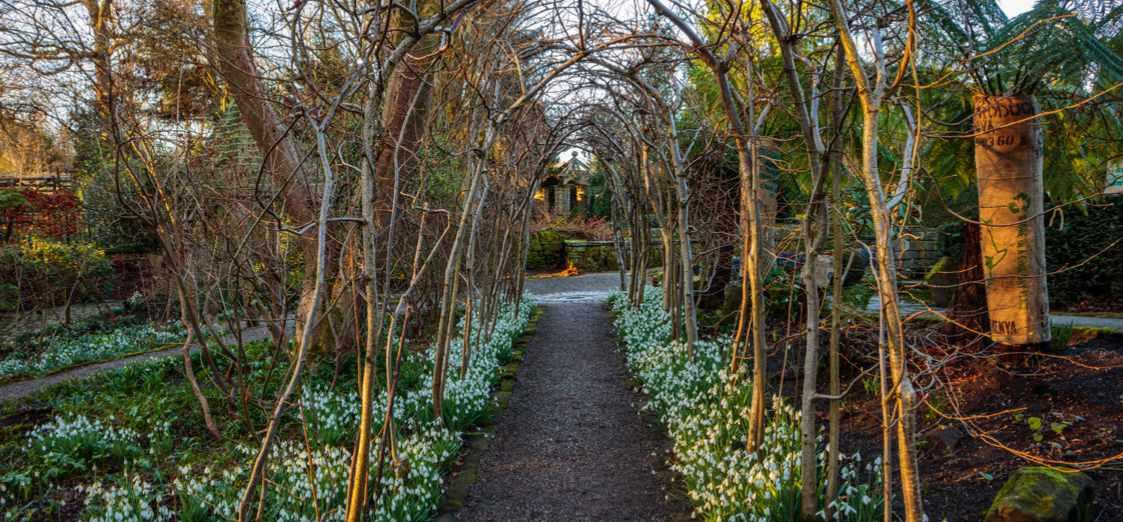

Much Birch HR2 8HZ | thelaskett@perennial.org.uk | thelaskett.org.uk

4ANGLESEY ABBEY, GARDENS AND LODE MILL
Join us to celebrate our Winter Garden as it comes into season, bringing colour, scent, and texture to the colder months. Anglesey Abbey has one of the finest collections of snowdrops in the country, with over 300 varieties. Discover our private collection on an exclusive Specialist Collection tour.
Cambridgeshire, CB25 9EJ | 01223 810080 | angleseyabbey@nationaltrust.org.uk
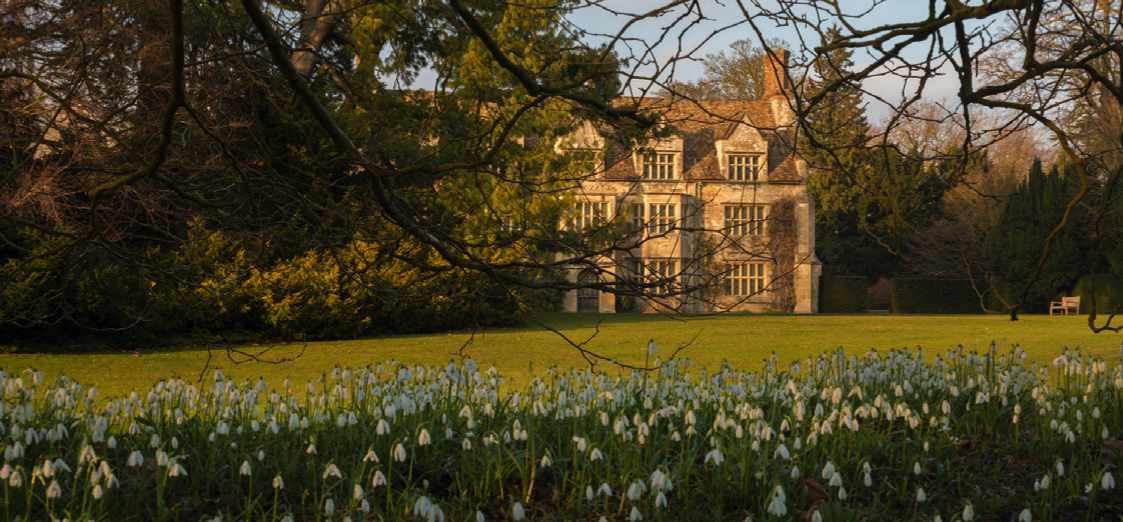
5CHIPPENHAM PARK
Large formal and woodland gardens set around lakes and ancient canals, boasting spectacular displays of snowdrops and aconites in February followed by a succession of hellebores, scillas, cyclamen, iris, daphnes, viburnums and a crescendo of daffodils. RHS Partner Garden. 21 January – 2 April, 10am-4pm. Chippenham, Ely, Cambs CB7 5PT | 01638 721416 | chippenhamparkgardens.co.uk
ADVERTISEMENT FEATURE
1
©Richard Bloom
2
©Clive Nichols
3
©Richard Bloom
©National Trust Images/Justin Minns
4
5 6 7 8 9 10 11
6WATERPERRY GARDENS
Celebrate Snowdrop Season and the first signs of spring, with over 60 different snowdrop varieties carpeting the ornamental gardens over the season. Come and enjoy a walk around the gardens to see these little heralds of spring in a magical setting. A place to explore, relax, and shop in beautiful surroundings all year round.
Nr Wheatley, Oxfordshire OX33 1LA | 01844 339226 | waterperrygardens.co.uk
7RODE HALL & GARDENS
Enjoy one of the UK’s finest Snowdrop Walks to mark the start of spring. A beautiful, end-of-winter walk for all the family with a wonderfully diverse landscape, and more than 70 varieties of snowdrops. Home-made cakes and lunches served in the delightful courtyard kitchen. Tickets available online. Scholar Green, Cheshire ST7 3QP | 01270 873237 | rodehall.co.uk
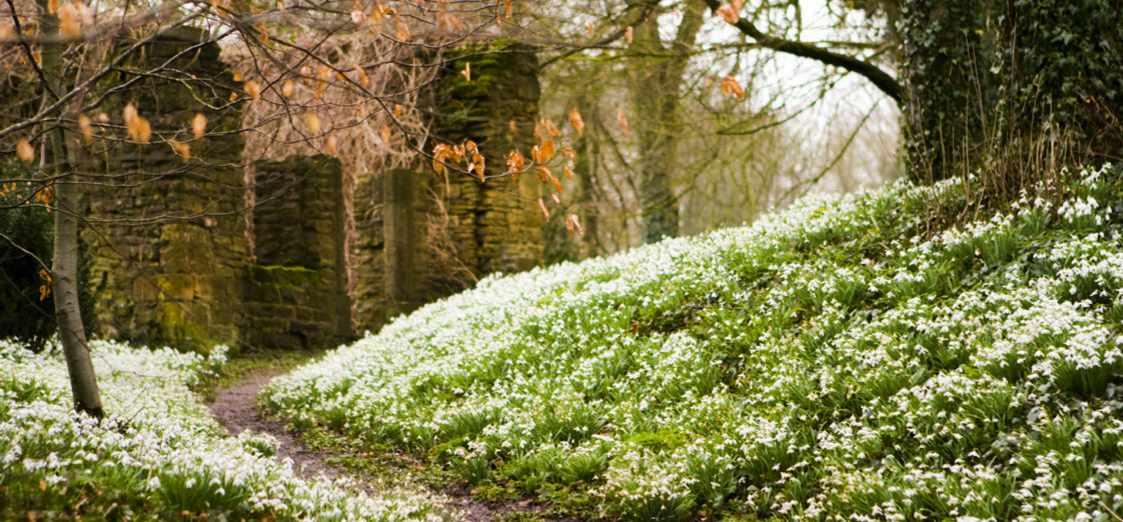
8CERNEY HOUSE GARDENS
Cerney House gardens is a romantic English garden, with a beautiful secluded, Victorian, walled garden. The late-winter season features snowdrops and hellebores. Enjoy our woodland walk and nature trail, and discover our medicinal herb garden and children’s trail. Dogs welcome.
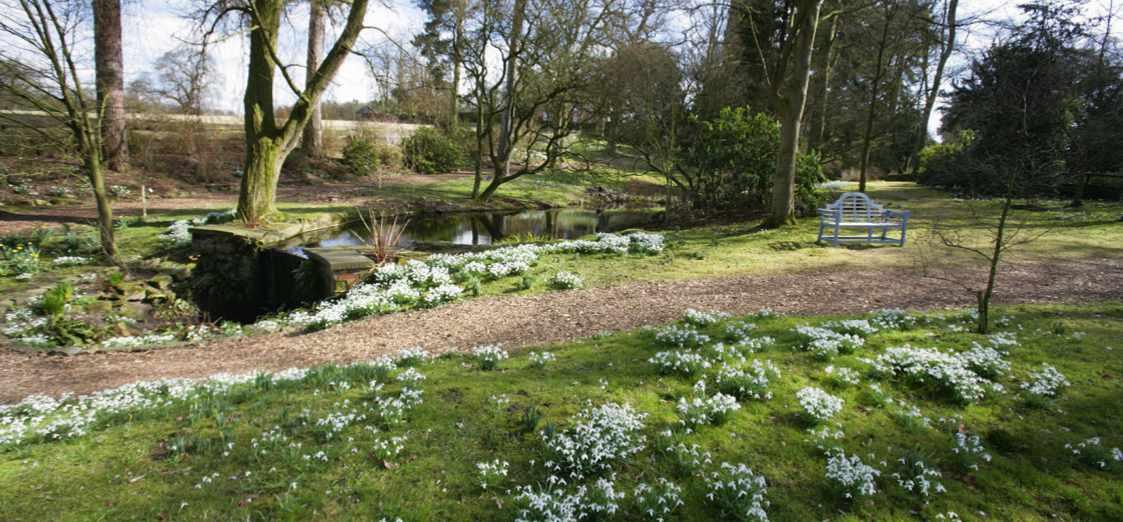
North Cerney Cirencester GL7 7BX | 01285 831300 | cerneygardens.com
9SHEPTON SNOWDROPS FESTIVAL


So much to see. So much to do. Specialist growers and nurseries – snowdrops, hellebores, climbers, plants for spring and for shade; exquisite craft by Somerset’s finest makers; workshops in willow, wire, ceramics and spring flowers; snowdrop walks; Sunday ramble; talk by international bee expert; open gardens. 15 -19 Feb 2023. pr@sheptonsnowdrops.org.uk | 07714 783009 | sheptonsnowdrops.org.uk
10CHELSEA PHYSIC GARDEN
This year, alongside our annual Snowdrop Trail, you can also follow the trail for A Dash of Lavender: Celebrating LGBTQ+ History Month with Queer Botany (1-28 February 2023), which highlights the important role members of this community have played in horticulture. Follow the trail, or join a workshop or talk. 66 Royal Hospital Road, London SW3 4HS | chelseaphysicgarden.co.uk

11NATIONAL TRUST CLUMBER PARK
Our 3,800 acres of parkland provide the perfect backdrop for relaxing, exploring and spending time in nature over the winter months. Clumber Park is steeped in history, with clues to its grand past dotted throughout including a four-acre, 18th century, walled, productive, kitchen garden. Nottinghamshire S80 3BE | 01909 476592 | nationaltrust.org.uk/clumber-park

ADVERTISEMENT FEATURE
©
Steve Bradley






SPECIALOFFERFOR � �READERS ISSUES FOR JUST £20* Celebrate our 200th issue with a subscription to BBC Countryfile Magazine! †Calls from landlines will cost up to 9p per minute. Call charges from mobile phones will cost between 3p and 55p per minute but are included in free call packages. Lines are open 8.00am – 8.00pm weekdays and 9.00am – 1pm Saturdays. *10 issues for £20 o� er is only available to UK residents paying by Direct Debit. After your first 10 issues your subscription will continue at £22.99 every six issues, saving 30% o� the shop price. If you cancel within two weeks of receiving your ninth issue you will pay no more than £20. BBCCountryfileMagazine is published 13 times a year. Your subscription will start with the next available issue. O � er ends 1 April 2023. SUBSCRIBE ONLINE OR CALL US www.buysubscriptions.com/CF2023GI 03330 162112† Quote code CF2023GI �MAGLOGO Hurry! O �er ends 1st April 2023
MARCH
• Discover an exquisite camellia collection in Essex
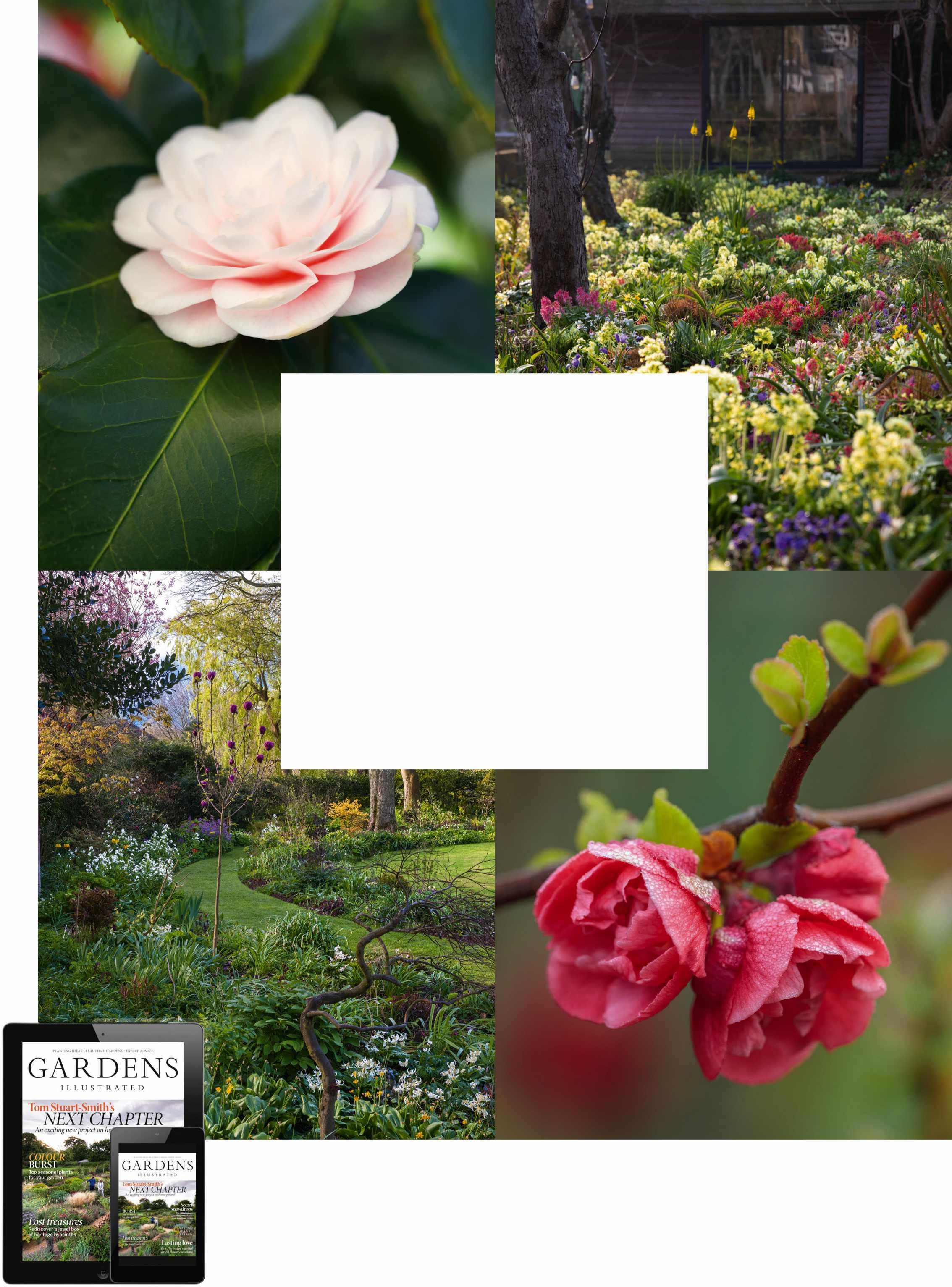
• Create a vivid swathe of springtime flowers – with ideas from James Hitchmough’s own garden
• The best Chaenomeles to grow for seasonal colour
• A masterful spring tapestry in an elegant Lancashire garden that has been tended over a period of 20 years
• Garden design insight from Andy Sturgeon
• Meet Janis Ruksans, the king of crocus
ON SALE 1 MARCH
Save money when you subscribe to the digital edition – see page 22. Also in selected Waitrose, Sainsbury’s and Tesco stores, as well as WHSmith, and all good magazine retailers.
FEBRUARY 2023 GARDENSILLUSTRATED.COM 113
ANNAÏCK GUITTENY, RICHARD BLOOM, CLIVE NICHOLS, ANDREA JONES
HOME TRUTHS
Winter is a sad time for the subtropical plants with which we choose to share our homes, but Alice Vincent offers some simple ways to keep houseplants happy and healthy
ILLUSTRATION ALICE PATTULLO
My mother has started to text me about houseplants. After 34 years of my varying dependence on her for sustenance, comfort, wisdom, reliable last-minute dinnerparty recipes and occasional fancy dress solutions, it’s the very least I can do. I receive photographs of her ever-growing houseplant collection and reply with comments such as “looks fine, you should probably pot it on in the spring”; she fields endless queries about Joni Mitchell LPs and the Facebook marketplace economy of Tunbridge Wells.
When she came over for lunch in late November I sent her packing with a 1m-tall variegated Ficus elastica. This may seem generous – food and plant-based gifts – but what I didn’t let on was that she was doing me a massive favour. The thing had to go. I’ve been gradually whittling down my houseplant coterie in recent years, having learned that doing so before the winter means something other than the compost benefits from this passing on. Mum is retired, and lives in a nice, warm, lightflooded modern house. I am frequently so busy that I eat cereal for dinner and live in a split-level Victorian flat in south London. I know by whom I’d rather be looked after.
Winter is not an easy time for houseplants. These often subtropical species, used to growing many times larger in their natural habitats, ideally like warm, humid air and access to natural light. While they will manage to put on growth during the British spring and summers, the cooler, darker months offer far less satisfaction. Central heating dries out the air and can make rooms too warm, causing brown, crispy foliage. Draughty windows let in chilly breezes, resulting in frozen tender plants, and plummeting temperatures can spell fatality in cool rooms overnight. Throw in the near-absence of bright days and it’s hardly surprising houseplants can be inclined to give up the ghost.
There are ways to remedy this. Giving them daylight, and getting them away from a radiator or underfloor heating, is the most crucial. Nearly all my houseplants are gathered around the large, south-facing bay window in the living room, the best spot in the place for natural daylight. Things tend to get a little crowded if I’m overwintering pelargoniums, starting off seedlings or coddling cuttings there too – I’ve deployed a 1950s tea trolley for the purpose, which makes them easy to move. If a Christmas tree turns up, the houseplants have to lump it for a few weeks.

Generally speaking, most houseplants will retreat into a kind of seasonal dormancy at this time, responding to the less clement conditions by slowing down growth and riding it out until things brighten up. I tend to measure my houseplant maintenance by the movement of the clocks: when clocks go back in October, I stop feeding plants and tend to water less, although some remain equally thirsty all year round. When the clocks spring forward in March, it’s time to pot on, freshen up and start feeding and watering again.
It’s what you do around this time of year, and in the nascent spring to come, that’s most crucial. Potting on plants at the dawn of spring will give them more room to grow for the year ahead. I like these quietly positive days, when I get to make remorseful rounds of my neglected plants and apologise for shoving them out of the way for the showy hippeastrum or paperwhite daffodils that have been merrily flowering away. These ones, the survivors, are the ones I’d never pass off on an unsuspecting relative. We’ve been through too much. I dust off their leaves, cut back the faded growth and check for root rot. I praise them for their spectacular root growth in the face of adversity, and promise that this year, I’ll be better. n
114 GARDENSILLUSTRATED.COM FEBRUARY 2023




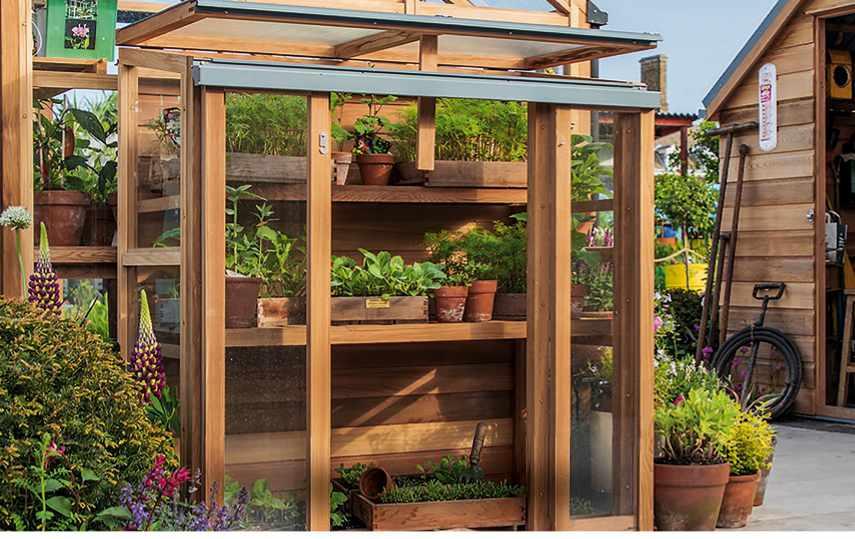
If you love your garden, you’ll know it takes time and care to create something truly wonderful. That’s why we put our faith in traditional joinery techniques such as mortise and tenon joints to give our greenhouses strength and integrity. Using only the highest quality Western Red Cedar. Handcrafted in our Cotswold workshops. No wonder Gabriel Ash are the only timber greenhouses endorsed by the Royal Horticultural Society (RHS). For a Free Brochure call 01242 662 926 or visit gabrielash.com Coldframes and Accessories available to buy online. See us at selected independent Garden Centres, RHS Gardens or our Gloucester showroom. in the Made wi� Pride Co�wolds The RHS Portico
The Baby Grand Coldframe
The Grand Coldframe
®The Royal Horticultural Society. The Royal Horticultural Society, and its logo, are trade marks of The Royal Horticultural Society. (Registered Charity No. 222879/SC038262) and used under licence from RHS Enterprises Limited.
The Upright Coldframe











































 Photographed by Richard Allenby-Pratt at Walsingham Abbey
Photographed by Richard Allenby-Pratt at Walsingham Abbey




















 COMPILED BY MOLLY BLAIR
COMPILED BY MOLLY BLAIR












































 WORDS JODIE JONES PHOTOGRAPHS RICHARD BLOOM
WORDS JODIE JONES PHOTOGRAPHS RICHARD BLOOM









 Dicentra ‘Stuart Boothman’ Another cross between D. eximia and D. formosa, with very narrow and delicate glaucous-blue leaflets and deep-pink flowers. Named for nurseryman Stuart Boothman. 45cm x 70cm. AGM. RHS H5, USDA 3a-9b.
JONATHAN BUCKLEY / GAP PHOTOS
Dicentra ‘Stuart Boothman’ Another cross between D. eximia and D. formosa, with very narrow and delicate glaucous-blue leaflets and deep-pink flowers. Named for nurseryman Stuart Boothman. 45cm x 70cm. AGM. RHS H5, USDA 3a-9b.
JONATHAN BUCKLEY / GAP PHOTOS














 Rows of pastel-coloured Hyacinthus orientalis, growing in Alan Shipp’s Cambridgeshire nursery.
Rows of pastel-coloured Hyacinthus orientalis, growing in Alan Shipp’s Cambridgeshire nursery.






 WORDS NATASHA GOODFELLOW PHOTOGRAPHS CLAIRE TAKACS
WORDS NATASHA GOODFELLOW PHOTOGRAPHS CLAIRE TAKACS

















































































 by Sharon Amos
by Sharon Amos

 by Chris Baines
Frances Lincoln, £25
by Chris Baines
Frances Lincoln, £25
 Zona
Zona
 by James Canton
by James Canton

 Mistry
Mistry
































